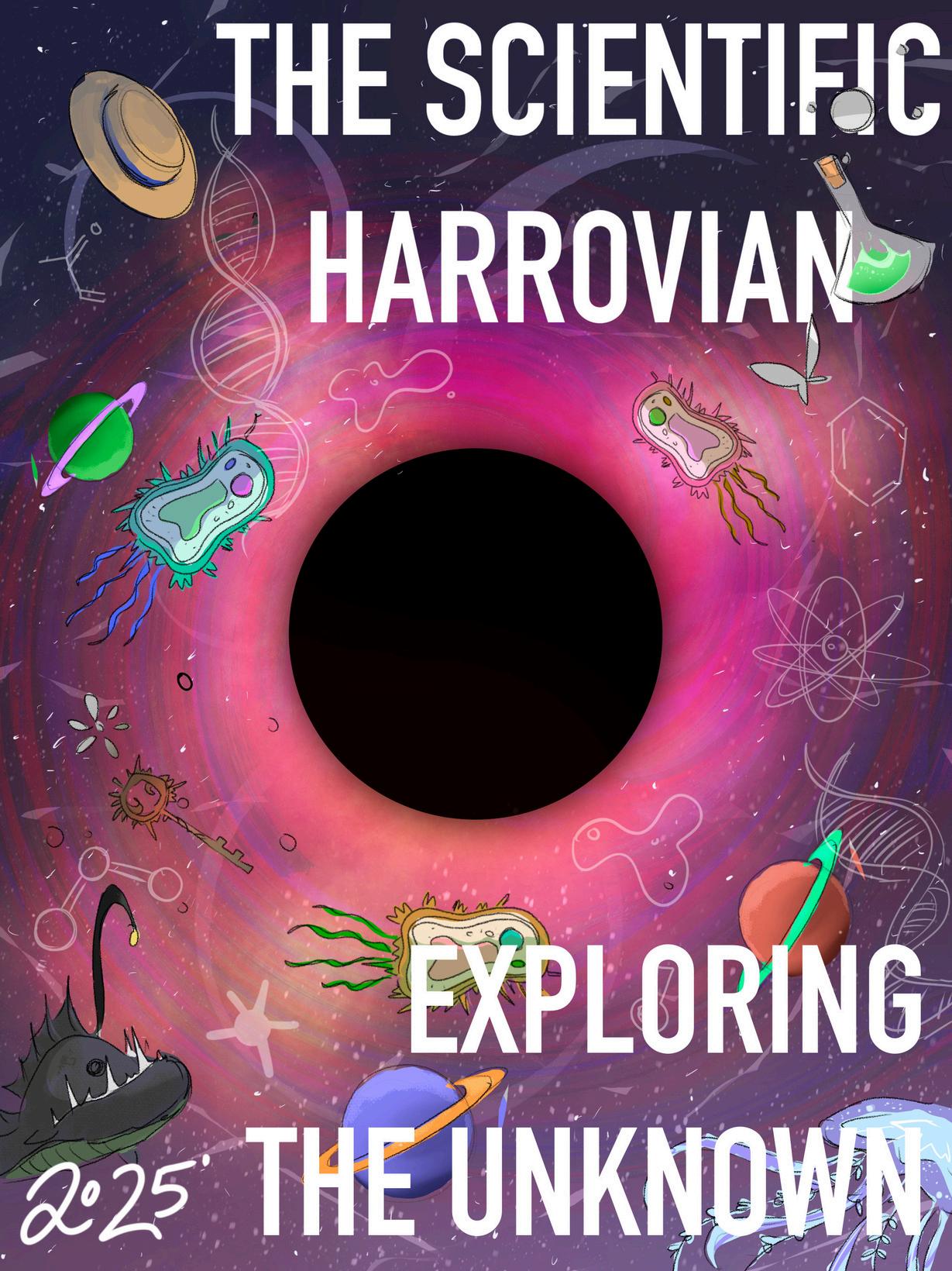

SCIENTIFIC HARROVIAN
2025
Allphotoswere sourcedviaPixabay
Thisisapupil-ledpublicationthatliaiseswithstafffromtheScience Departmenttoproducearticlesandartworkthatdelveintothe newestdevelopmentsinScience.Weaimtoinformandtoeducate ourfellowpupilstocurateinterestsinSTEMandbuildonpreexisting passions.
Amessagefrom
MSMCCROHAN

I would like to thank, and congratulate, all of the writers, editors and illustrators on the completion of this outstanding edition. You are each important cogs in the Scientific Harrovian machine: without each of you this edition simply would not have happened. The team has been run passionately by Bianca Mak, who has motivated the team to produce well-researched and wellwritten pieces across a range of subjects Thanks to the illustrators, Michelle Tse and Alicia Wan for making the edition so visually stunning. I have thoroughly enjoyed “Exploring the Unknown”. I hope everyone who picks up a copy of this Scientific Harrovian enjoys it too
Amessagefrom CurrentEditorinChief
BIANCAMAK
It has been such a pleasure to be able to collaborate with everyone in the team! It was so nice to be able to read everyone ’ s submissions. This publication would not be possible without the authors, editors, artists and most importantly Ms McCrohan, who have all dedicated their valuable time. I cannot believe that this is my last year contributing to the Scientific Harrovian I look forward to seeing it grow to become even better in the future!

HEADEDITORS

SENYIMOK
TechnologyHeadEditor

PhysicsHeadEditor


BiologyHeadEditor

MarketingDirector
BiologyHeadEditor
WRITERS
AudreyYu Year12Anderson
AliciaWan Year12Gellhorn
AmilyLuo Year9Wu
JeffreyLing Year13Peel

KathyChan Year12Gellhorn
CharlizeMui Year12Wu
PrincetonLui Year12Churchill
WesleyTang Year9Shaftesbury
JensonHo Year10Sun ArinLee Year12Gellhorn
SeanWu Year12Peel
SunnyHung Y13Sun
EDITORS
DanielKan Year13Shaftesbury
CherlyChan Year11Wu
CharlizeMui Year12Wu
SenYiMok Year13Shaftesbury
HarmonyWong Year13Anderson
AngelinaLu Year12Wu
MartinZhang Year12Peel
ARTISTS
MichelleTse Year12Wu
AliciaWan Year12Gellhorn
AshleyMak Year9Wu
BernardHo Year9Shaftesbury
SenYiMok Year13Shaftesbury
MartinZhang Year12Peel
BerniceHo Year11Anderson
AudreyLam Year13Wu
AndrewHung Year13Churchill
AudreyChung Year12Keller

IntotheMidnightZone:Dark depths,BrightlightsBioluminescenceandsurvival inthe DeepOcean
CaseStudy:Thetwoheadeddog experimentbyDrVladimir Demikhov
Unveilingrecent breakthroughsincancer
Theimpactofdietonoral health
AreLab-grownbabiesthe future?
Complicationsthatcould happenduringPregnancy
AnIntroductionToDeepSea Gigantism
ExploringtheApplicationof AerodynamicsonFormulaOne
Whatisthesignificanceofthe searchforthetheoryof everything?
ExploringtheUnknown PhysicsBehindMotion
Attophysics–Ascienceof ultrafastmatterdynamics
OriginandConsequencesof theTheoryofSpecial Relativity AIinhealthcare
TECHNOLOGY
Howcanbiomimicryinfluence robotics?
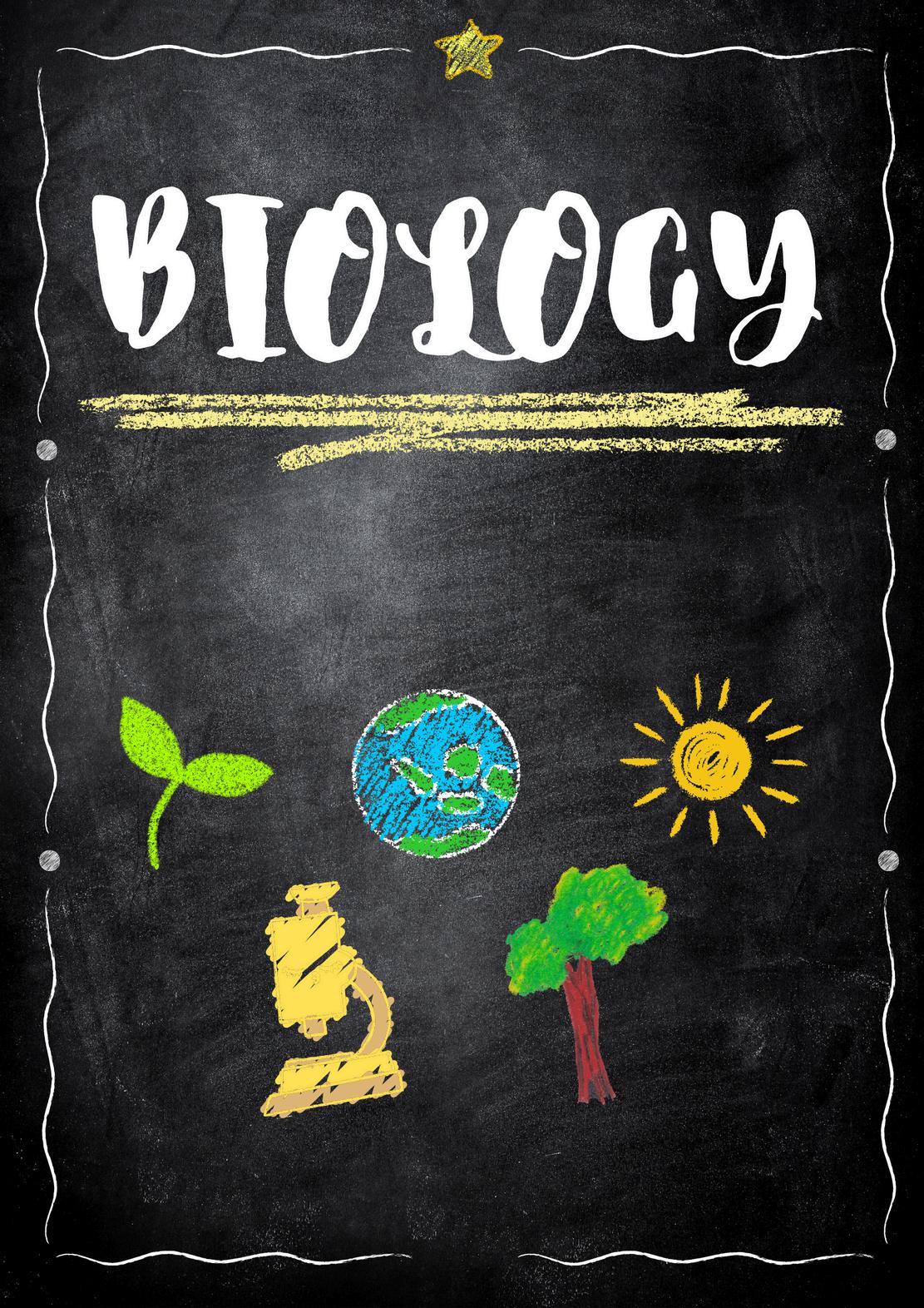
Into the Midnight Zone: Dark depths, Bright lights

Bioluminescence and survival in the Deep Ocean
by Alicia Wan
IntotheMidnightZone:Darkdepths,Brightlights Bioluminescenceandsurvivalinthe DeepOcean
Beneaththesunlitwaves,farbeyondthereachofdaylight,thereliesarealmofperpetualdarkness: TheMidnightZone.
WhatistheMidnightZone?
TheMidnightZonestretchesbetween1,000metersto4,000metersdeepintotheocean.Inthis extremeenvironment,notonlyarethereearth-crushingpressuresbutalsonear-freezing temperatures.However,lifeonearthisamazing,andmarinelifeinthisareahasadaptedin remarkableways Youmaybefamiliarwiththeghostlyglowoftheanglerfishorthebrilliantflashes ofthesquidandsiphonophores,buthaveyoueverwonderedhowtheseamazingcreaturesadapt toliveinsuchextremeenvironmentswiththenicheofbioluminescence?Thisarticleexploresthe mostuniqueandfrequentlyencounteredcreaturesoftheMidnightZone.Let’sexplorethe unknowntogether.
Whatisbioluminescence?
Bioluminescencecanbedefinedasthenaturalabilitytoproducelightindarkness.Thisnatural glowisnotonlyforshow,butalsoacriticalsurvivaltoolforcreatureslivinginthemidnightzoneto hunt,evadepredators,andcommunicate.
Thescienceofbioluminescence:Howdoesitwork?
AccordingtoNationalGeographic,Bioluminescenceis“lightemittedbylivingthingsthrough chemicalreactionsintheirbodies” Accordingtowhoiedu,bioluminescence“involvesachemical reactioninsidetheanimal’scells” Insomespecies,thespecialisedcellsarehousedin photophores Photophoresareuniquelight-emittingorgansthatcanresemblespotlights Other bioluminescentorganismscanproduceamorediffuseglow,whichilluminatestheirbodiesmore generally.
Thebioluminescentreactioninvolvestwokeymolecules:luciferinandluciferase.Whencombined withoxygen,theycanproducelight,whichcanappearinshadesofred,yellow,green,blue,or violet(thecoloursoftherainbow).However,intheocean,blue-greenlightisthemostcommonas thesewavelengthscantravelthefarthestthroughwater(Thisalsoexplainsthefactthattheocean appearsblue).Animalsregulatetheirbioluminescencebycontrollingtheflowofoxygenintothe cellsthatcancontainluciferinandluciferase.
However,notallorganismscanproducetheirownluciferinorluciferase.Someorganismsthatlive inthedeepseaacquirethesemoleculesby:
Consumingbioluminescentprey deepseashrimpandfishconsumebioluminescent planktontoincorporatethemoleculeintotheirsystem.
Relyingonasymbioticrelationshipwithbioluminescentbacteria thebacterialiveinsidethe specialisedlightorgans,wheretheyareprotectedandnourishedbythehost.Inreturn,they canemitlightattheirownwill.
Throughgenemutationsandnaturalselection Thegenesresponsibleforluciferase productionlikelyoriginatedfromrandommutationsinearlydeep-seaancestors.Thosewith alleleswhichgivethemthephenotypeofmoreefficientlightproductionsurviveand reproduce,passingtheirallelesdowntotheiroffspring,whilethespecieswhichdonot possessthephenotypeforthisgoextinct.Overtime,thespeciesevolvedmorespecialised photophores(light-emittingorgans)throughevolution.
Thereasonwhybioluminescenceissocommoninthedeepseaisduetotherebeingnosunlight inthedeepsea,whichmeansthatbioluminescenceallowsdeep-seaanimalstoseeproperlyto huntforprey
Whatbenefitsdoesbioluminescenceinthesedeepseaanimalsbring?
Bioluminescence,especiallyinwaterswherenolightispresentisextremelyhelpfulinallsortsof waysforthefish.
1Hunting
Femaleanglerfishpossessaspecialisedfleshyappendagecalledanesca.Theescaextendsfrom theirforeheadlikeafishingrod.Withintheesca,therearebioluminescentbacteriathatliveina symbioticrelationshipwiththeanglerfish.Thisallowstheanglerfishtoproduceasofteerieglow, whichactsasalure,attractingunsuspectingpreyinthecompletedarknessofthemidnightzone. Whenthefishgetsattractedtothelight,theanglerfishusesitslargeneedle-liketeethand expandablestomachanddevoursthepreywhole
2Camouflageandcounterillumination
Bothhatchetfishandlanternfishusebioluminescenceasacrucialsurvivaltool,primarilyfor camouflageandcommunicationwithinthedeepsea.Hatchetfisharenamedforhowtheirbodies arethinandreflective.Theyrelyonaphysiologicaladaptationcalledcounterillumination,which involvesproducingbioluminescentlightontheirundersidestomatchthefaintglowfilteringdown fromabove.Thishelpsthemblendseamlesslyintothebackground,whichmakesthemnearly invisibletopredatorslookingupfrombelow.
Similarly,lanternfish,oneofthemostabundantseacreaturesyoucanfindinthedeep-sea,use rowsoflight-producingphotophoresalongtheirbodiesforcounterilluminationand communication.Theyareabletocontroltheintensityandthepatternoftheirlight,whichallows themtosignalmatesordeterpredators.Somespeciesevenperformverticalmigrations,involving risingtoshallowerwatersatnighttofeedunderthecoverofdarknessanddescendingbackinto thedeepseaduringtheday Thebioluminescentadaptationgivesspecieslikethehatchetfishand thelanternfishsignificantadvantagesinavoidingdetection,findingmates,andnavigatingthedark depthsofthemidnightzone.
3Attractingmates
Bioluminescencealsoplaysacrucialroleinattractingmates.Manydeepseaspecies,includingthe anglerfish,lanternfish,andsomespeciesofsquidusespecificlightpatternstosignalpotential partners.Theflashesandpulsesoflightactasaspecies-specificcommunicationcodes,kindoflike howdolphinssqueal.Inorderforindividualstoattracttherightmates. Someorganismslikethedeepseadragonfishcanmodifytheirlightintensityandfrequencyto standoutamongcompetitors,Insomespecies,malesandfemaleshavedistinctbioluminescent patterns,whichhelpthemlocateeachotherinpitchblackdepths.
4Defenceandescape
Thevampiresquid(vampyroteuthisinfernalis) hasevolveduniquedefencemechanismstoevade predators.Unlikeit’sshallow-waterrelativesthatareabletoexpeldarkink,thevampiresquid releasesacloudofbioluminescentmucusfromthetipsofitstentacleswhenthreatened.The glowingstickysubstancecontainsnumerousparticlesoflightproducingmaterial,including luciferase,whichcreatesglowingmucuswhichcanlastuptoseveralminutes.,Thesuddenburst oflightinthedarkenvironmentallowsthevampiresquidtoescapefrompredators.Thisadaptation isparticularlyeffectiveindeep-seaenvironments.Additionally,thevampiresquidcanalsoinvertits cape-likewebbedarms,displayingspinyprojectionsinaposturethatmakesitappearlarger.
Common but unique animals found within the midnight zone
Anglerfish (Family: Lophiiformes)
Probably the most infamous creature of the midnight zone, the anglerfish is a master of deception As previously mentioned, the females have a bioluminescent lure (esca) hanging from their foreheads filled with glowing bacteria, which attracts unsuspecting prey (refer to section “what benefits does bioluminescsent bring”). The unique feature of anglerfish is that males are much smaller and fuse to females in a parasitic bond, living off their nutrients for life.
Deep-sea dragonfish (stomiidae)
Also known as the dragonfish, it has a long glowing lure to attract prey. However, its biggest advantage is, unlike other sea animals in this area, they can produce red light, which many deep-sea creatures cannot see. This allows the dragonfish to spot prey without being detected The dragonfish also has unique needle-like transparent teeth, which makes it nearly invisible in the water.
Gulper eel (eurypharynx pelecanoides)
Gulper eels have humongous expandable mouths, which allows them to inflate their mouths like balloons and swallow prey much larger than themselves While it lacks a glowing esca, it has a bioluminescent tail, which allows it to flash bright lights, distracting predators or attracting prey
Hatchetfish (Sternoptychidae)
Hatchetfish typically range from about 1 1 inches (2,8cm) to 4 7 inches (12cm) in length Despite how small they are, they are expert survivors Their bodies are covered in silvery, mirror-like scales, which allow them to use counterillumination (as previously mentioned). Their niche is that they have large upward- facing eyes that can detect even the faintest glows from potential prey.
Lanternfish (Myctophidae)
Lanternfish are one of the most abundant creatures in the deep sea Lanternfish use rows of light- producing photophores along their bodies to communicate and blend in They are crucial to the deep sea food chain, serving as a major food source for larger predators like squid and whales. Without them, there would be a big disruption to the ecosystem.
Vampire squid (vampyroteuthis infernalis)
The vampire squid is not actually a “vampire”, but a gentle scavenger However, its deep red body, large eyes, and webbed tentacles give it a ghostly, eerie look. When threatened, it ejects glowing mucus capable of bioluminescence, confusing predators (as previously mentioned). It’s unique feature is that it uses a “velvet cloak” defense, a behavioural feature where it wraps itself in its webbed tentacles to appear larger.
Comb jellies (Ctenophora)
Unlike true jellyfish, comb jellies don’t sting Instead, they move using rows of tiny hair-like cilia The cilia refract light into rainbow colours. Some species of comb jellies also produce bioluminescence, which creates mesmerising light displays. Their unique feature is that they can regenerate lost body parts.
Giant Siphonophore (Praya Dubia)
The Giant Siphonophore is one of the longest animals to ever exist on earth. This colossal organism can grow over 50 meters long. Despite its large size, it is almost completely transparent. It achieves this effect through several evolutionary adaptations Their bodies are composed primarily of a gelatinous substance with a refractive index close to that of seawater, allowing them to be nearly invisible. The transparency serves as an effective form of camouflage, serving as an exit to escape detection from predators and prey
The colonial nature of siphonophores contributes to their transparency as well Each colony consists of specialised individual units called zoids, many of which are also transparent. They collectively form a long, slender and invisible organism. This structural adaptation minimizes light reflection and shadow, which enhances their ability to blend seamlessly into the surrounding water.
Conclusion
Within the perpetual eternal darkness of the midnight zone, bioluminescence serves as a vital adaptation for fascinating deep-sea organisms. Natural light production facilitates essential adaptational behaviours such as hunting, camouflage, communication and defence. The diverse applications of bioluminescence among species like anglerfish, hatchet fish, and vampire squid underscore its significance amongst their survival strategies. Studying these luminous phenomena not only enhances our understanding of marine biodiversity but also could possibly inspire innovations in science and technology As researchers continue to explore the science and ecology behind the midnight zone, the glowing inhabitants of the deep sea illuminate the intricate and remarkable adaptations that life has developed to thrive in Earth’s deepest coldest, most challenging environments.
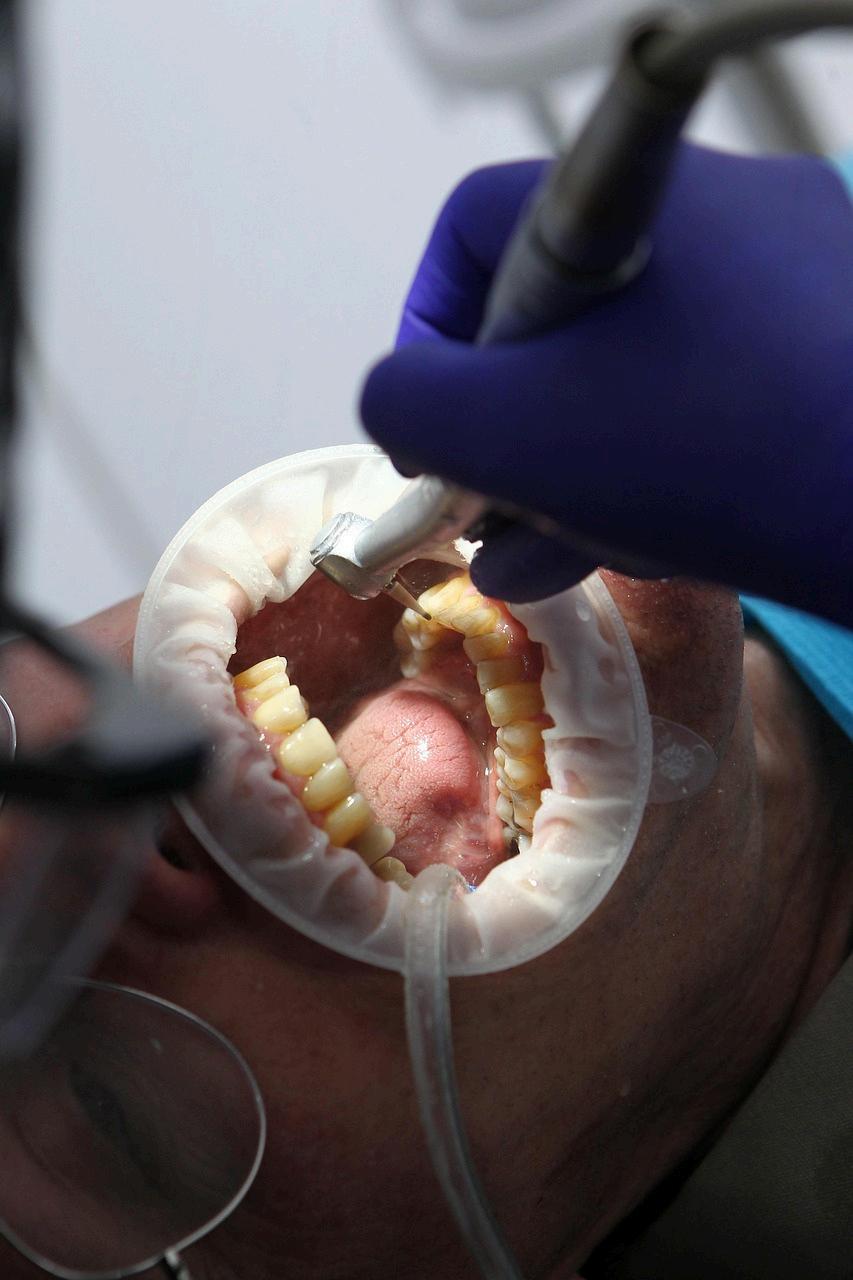
The Impact Of Diet On Oral Health
by Princeton Lui
The widespread and easy access to unhealthy food options in today’s society has led to many people struggling toprioritiseahealthydiet.Theprevalentintakeofsugarybeverages,processedsnacksandfastfoodcannotonly leadtoseverehealthconcerns,suchasdiabetesandobesity,butcanalsocausedetrimentaloralhealthissues.
Dietactsasamodifiableriskfactorfororaldiseasesandplaysamajorandessentialroleinmaintainingoralhealth. This research aims to explicate how our dietary choices and what we consume can influence the incidence of diseases in our gums and teeth. The sections below will explore the relationship between dietary factors and dentalcaries,dietarypatternsandperiodontaldiseases,anddietarysupplementationandoralhealth.
2.0Dietaryfactorsanddentalcaries
Dental caries (cavities) occur when harmful oral bacteria convert the sugar from the food and drink, we consume into acid, which damages the enamel (tooth surface) [1] In general, the enamel is made mostly out of calcium phosphate minerals which will dissolve when surrounded by acid of below 5.5 pH [2, 3], leaving a black spot on thetoothsurfacewhichlaterdevelopsintoaholeknownasadentalcavity.
Thereisadirectandclosecorrelationbetweenoureatinghabitsandtheoccurrenceofdentalcaries:
2.1Sugarconsumption
Much scientific research has confirmed that the increased consumption of sugar can lead to an escalating risk of caries development. Streptococcus Mutans is an oral pathogen that is closely linked with the formation of caries. As a fermentative bacteria, S.Mutans highly relies on dietary sugars for fermentation; this produces lactic acid as a product, reducing the pH in the oral microbiome environment [4]. As a result, this can demineralise the enamel, leadingtotoothcavities.
Evidence has shown the close connection between sugar consumption and the incidence of dental caries Research has suggested that countries with low sugar intake, – defined as less than 18kg per person per year, reported fewer cases of dental caries [5]. Furthermore, a study conducted by Koike in Kyoto, Japan aimed to examine the relation between dental caries and sugar consumption. Koike analysed the pattern of caries incidence in the first molar of 10,553 Japanese children born between 1924 and 1946 in 14 different primary schools [6]. The decade-long investigation concluded that the relationship between caries incidence and sugar consumptionwas“extremelyclose”.
The graph below shows Koike's findings, which provide clear and intelligible proof of the close correlation between sugar consumption and annual caries incidence. As seen below, the data shows an almost linear relationship indicating that as sugar consumption increases, dental caries occurrence will almost definitely increase. (Figure
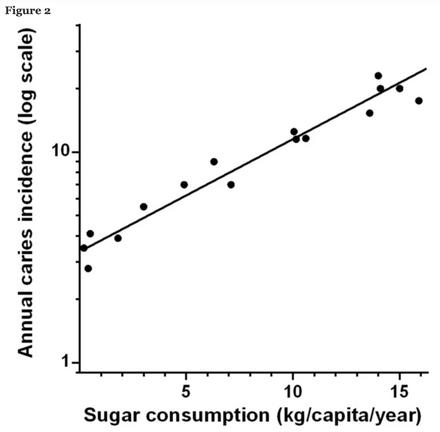
Additionally, natural sugars and added sugars can have different cariogenic potential There is evidence that suggests sugars that are naturally found in fruits, vegetables and in milk do not have a major contribution to dental caries. This is because natural sugars in these foods are usually accompanied by other protective substances such as fibre, water and calcium, which minimise effects on teeth, making natural sugar less cariogenic [7]. Moreover, fruit and vegetables stimulate mass salivary flow and production, which acts as a natural defence against the harmful impacts of sugar
2.2 Acidic foods and drinks
Foods and drinks with low pH levels can negatively influence the oral microbiome, resulting in increased risk of development of dental caries. Dental erosion is when the enamel surface is dissolved by acids [8] A significant contributor to this process is the consumption of dietary acids present in foods and drinks.
Carbonated beverages such as sodas are acidic in nature as they contain dissolved carbon dioxide, which is responsible for the fizzing effect. Carbonic acid (pH of about 4) is produced when carbon dioxide is dissolved in water [9] This acid erodes the protective outer layer of enamel, exposing the dentine layer underneath, which is low in mineral content, therefore increasing vulnerability of dental caries.
Furthermore, studies have shown that fermentation activity of cavity causing bacteria such as Streptococcus Mutans was found to be optimal at an external environment of pH of 4.0 [10]. This suggests that the consumption of carbonated substances can provide an ideal oral environment for cariogenic bacteria to thrive and reproduce.
However, it is also important to understand that not all foods and drinks with a high pH are considered erosive. Studies have discovered that yoghurt “does not have erosive potential on the enamel”, despite its low pH level [11]. This is due to its buffer capabilities such as having a high calcium content, counteracting its harmful impacts on the teeth.
2.3 Sticky food
Sticky carbohydrates have an adhesive texture, allowing them to cling onto teeth more easily and stick between molars. This can cause a prolonged sugar exposure to teeth, providing a continuous supply of sugar for oral bacteria, resulting in rapid acid production [12]
3.0 Dietary patterns and periodontal diseases
The Center for Disease Control and Protection (CDC) defines periodontal (gum) diseases as “conditions that involve inflammation and infection of the tissues that surround and support the teeth”, resulting in bleeding gums and, in severe cases, bone loss around teeth [13]. Recent scientific studies have established a link between dietary patterns and periodontal diseases [14].
There are 2 main common types of dietary patterns:
3.1. Western diet
The Western diet is characterised by high intakes of refined carbohydrates, saturated fat, red meat, added sugars and a low quantity of fruits and vegetables. Research has proven that a high fat diet can promote systemic inflammation (a slow, long-term inflammation lasting for prolonged periods of time) [15] This can have a harmful impact on gum tissues, increasing the risk of
periodontitis. Furthermore, excessive sugar consumption in the Western diet can increase plaque formation. According to the Hong Kong Department of Health (DH), when plaque is in contact with the gum, bacteria releases toxins which causes irritation on the gum tissue [16]. Over time, this irritation can result in formations of deep pockets around the teeth, resulting in teeth loosening due to the loss of bone surrounding and supporting it. In addition, the lack of fibre in the diet reduces the natural cleaning effect, therefore, food particles are more likely to get stuck between teeth, causing inflammation.
3.2. Mediterranean diet
The Mediterranean-style diet includes high consumption of vegetables, fruits, whole grains, legumes and moderate to low intake of fish and dairy products. Studies have shown that plant-based diets have high anti-inflammatory characteristics, due to their high content of beneficial vitamins and minerals (e.g. calcium) which are essential in preventing the development of periodontal diseases [17].
Moreover, the high omega 3 fatty acids content in fish and seafood are greatly beneficial for gum tissues. In a 2010 study published in the Journal of the Academy of Nutrition and Dietetics, researchers examined 9,183 adults in the US and studied how intake of omega 3 affects the incidence of periodontal diseases. The research concluded that higher intakes of DHA (a type of omega-3) were associated with lower prevalence of periodontitis [18]. Other research from the University of Kentucky discovered that omega 3 fatty acids have antibacterial properties and can stop oral pathogens that cause gum disease [19].
4.0 Dietary supplementation and oral health
The prominent roles of dietary supplementation such as vitamins and minerals in the preservation of health and prevention of disease in the human body is well researched. However, its impacts on oral health are not as thoroughly examined.
A study done by Eydou et al. investigates the effects of vitamin C and the incidence of dental caries. The study revealed vitamin C’s concentration dependent inhibitory effect on Streptococcus Mutans, the oral bacteria responsible for dental caries (20), showing vitamin C’s potential in reducing dental caries”
This is supported by research, which suggests that vitamin C has a major role in the regulation of the synthesis of collagen, which is important for providing structural support to teeth. In addition, vitamin C assists calcium deposition and mineralisation of teeth, which aids the natural process of the remineralisation of teeth. (21, 22). Other studies also highlighted vitamin C’s crucial role in preventing scurvy; a condition that can cause bleeding and inflammation in the gums, potentially resulting in periodontitis.
Moreover, vitamin D plays a significant role in promoting absorption of calcium and control of the human immune system. A study published in 2013 explored the effect of vitamin D consumption and the prevalence of dental caries. The study was conducted from 2009 to 2011 in Canada and involved 144 preschool children suffering from severe early childhood caries and 122 preschool students who were caries free (23). The children underwent a blood test for vitamin D and the investigation concluded that children with severe early childhood caries have poor nutritional health including “low vitamin D, calcium and albumin concentration”. This implies that people with a healthier diet, including a high intake of vitamin D and calcium, can reduce the risk of dental caries.
Minerals such as calcium and phosphorus also have a vital role in maintaining healthy teeth. According to Medline, the main function of phosphorus is the formation of teeth and bones, showing its importance in the remineralisation of the tooth enamel (24). Additionally, a study found a direct correlation between calcium consumption and tooth loss. The investigation included 145 elderly participants aged 65 and older and consumed different amounts of calcium 77 of the total participants consumed at least 1000mg of calcium daily, whilst the other 68 elderly participants consumed less than that amount. In a 2-year follow-up period, results indicated that 31 out of the 77 participants (40%) experienced 1 or more teeth loss.
5.0 Conclusion
The relationship between diet and oral health has been closely monitored in recent years and much research has supported the significance of a healthy diet in maintaining oral health. A balanced diet rich in vegetables, essential vitamins and minerals are major in maintaining strong teeth and healthy gums Contrarily, high sugar and fat intake can have adverse effects on dental health resulting in cavities and periodontal diseases. Increasing awareness about the relationship between diet and oral health is vital for promoting an improved oral microbiome and dental hygiene.
6.0 Bibliography
[1] World Health Organization (WHO) (2017, November 9) Sugars and dental caries https://www.who.int/news-room/fact-sheets/detail/sugars-and-dentalcaries#:~:text=Dental%20caries%20develops%20when%20bacteria,teeth%20(enamel%20and%20dent ine)
[2] Norris, J (2010, August 9) Tooth Enamel: Nature’s Crowning Achievement https://www.ucsf.edu/news/2010/08/101193/tooth-enamel-natures-crowningachievement#:~:text=Enamel%20is%20comprised%20of%20the,than%20they%20might%20first%20ap pear
[3] Bandekar, S., Patil, S., Dudulwar, D., Moogi, P. P., Ghosh, S., & Kshirsagar, S. (2019). Remineralization potential of fluoride, amorphous calcium phosphate-casein phosphopeptide, and combination of hydroxylapatite and fluoride on enamel lesions: An in vitro comparative evaluation. Journal of conservative dentistry : JCD, 22(3), 305–309. https://doi.org/10.4103/JCD.JCD 13 19
[4] Lemos, J. A., Palmer, S. R., Zeng, L., Wen, Z. T., Kajfasz, J. K., Freires, I. A., Abranches, J., & Brady, L. J. (2019). The Biology of Streptococcus mutans. Microbiology spectrum, 7(1), 10.1128/microbiolspec.gpp3-0051-2018. https://doi.org/10.1128/microbiolspec.GPP3-0051-2018
[5] Paula J Moynihan1 (2005) The role of diet and nutrition in the etiology and prevention of oral diseases
https://www.scielosp.org/article/ssm/content/raw/? resource ssm path=/media/assets/bwho/v83n9/v83n9a15.pdf
[6] Koike, H (1960) A study on the relationship between sugar consumption and the incidence of dental caries in the first molars of elementary school children in Kyoto City https://www.jstage.jst.go.jp/article/joma1947/72/1/72_1_407/ article/-char/ja/
[7] Moynihan P. (2016). Sugars and Dental Caries: Evidence for Setting a Recommended Threshold for Intake. Advances in nutrition (Bethesda, Md.), 7(1), 149–156.
https://doi.org/10 3945/an.115 009365
[8] American Dental Association (ADA) (2021) Dental Erosion https://www.ada.org/resources/ada-library/oral-health-topics/dentalerosion#:~:text=Dental%20erosion%2C%20also%20known%20as,not%20derived%20from%20 oral%20bacteria.&text=Erosive%20demineralization%20is%20a%20chemical,and%20its%20et iology%20is%20multifactorial.
[9] OC Dental Specialist (2020) Is Carbonation Harmful to Your Teeth? https://ocdentalspecialists.com/blog/is-carbonation-harmful-to-your-teeth/
[10] Lemos J.Palmer S.Zeng L.Wen Z.Kajfasz J.Freires I.Abranches J.Brady L.2019.The Biology of Streptococcus mutans. Microbiol Spectr7:10.1128/microbiolspec.gpp3-00512018.https://doi.org/10.1128/microbiolspec.gpp3-0051-2018
[11] Manaf, Z. A., Lee, M. T., Ali, N. H., Samynathan, S., Jie, Y. P., Ismail, N. H., Bibiana Hui Ying, Y., Wei Seng, Y., & Yahya, N. A. (2012). Relationship between food habits and tooth erosion occurrence in Malaysian University students. The Malaysian journal of medical sciences : MJMS, 19(2), 56–66.
[12] Fitzgerald Dental Associates (2023) Carbs and Cavities https://www.kimfitzgeralddmd.com/blog/951318-carbs-and-cavities
[13] Centers for Control and Diseases Prevention (2024) About Periodontal (Gum) Diseases https://www cdc gov/oral-health/about/gum-periodontaldisease.html#:~:text=The%20key%20is%20good%20oral,surround%20and%20support%20the%20teet h
[14] Casarin, Pirih, Menezes da Silveria, Bezerra, Pola (2023) Association between different dietary patterns and eating disorders and periodontal diseases https://www frontiersin org/journals/oralhealth/articles/10.3389/froh.2023.1152031/full#h8
[15] Tan, B. L., & Norhaizan, M. E. (2019). Effect of High-Fat Diets on Oxidative Stress, Cellular Inflammatory Response and Cognitive Function. Nutrients, 11(11), 2579. https://doi org/10 3390/nu11112579
[16] Hong Kong Department of Health (DH) Oral Diseases (Periodontal diseases) https://www.toothclub.gov.hk/en/en adu_01 04 01_06.html
[17] Sáenz-Ravello, G , Matamala, L , Cisternas, P , Gamonal, J , Hernández, P , Santos, N C D , Deng, K , & Baeza, M. (2023). Association between the Mediterranean Diet Index and self-reported Gingival Health Status Indicators in a population of Chilean adults: a cross-sectional study. Journal of applied oral science : revista FOB, 31, e20230100. https://doi.org/10.1590/1678-7757-2023-0100
[18] Naqvi, A Z , Buettner, C , Phillips, R S , Davis, R B , & Mukamal, K J (2010) n-3 fatty acids and periodontitis in US adults. Journal of the American Dietetic Association, 110(11), 1669–1675. https://doi.org/10.1016/j.jada.2010.08.009
[19] Stephen Daniells (2010) Omega-3 may combat mouth bacteria, boost oral healthhttps://www.nutraingredients com/Article/2010/02/05/Omega-3-may-combat-mouthbacteria-boost-oral-health/
[20] Eydou, Z., Jad, B. N., Elsayed, Z., Ismail, A., Magaogao, M., & Hossain, A. (2020). Investigation on the effect of vitamin C on growth & biofilm-forming potential of Streptococcus mutans isolated from patients with dental caries BMC microbiology, 20(1), 231. https://doi.org/10.1186/s12866-020-01914-4
[21] Abou Neel E, Aljabo A, Strange A, Ibrahim S, Coathup M, Young A, Bozec L, Mudera V. Demineralization–remineralization dynamics in teeth and bone. Int J Nanomedicine. 2016;11:4743-4763 https://doi.org/10.2147/IJN.S107624
[22]Murererehe, J., Uwitonze, A. M., Nikuze, P., Patel, J., & Razzaque, M. S. (2022). Beneficial Effects of Vitamin C in Maintaining Optimal Oral Health. Frontiers in nutrition, 8, 805809. https://doi.org/10 3389/fnut 2021 805809
[23] Schroth, R. J., Levi, J. A., Sellers, E. A., Friel, J., Kliewer, E., & Moffatt, M. E. (2013). Vitamin D status of children with severe early childhood caries: a case-control study. BMC pediatrics, 13, 174. https://doi.org/10.1186/1471-2431-13-174
[24] Medline (2023) Phosphorus in Diet https://medlineplus gov/ency/article/002424.htm
[25] Krall, E. A., Wehler, C., Garcia, R. I., Harris, S. S., & Dawson-Hughes, B. (2001). Calcium and vitamin D supplements reduce tooth loss in the elderly The American journal of medicine, 111(6), 452–456. https://doi.org/10.1016/s0002-9343(01)00899-3
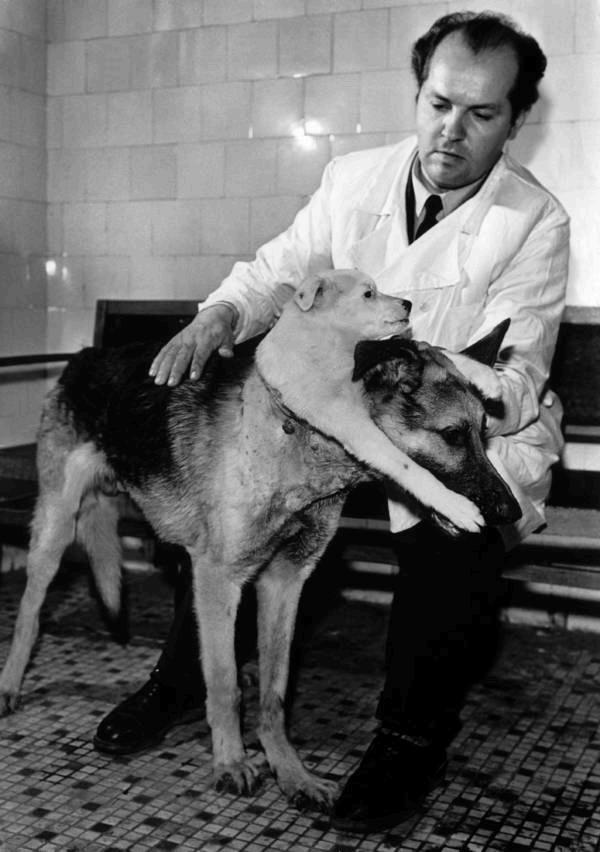
CaseStudy TheTwo-HeadedDogExperimentby DrVladimirDemikhov
by Amily Luo
Case Study: The two headed dog experiment by
Dr Vladimir Demikhov
by Amily Luo Y9 Wu
Introduction:
Having just finished his latest and perhaps most profound, refined experiment in the late 1950s, Vladimir Demikhov stepped back to reveal the gruesomely bizarre yet phenomenal creature he had created — a real-life Cerberus
Often considered the origins behind the life-saving organ transplant procedures, the gruesome yet groundbreaking two-headed dog experiment conducted by Soviet scientist Dr Vladimir Demikhov in 1968 represents a significant yet controversial milestone in the field of experimental surgery and organ transplantation The incredible feat was shocking to most, both in the general public and specialist scientists and doctors, with his longest experiments living up to 30 days.
Background:
Dr. Vladimir Demikhov, a prominent Soviet surgeon, is most widely recognised for his contributions to the advancement of organ transplantation techniques. However, as his work was scribed in Russian, written during the Cold War and in remote region of Russia, his work did not receive the recognition deserved for contributing so much to modern day heart and lung transpiration for humans
His most notable experiment involved the surgical attachment and grafting of a head of a smaller dog to the neck of a German shepherd. The main objective of this procedure at the time was to prove the possibility of transplant surgery, a new field of medicine in the 1950s Despite the initial success and advancement in the field, the surgery eventually raised a multitude of ethical concerns regarding animal safety, challenging the boundaries of surgical science and humanity’s ethical beliefs.
Objectives and Criteria:
Demikhov’s primary goals during the experiment were to: test the feasibility of complex organ and tissue transplantations for future human patients; study how well the body can integrate a new circulatory system and the risk of tissue rejection; improve the preservation of nerve function in the transplanted organs and develop innovative surgical techniques for organ transplantation.
Transplant Process:
How exactly did Demikhov manage to execute such a transplantation?
There were many steps - along with trial and error - involved in ensuring that the dogs were healthy and up to standard, so they wouldn’t reject the foreign organ and could properly function after the experiments.
Demikhov started simply by replacing the hearts of dogs with artificial blood pumps that he designed. The pump ensured that, even without the natural organ; blood would still be circulated throughout the body and oxygen would reach the brain of the animal. Then, he progressed to planting a second heart in the dog’s chest and removing part of a lung to make space for it The two hearts beat independently with their own rhythms
After gaining the experience needed, Demikhov started a bigger experiment: the transplantation of the head of a puppy onto the shoulder of a bigger dog to create a twoheaded dog. Dr. Demikhov conducted a reverse operation in which he removed most of a small puppy's body and grafted its remaining head and forelegs onto the neck of an adult dog. Remarkably enough, the larger dog's heart was able to pump enough blood for both heads via connecting blood flow. When the multi-headed dog regained consciousness after the procedure, the puppy's head awoke and yawned. Both dogs were reacting to stimuli, drinking water regularly and even walking as usual. This particular subject lived up to 29 days We can confidently say that the transplantation was one of his most successful yet ethically questionable.
What made this procedure so groundbreaking?
The execution of this surgery was no easy task, especially considering how new and unexplored the field of organ transplantation was at the time To ensure a successful procedure, Demikhov not only had to connect tiny nerve fibres (as small as a few millimetres in diameter), but he had to do it with the limited tools available in the 1960s: basic surgical instruments, suture materials, anaesthesia equipment and a simple microscope which could only magnify to 10x or 40x (whereas modern day microscopes magnify up to 100x). He also had to work around common complications, such as blood loss to the brain during the 4-to-6-hour surgery, nerve damage, rejection of the head by the host body and the risk of infection. The fact that the specimen could react to external stimuli after the procedure, let alone behave like a normal dog for 30 days, was groundbreaking.
How did his experiment revolutionise human organ transplantation?
Dr. Demikhov's innovative experiments, particularly with the two-headed dog, changed the field of human organ transplantation. He not onlyintroduced advanced surgical techniques for connecting blood vessels, and improved our understanding of organ rejection but also demonstrated how different biological systems can work together. His work not only inspired more research and advancements in transplantation but also raised important ethical questions about using animals in experiments.
Ultimately, Demikhov's pioneering efforts laid the groundwork for many modern practices in organ transplantation, and his legacy still influences the field today. Though controversial, his contributions remind us of the fascinating possibilities in medicine and encourage us to discover more and more in the field of transplantation, helping us to achieve higher healthcare quality and move one step closer to perfectly refined organ transplantation techniques.

AreLabGrownBabies TheFuture?
by Charlize Mui
Are Lab-grown babies the future?
Charlize A. Mui (Year 12, Wu House)
Introduction
I have thalassemia, a genetic blood condition where the body does not make enough of haemoglobin, a protein found in the red blood cells necessary for oxygen delivery to the rest of the body – most commonly affecting those from Asia, the Middle East, Africa, and Mediterranean countries (Holm). This disorder affects 4.4 out of every 10,000 live births, and approximately 5% of the world's population carries a variant in the alpha or beta region of the haemoglobin molecule. Not all of them are symptomatic, as some people are classified as silent carriers, however, 1.7% of the world's population exhibit thalassemia traits (symptoms caused by such gene mutations) (Smith). If someone carrying the gene for this genetic disorder were to have children with someone who has the same heterozygous genotype, there is a 75% chance that the child would carry the thalassemia trait and be affected by the condition – with a 25% chance that that gene would be thalassemia major, which poses a significant risk to both the mother and the child (See Fig.1).
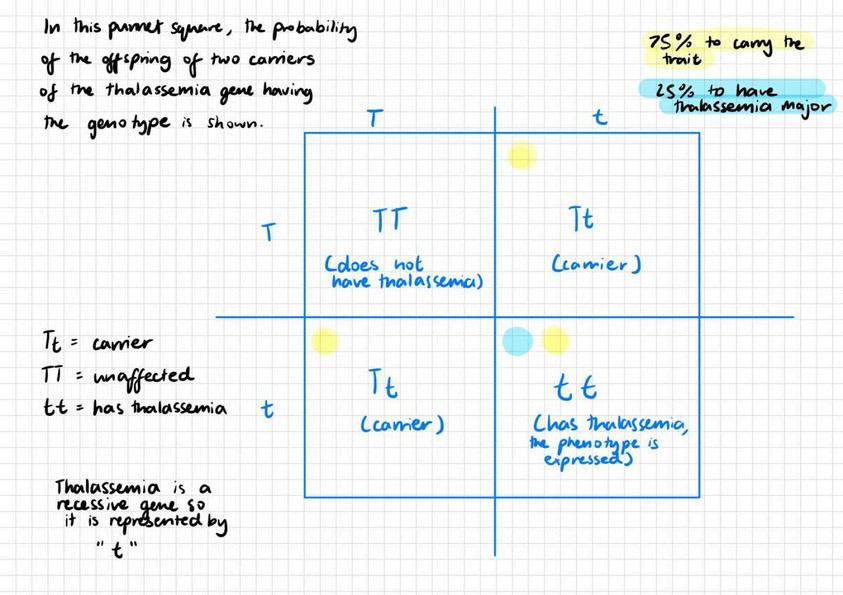
Figure 1 Punnett square showing the probability of thalassemia presence between two thalassemia carriers
There are three main types of thalassemia – alpha, beta, and minor Babies with beta thalassaemia major need lifelong blood transfusions, whereas those with alpha thalassaemia major experience symptoms as a foetus or a newborn and are typically unable to survive Although thalassaemia minor patients usually exhibit minimal symptoms and can live normal lives, some women may develop anaemia during pregnancy (The Family Planning Association of Hong Kong) Most recorded deaths
of patients with more severe cases of thalassemia (beta-thalassemia) are usually caused by iron overload due to frequent blood transfusions (Holm) Therefore, such patients must be extremely cautious with their iron intake, which not only imposes restrictions on their dietary intake and the drugs they can consume but also restricts the livelihood and reduces the average lifespan for those with more severe cases Thalassemia can also have life-long impacts on the physical endurance, an increased risk of infection, and other complications regarding a lack of healthy blood (Holm) This raises the question of how individuals with thalassemia can have children, and what measures can they take to reduce the risk of transmitting the condition to their children? This article will explore different fertility procedures that can help such people have children and increase their chances of having a healthy baby, as well as consider the importance of such procedures.
Why is there a recent fixation on
pregnancy?
From a governmental and social standpoint
Many technologies have been developed within recent decades, such as in-vitro fertilisation (IVF), which can increase the chances of conceiving a healthy embryo for people with certain genetic conditions or couples who are struggling with their fertility This is particularly pertinent in a society where birthrates are declining, creating a growing ageing population; particularly in developed countries such as South Korea - the country with the world’s lowest birth rate – this is a prevailing issue South Korea’s population is heading towards becoming an ageing population, as shown by Figure 2, and the government is concerned

Figure 2 The population pyramid in 1973, 2023 and the predictions for 2100 based on previous data and trends. The 1973 pyramid clearly shows a youthful population with a similar ratio of male to female In 2023, the population is gradually becoming ageing as the proportion of middle-aged people have increased The predicted pyramid for 2100 shows a further aged population with the highest proportion of people being 85-89. This data suggests that over time, death rates have decreased but so have birth rates (Population Pyramid)
In the next few decades, experts predict that the low birth rate will negatively impact South Korea’s economy, development, and living standards as the number of young people decreases whilst the number of elderly people requiring care simultaneously increase. As a result, there will not only be a depreciation in workforce, but also an increase in the average retirement age as there are fewer young people to care for the elderly and a larger economic incentive to continue working (Craig).
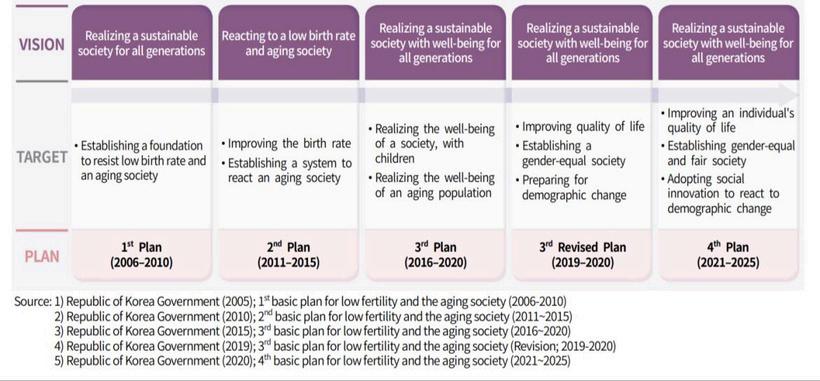
In 2022, the average number of babies per South Korean woman fell to 0.78 from the record low of 0.81 in 2021. To put this into perspective: to ensure the stability of a population, the average birth rate should be 2.1 - also known as the ‘replacement fertility rate’ (Craig). Resulting from this, the South Korean government is working towards improving birth rates via several incentives (see Fig. 3), such as issuing financial benefits of two million won (approx. $10,600 HKD) upon the birth of a child since 2022. For infants under the age of two, families receive 350,000 won per month in cash, and for newborns up to the age of one, 700,000 won. In 2024, the payments are expected to increase to 1 million won and 500,000 won, respectively. Children up to primary school age receive an additional 200,000 won per month, with additional funding available for low-income households and single parents. Pregnant women's medical bills, infertility treatments, babysitter services, and even dating expenses are additional benefits In addition to birthing and living monetary incentives, South Korea has also offered incentives and support for infertility to couples to encourage them to conceive a child using IVF and IUI (intrauterine insemination) (Rashid)
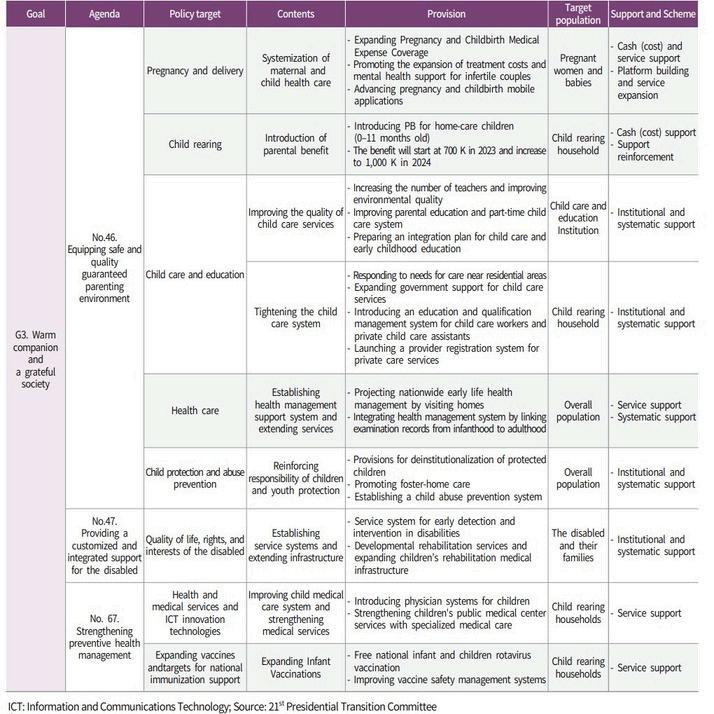
Figure 4 Governmental agenda and childcare support policies in 2022 for South Korea (Korean Institute of Child Care and Education)
As of early 2025, the payments do not seem to have matched the projected values as shown in the information available on the South Korean Ministry of Health and Welfare (see Fig 5)
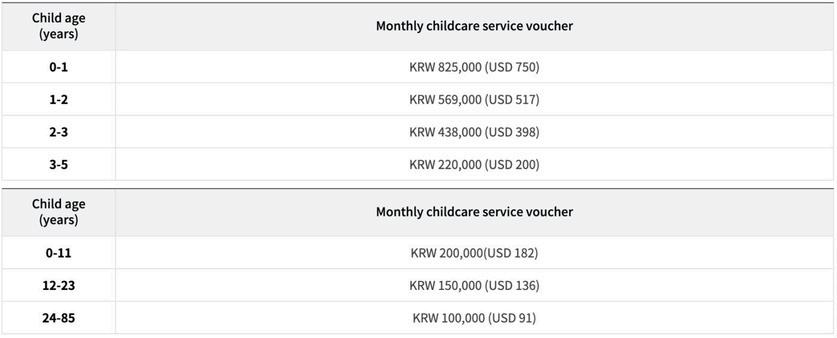
Figure 5 Table showing information on the current payments per category issued by the government (The South Korean Ministry of Health and Welfare (MOHW))
The issue of declining birth rates is also prevalent in many other countries such as China and Japan Each nation's social structure, religious convictions, level of economic development, and urbanisation are likely to have an impact on both the birth and abortion rates (Schumpeter & Backhaus) Because of lifestyle choices linked to economic affluence, where birth control is widely available, low rates of mortality, and the fact that raising children can be expensive due to housing, education, and other expenses, developed nations typically have lower fertility rates Women who pursue professional occupations and higher education frequently become parents later in life (Kim). Numerous factors - including lifestyle choices, the growth in sexually transmitted diseases (STDs), the rise in obesity, and environmental factors related to urbanisation and urban lifestyle - are influencing fertility and contributing to the rise in both male and female subfertility (Pham & Lin). Socioeconomic issues have also contributed to women and couples delaying parenthood. The current low fertility/birth rates can be attributed to several factors, including a lack of cheap housing, flexible and part-time employment opportunities for women, and accessible, publicly financed childcare (Yarger et al.). Due to ovarian ageing and other factors that lower the likelihood of conception, couples and women are delaying having children, which has resulted in a decrease in fertility.
However, it is not only the more developed countries that are faced with a fertility crisis; poorly resourced countries also tend to have greater fertility rates, while birth rates decline because of high maternal and perinatal deaths (Bailey et al.). Due to a lack of access to contraception and lower levels of female education, these countries have higher fertility rates. Children are also needed in emerging nations as labourers and to take care of their ageing parents. This further emphasises the need for governments to encourage the conception of children and to find ways to combat the declining birth rates.
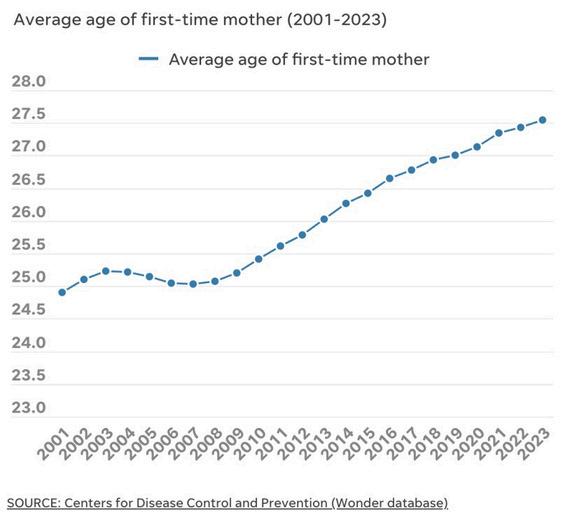
Figure 6 Graph showing the average age of first-time mothers in the USA (Chernikoff) The general trend is that over time, the average age of first-time mothers has increased.
In the United States of America, a major factor in the decline of birth rates is the shift to a careeroriented lifestyle; women with college degrees have children an average of seven years later than those without Heather Rackin, a sociologist studying fertility at Louisiana State University, states that those with a higher socioeconomic status “just have more potential things they could do instead of being a parent, like going to college or grad school and having a fulfilling career”, and because of the increased difficulty in overcoming social disparity, the economic status of the family can have major impacts on a child’s lifestyle, development, education, and future (Bui and Miller). As a result, the average age of first-time mothers has been steadily increasing (see Figure 6), which is particularly concerning being age has a distinct correlation with fertility – an elaboration of this is in the following section.

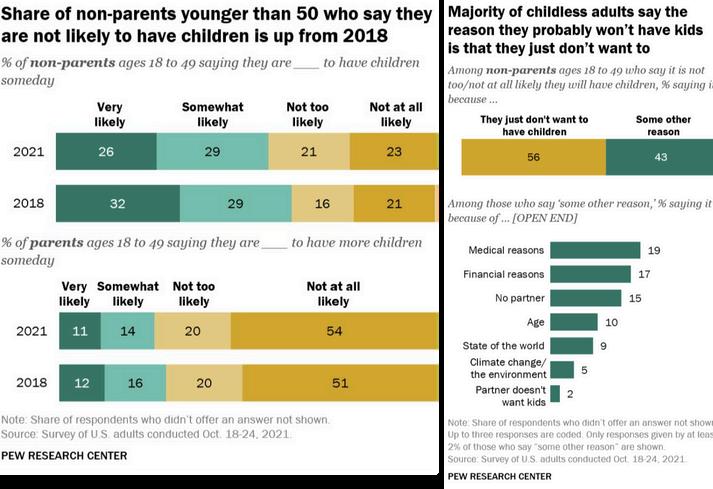
Many couples are also choosing to not have children at all – with some choosing to live a DINK (Dual-income-no-kids) lifestyle, further contributing to the declining birth rates (Newman). As shown in Figure 7, most childless adults (56%) just “don’t want to have children” whereas the other 43% is divided with medical reasons being the most popular reason (19%) (Brown).
From a biological standpoint
Age has a clear, well-known correlation with fertility; Over time, egg abundance and quality depreciate. Through the process of atresia (degeneration of ovarian follicles which do not ovulate during the menstrual cycle (“Atresia, N.”)), the ovary's gamete counts decreases. Initially there are a maximum of 6 to 7 million gametes at 20 weeks’ gestation, then a reduction to approximately 1-2 million oocytes (an undifferentiated, developing egg cell (Alberts et al )) at birth, 300,000-500,000 at puberty, 25,000 at age 37, and approximately 1,000 by the age of 51 (Owen and Sparzak) Not only does gamete count depreciation have an impact on the likelihood of fertilising a healthy egg cell, but the probability of a high quality, viable embryo decreases as well - evidenced by research article Mechanisms of oocyte aneuploidy associated with advanced maternal age (Mikwar et al )
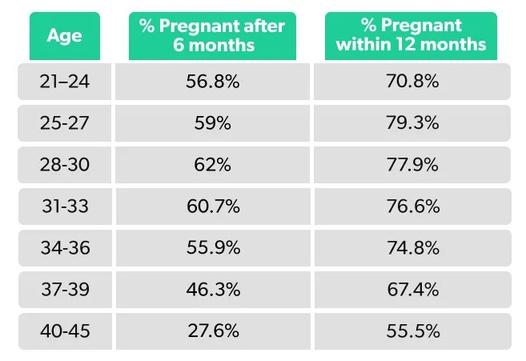
8 Statistical Probability of a Woman getting pregnant within 6 months or 12 months based on age group. (Davidson)
The research states that the likelihood of chromosomal abnormalities, particularly aneuploidy (when a germ cell has an incorrect number of chromosomes), also increases with age; approximately 2% of mothers under the age of 25 have children with Down syndrome – with the risk rising to about 35% for women 35 years of age or older. This has a significant impact on an oocyte's quality and thereby impacting fertility as aneuploidy is one of the most common causes of infertility and early miscarriage (Mikwar et al.). An article by Owen and Sparzak states “Aneuploidy can be attributed to 65% to 75% of early failed pregnancies and approximately 35% of clinically recognized miscarriages”, further highlighting that the quality and viability of the embryo – and by extension the ovum – has significant implications on whether a pregnancy will be successful (Fig 8) and carried to full term (Fig 9)
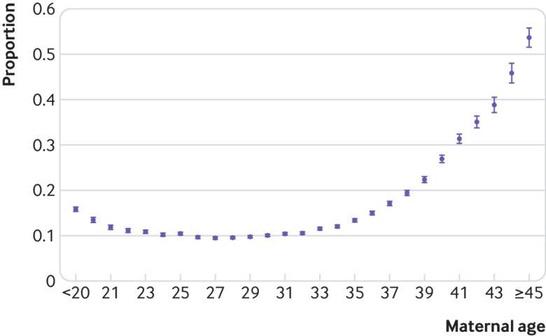
Figure 9 Graph showing risk of miscarriage according to maternal age “The bars for each point reflect the 95% confidence intervals” (Magnus et al.)
In combination with the fact that families are choosing to have children later in life, this poses significant issues regarding fertility and the possibility of conceiving a healthy child. The risk of miscarriage and genetic abnormalities is significantly more probable – therefore, it would be a major concern for those who wish to have children but are not of ideal fertility. There are three resulting options: “One, try to get pregnant now. Two, wait and see what my odds are. Or three, try to change my odds using technology.” (Abram, “The Truth about Egg Freezing”).
Methods of fertilisation: In-Vitro Fertilisation
IVF: What is it? How does it work?
Normally, the egg is released into the oviduct and the female gamete fuses with the male gamete (sperm) to form a zygote which then develops into an embryo, and eventually an offspring – a human baby In Vitro Fertilisation (IVF) is a type of assisted reproductive technology where –instead of inside a woman’s reproductive system – an egg is fertilised by sperm in vitro, or outside a living organism The process involves monitoring and stimulating a woman's ovulatory process (using injected and oral medication), removing ovum from her ovaries, and letting sperm fertilise them in a culture medium in a laboratory (NHS, “IVF”). IVF can increase the chances of having a healthy baby for people with the thalassemia gene, as it allows for genetic selection, which is the ability to select a particular embryo without the thalassemia genotype prior to implantation. This means that people with thalassemia can avoid having a baby with the genetic condition and avoid serious health implications for the foetus and mother.
IVF is not a guaranteed successful procedure. In a typical IVF cycle, approximately 20 eggs are retrieved. Out of them, only 15 will fertilise, of which only 1/3 make it to blastocyst stage (5-day old embryos). This probability is only relevant for young and healthy women with high quality embryos. This statistic can be reduced significantly as a woman ages, reducing the chances of having a high-quality embryo with desired genetic alleles (Fett, p.10).
The quality of the egg is determined by what occurs during the growth phase before ovulation. During the IVF egg retrieval process, immature eggs have not yet attained "meiotic competence." The egg separates and ejects copies of chromosomes (mitosis). If the process goes wrong, there will be chromosomal abnormalities – aneuploidy: this is this single most compelling cause of early miscarriages and failed IVF cycles (Advanced Fertility Center of Chicago). Meiotic competence is only reached when eggs complete the first meiotic reduction and reach the metaphase II stage. Metaphase is one of the phases in cell division (Interphase, Prophase, Metaphase, Anaphase, Telophase and Cytokinesis – a k a PMAT); metaphase is when the chromosomes line up at the cell equator In the process of meiosis, the cycle occurs twice, so an ovum cell is considered mature when it has reached the metaphase stage of the second PMAT cycle Meiosis reduces the amount of genetic material and chromosomes by half, creating haploid cells which allows for genetic variation The developing embryo then has the correct number of chromosomes and contains all the genetic material when the sperm and egg fuse and become fertilised (Scitable) Usually, 1015% of the eggs retrieved in one cycle are immature (Advanced Fertility Center of Chicago) And so, to increase the probability of a successful embryo, scientists can mature the egg in the lab as well
How can IVF assist those with genetic disorders and combat low birth rates?
Parents who are both carriers for recessive genetic disorders are essentially taking a gamble when having children, placing bets on whether their baby will be afflicted with the genetic disorder or not Such is the case for those with thalassemia, as mentioned in the introduction; as such, parents with the thalassemia gene tend to choose IVF rather than natural conception to increase the chances of a healthy, “normal” baby without any such complications Though it is possible to diagnose thalassemia through blood testing such as a haemoglobin electrophoresis tests, this requires a blood sample to be obtained which may not be viable for a developing foetus (Holm)
Some parents may prefer to negate the possibility of developing a child with thalassemia major as a preventative measure by genetically testing an embryo via preimplantation genetic testing (PGT) and transfer only embryos free of certain rare disease genes for gestation (development inside the uterus); PGT can also help evaluate the viability of the embryos to increase the probability of a successful birth (Johnston and Matthews). Nowadays, this is done by a combination of geneticists in the IVF clinic and the use of trained artificial intelligence tools to help determine egg maturity and quality – helping grade the embryos (See Figure 10).
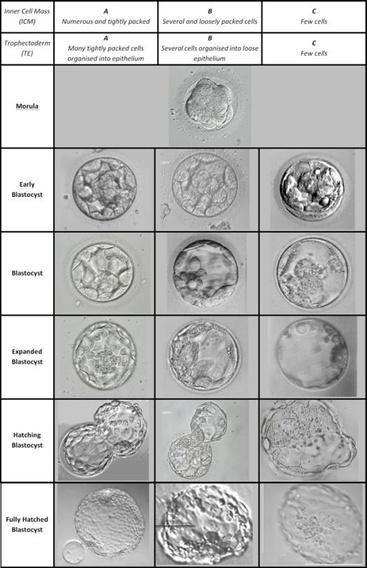
However, the process of IVF is expensive, time-consuming, requires a lot of patience, physically draining, and places stress on the mental health of the couple The hormonal, dietary, and lifestyle changes can be taxing on a woman’s body – having to inject oneself every morning at night at a specific time; taking birth control medication to control and predict ovulation for the egg retrieval procedure; adjusting physical activity and dietary intake in hopes of improving egg quality and providing a more habitable space for foetal development (MedLine Plus) The side effects of this can also significantly impact a woman’s self-image (e g weight gain due to the injections or medication, the hormonal fluctuations and the impact on both physical and emotional state, etc.). Despite this, the use of IVF means that couples can select an embryo without the thalassemia genotype, or even freeze mature ovum cells, sperm, or embryos while they are still of ideal reproductive age, ensuring the gametes or embryos are of the highest quality before waiting for a more suitable time to conceive a child (Assisted Reproductive Technology Unit Department of Obstetrics & Gynaecology). This provides more flexibility for couples that wish to have children but may be waiting for a more suitable stage of their lives to take on such a responsibility.
Ethical Considerations of IVF
IVF can also be used to ensure the implanted embryo are free of certain genetic disorders like Down Syndrome (Trisomy 21), Angelman Syndrome (mutation on chromosome 15), and Duchenne Muscular Atrophy (mutation on the X chromosome) – this also includes thalassemia (National Human Genome Research Institute)
However, it can be argued that since the embryo is undergoing PGT anyways, couldn’t some parents selectively choose “ideal traits” for their baby? Traits such as gender, eye colour, hair colour – any trait that is genetically predetermined in an embryo could theoretically be chosen before implanting the embryo. There have been concerns about actively selecting genetic traits of the embryos which some believe is discriminating against those with disabilities, or even discrimination between sexes. Furthermore, there is also concern that testing viability and quality of embryos means that embryos classified aneuploid or mosaic have been discarded, when arguably they could have otherwise led to a healthy foetus (Johnston and Matthews). An article by Josephine Johnston and Lucas J Matthews states that, a particular concern of justice (one of the four pillars of medical ethics) is that such testing may “further deemphasize environmental and social determinants of common diseases” which would divert public focus from systemic solutions to health and disability concerns to personal accountability for management of disease risks.
The future of fertility: In-Vitro Gametogenesis (IVG) and Artificial Womb Technology (AWT)
An overview of IVG
In the past, patients, such as those who struggle with their fertility and same-sex partners, had no way of having biological children of their own. To compromise, parents relied on surrogates, adoption, and donors to have children (NHS, “Having a Baby If You Are LGBT+”). However, the development of In-Vitro Gametogenesis (IVG) now provides the opportunity for such patients to have biological children
Although both are in-vitro procedures, there is a distinct difference IVF involves removing an egg from the ovaries and fertilising it with sperm in a lab (NHS, “IVF”) IVG enables the laboratory production of sperm and eggs from any type of human cell (Wesevich et al ) Through reprogramming dermal fibroblast cells (the primary cells within the dermis or inner skin layer, responsible for producing connective tissue) into induced pluripotent stem cells, these newly programmed cells may be used in embryogenesis and could restore a patient's fertility with a simple procedure; a sharp, hollow, circular tool is used to extract a tiny, round piece of tissue that is around the size of a pencil to provide the required dermal fibroblast cells - a skin punch biopsy (Wesevich et al.).
Induced pluripotent stem cells are produced by genetically reprogramming adult somatic (normal) cells to resemble embryonic stem cells, and subsequently from primordial germ cell-like cells (the initial form of undifferentiated stem cells that will eventually develop into gametes) into viable oocytes and spermatocytes (germ cells which undergo mitosis and maturation and differentiate to form gametes) (Nikolic et al.). In simple terms, it is when you create gametes out of induced pluripotent stem cells. It is also possible to create in vitro conditions that resemble the ovary or testes, which are essential for the maturation of the ovary cells (oogonia). This would enable the entire process of creating embryos outside of the human body.
Artificial Wombs
In cooperation with IVG and IVF, the development of artificial wombs has the potential to move the entirety of the reproductive process ex vivo – outside of the body. From the creation of gametes to fertilisation, to the development of the embryo, all these processes could be done entirely outside of the body by using Artificial Womb Technology (AWT). The MIT technology review defines an artificial womb as an experimental medical device intended to provide a womblike environment for extremely premature infants. In most variations, the infant floats in a clear bag surrounded by fluid – known as a “biobag” (Willyard).
This would be used in place of a uterus to develop the foetus, allowing women to have more freedom of choice. Instead of spending 9 months in pregnancy, taking maternity leave and missing work opportunities, and suffering the unfavourable side effects of pregnancy and childbirth, the mother would have the freedom of choice (Abram, “Would You Use an Artificial Womb? (I Would)”)
Implementation of AWT is not only limited to complete ectogenesis - gestation occurring entirely outside the womb (Lancaster University) – but also partial ectogenesis where the AWT can be used in the neonatal intensive care unit (NICU) to support what is referred to as “fetonates” (extremely premature infants) (De Bie et al ) However, the implementation of artificial wombs in more immediate, clinical, neonatal life-support systems raises four main ethical issues – as mentioned in the research by De Bie et al in 2022: (1) the potential benefits and harms of AWT; (2) autonomy of the parents; (3) legal status and personhood of the fetonate; (4) fairness of access.
To elaborate on the four ethical concerns (De Bie et al.):
(1) Potential Benefits and Harms
AWT could improve survival and reduce complications for extreme preterm infants. However, risks include physical harm from the technology and potential psychological effects due to the absence of maternal-foetal bonding.
(2) Parental Decision-Making
Ethical dilemmas arise over maternal autonomy, especially regarding C-section delivery for AWT. Parents and medical professionals will need to navigate complex decisions about continuing or discontinuing AWT support.
(3) Legal Status and Personhood of the Fetonate
A key question is whether fetonates should be considered newborns with full legal protections or foetuses without the same rights. Differences in terminology (e.g., "foetus" vs. "newborn") could highly influence ethical and legal debates. This is similar to the argument of whether an embryo is considered a living human and if the same rights would apply – it is crucial to define these parameters early on before proceeding with AWT use in a clinical setting
(4) Fairness of Access
High costs and resource limitations may exacerbate social inequalities in access to AWT, limiting the extent that the technology can truly be effective in a more practical sense Ethical concerns include whether AWT should be prioritised over other medical technologies, such as IV pumps or incubators (“Medical Equipment in the NICU”)
There are many questions regarding autonomy and non-maleficence being raised in particular - the main concerns being the right to make decisions about one’s body, the rights of the guardian to make decisions about their child’s medical care, the safety of the fetonate, and the legal and ethical rights of the fetonate. Further ethical considerations for partial ectogenesis in the NICU will be covered in more depth and detail in the ethical considerations section.
Ethical Considerations of IVG and Artificial Wombs
Although research in this field of stem cell biology and foetal development has the potential to completely revolutionise reproduction as we know it, several important ethical and scientific challenges still need to be addressed before this technology is ever used in a clinical setting
For example, same-sex couples or a couple of any age and fertility may be able to have their biological child thanks to this technique Additionally, it might release young women from the pressure to become mothers, which has the potential to drastically alter the nature of our society Women may be less pressured to become mothers or even feel the need to “make sacrifices” for the sake of their career or fertility (Abram, “The Truth about Egg Freezing”) Similarly to IVF, there will be concerns regarding genetic testing and conflicts on how to define each stage of development from a legal standpoint
As prior mentioned, the paper discussed the main ethical concerns about using AWT as neonatal life-support. This section raises the varying concerns brought about at different stages of prenatal development to develop on the four main ethical concerns, set out in four domains: Fertilization and Implantation (0–2 weeks), Embryonic and Early Foetal Development (2–21 weeks), Peri-Viability (22–25 weeks), and Vulnerable Prematurity (26–34 weeks) (De Bie et al.).
1) Domain
I: Fertilization and Implantation (0–2 weeks)
This domain covers the earliest stages of human development, beginning with in vitro fertilization (IVF) and the subsequent implantation of an embryo into the uterus Ethical concerns primarily revolve around the status and fate of embryos that are not implanted, as well as the potential for genetic selection and embryo research The legal and moral debate on whether embryos should be granted “personhood” – the rights of being considered an infant instead - influences regulations on embryo storage and disposal. Additionally, access to IVF remains limited due to high costs, raising concerns about socioeconomic disparities in reproductive technologies – not everyone will be able to access IVF and so, would this technology have a positive effect on enough of the population to justify the net cost of researching, producing, transporting, and ultimately using the artificial wombs?
2) Domain II: Embryonic and Early Foetal Development (2–21 weeks)
During this period, the embryo transitions into a foetus, undergoing significant organogenesis (developing organs) and structural development The ethical and medical complexities stem from the fact that no clinical interventions currently exist to sustain a foetus outside the womb before 22 weeks of gestation The theoretical extension of AWT to this stage of development raises concerns about foetal viability, abortion laws, and the potential for ectogenesis If AWT were developed for this domain, it could alter definitions of foetal rights and challenge current ethical and legal frameworks regarding reproductive autonomy. As mentioned previously, there will have to be a clear definition of the terms used to maintain medical ethics and the law.
3) Domain III: Peri-Viability (22–25 weeks)
This stage is the current threshold of foetal viability - premature infants may survive with intensive medical intervention. AWT could revolutionise neonatal care by improving survival rates and reducing the risks associated with traditional neonatal intensive care (e.g., ventilator-induced lung damage) However, its implementation raises ethical dilemmas concerning the decision to deliver a foetus early for AWT support and the potential for long-term developmental consequences Additionally, since viability often determines abortion rights, widespread adoption of AWT could influence debates on reproductive ethics and maternal-foetal decision-making/autonomy. If a foetus was purposely delivered early for the use of AWT, it could be argued that if the AWT support fails to maintain the life of the foetus, it may be considered an abortion or even child-abuse depending on the laws of that country. This further emphasises the need to define clear parameters before implementing the technology in society
4)
Domain IV: Vulnerable Prematurity (26–34 weeks)
In domain IV, premature infants are more likely to survive with fewer long-term complications due to advances in neonatal intensive care unit (NICU) practices. The main ethical concerns shift towards resource allocation, parental decision-making in cases of severe disability, and healthcare accessibility. While AWT could further enhance survival outcomes and reduce neonatal morbidity (suffering from a disease or medical condition), the cost and complexity may limit availability to wealthier healthcare systems, exacerbating any predisposed disparities in perinatal care. Ethical discussions also include whether continued NICU interventions align with the best interests of the child, particularly for infants with severe medical complications – is it an act against beneficence to place the child in AWT over other NICU technologies?
Conclusion
Though the use of assistive reproductive technologies is still debatable, research on these technologies pose a significant advantage towards scientific development. Like the controversy surrounding IVF usage when first proposed, the use of IVG and AWT will most likely spark debate amongst governmental figures and the public. Ethical and legal frameworks need to be implemented and evolve alongside new technologies to ensure responsible, safe, and equitable implementation in society. A particular quote from Dr. John C. Fletdher during a New York Times interview about IVF during the initial controversy in 1978, really stuck with me: “There is an obligation to relieve suffering when the means to do so are available, or in the absence of the means, to search for the means ” (Sullivan) This idea can and should be applied to every scientific discovery we make as a species, whether today, tomorrow, or in years to come As the world is becoming more and more career-oriented, with many choosing to settle down later in life on average - now, more than ever, is an important time to consider your future fertility so that when that time comes, whether you choose to have children or not, there is the option to decide rather than none
Cited
Abram, Cleo “The Truth about Egg Freezing ” YouTube, 11 June 2024, youtu be/98R8ObXlR1E?si=jt97wJCdN4rTDvqv Accessed 20 Jan 2025
--. “Would You Use an Artificial Womb? (I Would).” YouTube, 14 Apr. 2022, youtu.be/mLYMAkgvZsI?si=0JQROdhb9Edp2esl. Accessed 27 Jan. 2025.
Advanced Fertility Center of Chicago. “Immature IVF Eggs on the Day of Egg Retrieval, What Does It Mean? – Advanced Fertility Center of Chicago.” Immature IVF Eggs on the Day of Egg Retrieval, What Does It Mean?, advancedfertility.com/fertility-gallery/immature-ivf-eggs/.
Accessed 28 Feb 2024
Alberts, Bruce, et al. “Eggs.” Molecular Biology of the Cell. 4th Edition, vol. 4, no. 4, 2002, www.ncbi.nlm.nih.gov/books/NBK26842/. Accessed 30 Jan. 2025.
Arav, Amir, and Yehudit Natan. “The near Future of Vitrification of Oocytes and Embryos: Looking into Past Experience and Planning into the Future.” Transfusion Medicine and Hemotherapy, vol 46, no 3, 2019, pp 182–87, https://doi org/10 1159/000497749 Accessed 20 Jan 2025
Assisted Reproductive Technology Unit Department of Obstetrics & Gynaecology “Fertility Preservation | CUHK IVFHK ” Ivfhk com, Assisted Reproductive Technology (ART) Unit Department of Obstetrics & Gynaecology The Chinese University of Hong Kong & Prince of Wales Hospital, 2024, ivfhk.com/en/fertility-preservation. Accessed 20 Jan. 2025.
“Atresia, N ” Oxford English Dictionary, Oxford University Press, July 2023, https://doi.org/10.1093/oed/1319059909. Accessed 30 Jan. 2025.
Bailey, Patricia E., et al. “Institutional Maternal and Perinatal Deaths: A Review of 40 Low and Middle Income Countries ” BMC Pregnancy and Childbirth, vol 17, no 1, Sept 2017, https://doi.org/10.1186/s12884-017-1479-1. Accessed 20 Jan. 2025.
Brown, Anna. “Growing Share of Childless Adults in U.S. Don’t Expect to Ever Have Children.” Pew Research Center, 19 Nov. 2021, www.pewresearch.org/short-reads/2021/11/19/growingshare-of-childless-adults-in-u-s-dont-expect-to-ever-have-children/ Accessed 3 Feb 2025
Bui, Quoctrung, and Claire Miller. “The Age That Women Have Babies: How a Gap Divides America.” The New York Times, 4 Aug. 2018,
www nytimes com/interactive/2018/08/04/upshot/up-birth-age-gap html Accessed 26 Jan 2025.
Chernikoff, Sara “The Average Age of First-Time Mothers Continues to Rise See Charts ” USA TODAY, 18 May 2024, www.usatoday.com/story/news/health/2024/05/18/graphics-showchanging-trend-average-age-parents/73707908007/. Accessed 26 Jan. 2025.
Craig, J. “Replacement Level Fertility and Future Population Growth.” Population Trends, 1994, pubmed.ncbi.nlm.nih.gov/7834459/. Accessed 20 Jan. 2025.
Davidson, Jordan. “Female Fertility Age Chart.” Ro, June 2022, ro.co/fertility/female-fertility-agechart/. Accessed 20 Jan. 2025.
De Bie, Felix R., et al. “Ethics Considerations Regarding Artificial Womb Technology for the Fetonate.” The American Journal of Bioethics, vol. 23, no. 5, Apr. 2022, pp. 1–12, https://doi org/10 1080/15265161 2022 2048738 Accessed 30 Jan 2025
Fett, Rebecca. It Starts with the Egg. Franklin Fox Publishing, 2014.
Holm, Gretchen “Thalassemia: Causes, Symptoms, Diagnosis, Treatment, and More ” Healthline, 2017, www healthline com/health/thalassemia Accessed 26 Jan 2025
J Schumpeter, and Ursula Backhaus “The Theory of Economic Development ” Semantic Scholar, 2017, www semanticscholar org/paper/The-Theory-of-Economic-Development-SchumpeterBackhaus/c5e5ecbecd50daf4c752eebd4c20073c4ef2591b. Accessed 20 Jan. 2025.
Johnston, Josephine, and Lucas J Matthews “Polygenic Embryo Testing: Understated Ethics, Unclear Utility.” Nature Medicine, vol. 28, no. 3, Mar. 2022, pp. 446–48, https://doi.org/10.1038/s41591-022-01743-0. Accessed 27 Jan. 2025.
Kim, Jungho. “Female Education and Its Impact on Fertility.” IZA World of Labor, 2023, https://doi.org/10.15185/izawol.228.v2. Accessed 20 Jan. 2025.
Korean Institute of Child Care and Education. “President Yoon’s Government Policies for Enhancing Child-Rearing.” Kicce.re.kr, Korea Institute of Child Care and Education, Oct. 2022, kicce re kr/board/boardFile/download/89/47137/34175 do Accessed 4 Mar 2024
Lancaster University. “Ectogenesis.” Future of Human Reproduction, wp.lancs.ac.uk/futureofhumanreproduction/ectogenesis/. Accessed 3 Feb. 2025.
Magnus, Maria C , et al “Role of Maternal Age and Pregnancy History in Risk of Miscarriage: Prospective Register Based Study ” BMJ, vol 364, Mar 2019, p l869, https://doi.org/10.1136/bmj.l869. Accessed 27 Jan. 2025.
“Medical Equipment in the NICU.” Www.nationwidechildrens.org, www.nationwidechildrens.org/family-resources-education/health-wellness-and-safetyresources/resources-for-parents-and-kids/nicu-resources/medical-equipment-in-the-nicu.
Accessed 3 Feb 2025
MedLine Plus. “In Vitro Fertilization (IVF): MedlinePlus Medical Encyclopedia.” Medlineplus.gov, 1 Oct. 2022, medlineplus.gov/ency/article/007279.htm. Accessed 26 Jan. 2025.
Mikwar, Myy, et al. “Mechanisms of Oocyte Aneuploidy Associated with Advanced Maternal Age.” Mutation Research/Reviews in Mutation Research, vol. 785, July 2020, p. 108320, https://doi org/10 1016/j mrrev 2020 108320 Accessed 27 Jan 2025
Nargund, Geeta. “Declining Birth Rate in Developed Countries: A Radical Policy Re-Think Is Required.” Facts, Views & Vision in ObGyn, vol. 1, no. 3, Universa Press, 2009, pp. 191–93, www ncbi nlm nih gov/pmc/articles/PMC4255510/ Accessed 4 Mar 2024
National Human Genome Research Institute. “Genetic Disorders.” Genome.gov, National Human Genome Research Institute, 18 May 2018, www genome gov/For-Patients-andFamilies/Genetic-Disorders. Accessed 27 Jan. 2025.
Newman, Danny “The DINK Lifestyle: What Is It and Why Do People Choose It?” Wealthtender, 4 Feb. 2023, wealthtender.com/insights/dink-dual-income-no-kids-lifestyle/. Accessed 3 Feb. 2025.
NHS “Having a Baby If You Are LGBT+ ” Nhs uk, 8 Dec 2020, www nhs uk/pregnancy/having-ababy-if-you-are-lgbt-plus/ways-to-become-a-parent-if-you-are-lgbt-plus/. Accessed 20 Jan. 2025.
--. “IVF.” NHS, NHS, 18 Oct. 2021, www.nhs.uk/conditions/ivf/. Accessed 20 Jan. 2025.
Nikolic, Aleksandar, et al “Primordial Germ Cells: Current Knowledge and Perspectives ” Stem Cells International, vol. 2016, no. 1741072, 2016, pp. 1–8, https://doi.org/10.1155/2016/1741072. Accessed 4 Mar 2024
Owen, Amy, and Paul B Sparzak “Age Related Fertility Decline ” PubMed, StatPearls Publishing, 2022, www ncbi nlm nih gov/books/NBK576440/ Accessed 27 Jan 2025
PFCLA “What Is IVF Embryo Grading?” Pfcla com, Hatch Fertility, 17 Sept 2018, www.pfcla.com/blog/parents-handbook-on-embryo-grading. Accessed 2 Apr. 2025.
Pham, Kien T., and Tang-Huang Lin. “Effects of Urbanisation on Ecosystem Service Values: A Case Study of Nha Trang, Vietnam.” Land Use Policy, vol. 128, May 2023, pp. 106599–99, https://doi.org/10.1016/j.landusepol.2023.106599. Accessed 20 Jan. 2025.
Population Pyramid. “Population Pyramids of the World from 1950 to 2100.” PopulationPyramid.net, 2023, www.populationpyramid.net/republic-of-korea/2023/. Accessed 22 Jan. 2024.
Rashid, Raphael. “South Korea Has so Few Babies It Is Offering New Parents $10,500.” Www.aljazeera.com, 12 Apr. 2023, www.aljazeera.com/news/2023/4/12/south-koreasplashes-the-cash-in-scramble-to-fix-fertility-crisis Accessed 20 Jan 2024
Scitable. “Meiosis | Learn Science at Scitable.” Nature.com, 2014, www.nature.com/scitable/definition/meiosis-88/. Accessed 20 Jan. 2025.
Smith, Yolanda “Thalassemia Prevalence ” News-Medical net, 30 Aug 2022, www newsmedical net/health/Thalassemia-Prevalence aspx Accessed 19 Jan 2024
Sullivan, Walter “‘Test‐Tube Baby’ Clinic Planned ” Nytimes com, The New York Times, 12 Dec 1978, www nytimes com/1978/12/12/archives/testtube-baby-clinic-planned-norfolk-clinic-toopen.html. Accessed 7 Mar. 2025.
The Family Planning Association of Hong Kong. “Thalassemia - the Family Planning Association of Hong Kong.” Www.famplan.org.hk, The Family Planning Association of Hong Kong, www.famplan.org.hk/en/health-info/pregnancy-and-fertility/thalassemia. Accessed 26 Jan. 2025
The South Korean Ministry of Health and Welfare (MOHW). “Individualized Care < Policies :
, The South Korean Ministry of Health and Welfare (MOHW), 2018, www.mohw.go.kr/menu.es?mid=a20202000000. Accessed 7 Mar 2025
Wesevich, Victoria G., et al. “In Vitro Gametogenesis in Oncofertility: A Review of Its Potential Use and Present-Day Challenges in Moving toward Fertility Preservation and Restoration ”
Journal of Clinical Medicine, vol. 12, no. 9, May 2023, p. 3305, https://doi org/10 3390/jcm12093305 Accessed 27 Jan 2024
Willyard, Cassandra. “Everything You Need to Know about Artificial Wombs.” MIT Technology
Review, 29 Sept. 2023, www.technologyreview.com/2023/09/29/1080538/everything-youneed-to-know-about-artificial-wombs/. Accessed 4 Mar. 2024.
Yarger, Jennifer, et al. “Perceived Access to Contraception via Telemedicine among Young Adults: Inequities by Food and Housing Insecurity.” Journal of General Internal Medicine, vol. 38, no 2, June 2022, pp 302–8, https://doi org/10 1007/s11606-022-07669-0
Accessed 20 Jan. 2025.
Ye, Lei, et al. “Induced Pluripotent Stem Cells and Their Potential for Basic and Clinical Sciences.”
Current Cardiology Reviews, vol. 9, no. 1, Feb. 2013, pp. 63–72, https://doi org/10 2174/157340313805076278 Accessed 4 Mar 2024
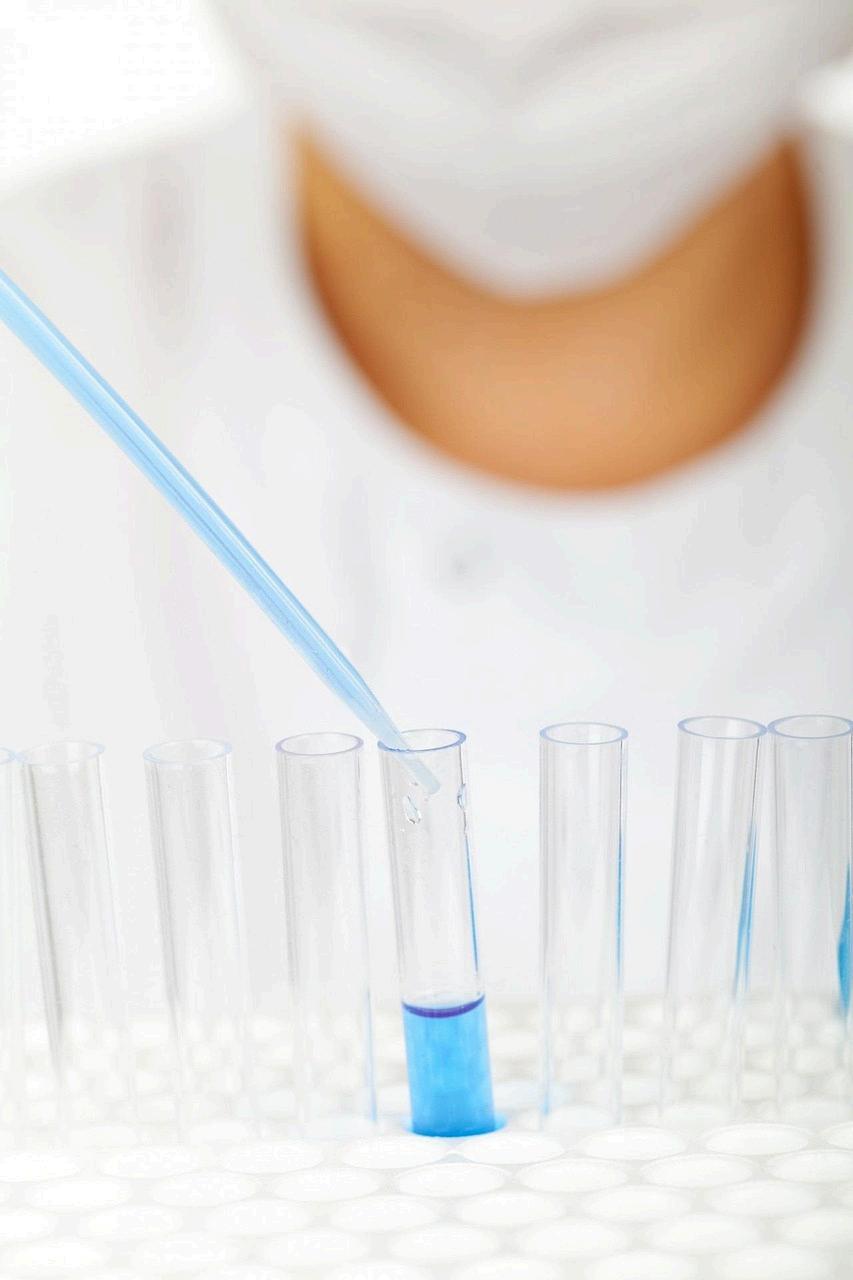
EpigeneticEditing Technologies:Applications andFuturePotential
by Sen Yi Mok
Introduction
WhiletheDNAsequencedictatesthepotentialcombinationsofgeneexpressions,epigeneticsrefersto modificationsthatmanipulatehowexpressionsarereadbyenzymeswithoutalteringthebasesequenceitself[1]. ThesemodificationsareprimarilypresentedasDNAmethylationandhistonemodification,althoughmechanisms likenon-codingRNA(ncRNA)regulationorRNAmodificationcanalsocontributetochangesintheepigenome [2].
DNAmethylationisamorestable,long-termmechanismthataddsamethyl(CH3)groupontoaCpG(cytosine basefollowedbyaguaninebase)dinucleotidewhichsilencesthespecificgene[3,4] Ontheotherhand,histone modificationisamoredynamic,short-termmechanismthatalterschromatinstructure.Thisoccursthroughthe additionoffunctionalgroups,suchasAcetyl(CH3CO)orPhosphoryl(P=O)athistonetailsorcores,whichcan activateorrepressgenesdependingonthecontext[9].Moresignificantly,unlikeDNAmutations,theseepigenetic changesarereversibleandrespondrelativelyquicklytoenvironmentalstimuli
SourcesofEpigeneticErrors
Epigeneticerrorsrefertoincorrectgenemodificationortheincorrectadditionorremovalofcertainfunctional groupsonthespecifiedgene[1].Althoughepigeneticerrorscanbenaturalandoccurrandomly,mosthavebeen showntobelinkedtoenvironmentalfactors,includingchemicalexposureandcertaindiets.Forinstance,exposure toheavymetalslikehexavalentchromiumandcadmium,cancausewidespreadDNAmethylationinthousandsof genesinbronchialepithelialcells[5,6].Anothercommonsourceofsucherrorsisdietary:Accordingtoastudy conductedbyLiu,Jiangweietal.inrainbowtrout,ahighcarbohydrateandlowproteindietcaninduceglobal DNAdemethylation[7].Polycyclicaromatichydrocarbons,mainlyproducedintheincompletecombustionof engineexhaust,induceDNAhypermethylationinanimals,withlowerdoseshavingaparticularlystrongeffecton developinganimalfoetuses[8].Lastly,anotablesourceofepigeneticerrorsistobaccosmoke,whichwasfoundto notonlycausehypomethylationthatresultedincertaincancersbutalsointerferedwithhistonefunctionandwas linkedtospecificgenehypermethylationpatterns[8].Theseenvironmentalsourcesarefundamentaldriverstothe diseasesbelow,andunderstandingtheexactcauseofepigeneticchangesiscrucialtothepreventionand treatmentofthesediseases.
EffectsofEpigeneticErrors
Cancer
Beingthesecondleadingcauseofdeath,cancerischaracterisedbythegrowthofabnormalcellsthatcanrapidly spreadthroughthebodyanddestroybodytissue[10].Whileoftenonlyattributedtomutations,epigeneticerrors canplayaroleincarcinogenesis,whereepigeneticerrors(suchasDNAhypomethylationwhichcanleadto rearrangementsofchromosomestructureandspecifichypermethylationatCpGislands)caninactivatethe transcriptionofgenesandsilencetumoursuppressorgenes[11,12].Thesechangesinmethylatedcytosinebases havebeencorrelatedwithvariouscancers;Forexample,theabnormalincreaseofenzymesthatdictate methylation(methyltransferase)likeDNMT1,DNMT3aandDNMT3bhavebeenfoundincolorectalcancer[11]. Theseepigeneticchanges,however,isnotonlylimitedtomethylation,andalterationsinenzymelevelsthat transferacetylontohistoneproteins(histoneacetyltransferases)andmicroRNAs(miR),asmallerversionofncRNA witharound22nucleotideshavebeenfoundincolon,breastandlungcancer[11].Rareralterations,suchasthe upregulationofmiR-92bwhichtargetsthePRMT5gene,havebeenfoundinbrainprimarytumours[11].Giventhe stronglinkandpotentialcausalityofchangesinmethylatedDNAsequences,histoneandmiRNApatternswith cancer,furtherresearchcanallowthesetoactasbiomarkersformonitoringcarcinogenesisanddiagnosis,suchas confirmingthemalignanceofatumour
Furthermore,giventhereversiblenatureofepigeneticchanges,targeteddemethylationandhistoneacetylase inhibitorscanactastreatmentforcertaintypesofcancer[12].
Addiction
Surprisingly,epigeneticscanplayakeyroleindrugaddiction,asaddictshavebeenfoundtohaveremodelled neuronsthathaveadaptedattheepigeneticlevelinthebrain’srewardcircuit(mesolimbicdopaminecircuitry)[13] Morespecifically,repeatedexposuretodrugslikecocaine,opiatesornicotineincreaseshistoneacetylationinthe nucleusaccumbens,causingincreasedsensitivitytoreward-relatedbehaviours[13].Inadditiontothesefindings, experimentsinvolvingtheadministrationofcocaineinmicerevealedthatchronicexposureresultedinepigenetic germline(sexcells)remodelling,hyperacetylationintheCamKIIageneresponsibleformemoryformationand impairedsynapticplasticityofmaleoffspring[14]
Apartfromcommondrugs,otheraddictiveagentssuchasalcoholhavebeenshowntodrasticallyimpactthe epigenomeduringbothshorttermandlong-termexposure.InastudybyAndreyandGregg,acuteethanol exposureinmiceinducednetglobalacetylationofhistonesinthecerebralcortex,whichisresponsiblefor cognitionandbehaviour.Similarly,studiesinvolvinglong-termexposuretoethanolinmicehavealsofoundglobal hypomethylationandacetylationofhistones,whichcanheightenaddictionandcontributetocognitivedisorders [14].
Withthehelpofneuroepigeneticeditingwhichcantargetandrewriteaspecificgenomiclocusinacell,itmaybe possibletoreversethesechangesandactasaformofanti-addictiontreatment,aswellasallowingscientiststofind adefinitecausallinkforspecificepigeneticmechanisms[13].
Neurologicaldisorders
Neurologicaldisorders,suchasAlzheimer'sdisease,Parkinson'sdiseaseandHuntington’sdisease,havealsobeen foundtobelinkedwithunderlyingepigeneticmechanisms,namelyabnormalDNAmethylationandhistone modifications[15].Withmanyofthesediseasesbeinghardtodiagnoseandeasiertotreatduringearlier intervention,epigeneticbiomarkershavebeenproposedtobeusedfordiagnosis,andgiveamorepersonalised treatmentthroughepigeneticprofiling,asthelackofgeneticmodificationcanshowtheimpactofgeneticand environmentalfactors[15].Thismethodhasbeenrelativelysuccessfulindepressionandschizophreniatreatment andisseentoenhanceefficacyandreducesideeffectsseeninconventionaltreatmentoptions[16].
Furthermore,althoughmanyneurologicaldiseaseslackcures,drugssuchashistonedeacetylaseinhibitors,which counterhistonehypoacetylationinthediseasesabove,couldreducetheonsetofdiseaseanddrasticallyimprove lifeexpectanciesofpatients[17].Inneurodegenerativemice,thesedrugshaveexhibitedneuroprotectiveeffects, includingrestorationofmemory,enhancedsynapticplasticityandenhancedneuronaldifferentiation (developmentofneuronsfromneuralstemcells)[17].WithgrowingevidenceoftheimpactofDNAmethylationon thedysfunctionofoligodendrogliaoftenseeninneurologicalconditions,DNAmethyltransferaseinhibitorsare likelytoexhibitsimilareffectsintreatingsuchdisorders[18].
Ageing
Whiletheexactmechanismbehindageingisnotfullyunderstood,ithasbeenfoundthattherearemanyageassociatedepigeneticchanges,suchasdownregulationofDNAmethylationandmodifiedhistonestructures, whichcontributesignificantlytoageingrelateddiseases[19].Thesefindingsweresupportedbystudiesfrom Greer,E.L.etal.andKennedy,B.K.etal.,whofoundthatdemethylationincertainhistones(H3K36me3)in roundworms(C.elegans)increasedtheirlifespanwhilethelossofdemethylationgroupsinyeast(S.cerevisiae) increasedtheirlifespan[19].
Thishasledtothedevelopmentofpromisinggeroprotectivedrugssuchasnicotinamideadeninedinucleotide (NAD)andmetformin,whichtargethistoneacetylationtoregulateage.Interestingly,developmentsintraditional ChinesemedicineremediessuchasBaziandYiweitanghavealsoshowedpromisingresultsinreducingskin aging,wherestudiesfoundincreasedlevelsofcollagenandantioxidantenzymesandimprovedskinelasticityin mice[20].
Asidefromincreasinglifeexpectancy,scientistshavealsobeenabletousemethylationlevelasabiomarkerto predictageandage-relateddiseases[19].Recentstudies,notablyScAge,wasabletousesinglecelldatato differentiatebetweencellswithdifferentchronologicalagesinheterogeneoustissues,aswellasprofilingthe epigeneticageofmice[21].
EpigeneticEditingTechniques
Thekeytotreatingthediseasesabovelikelyliesinepigeneticediting,whichincludetechnologieslikezinc-finger nuclease(ZFN),transcriptionactivator-likeeffectornuclease(TALEN),andmostrecently,clusteredregulatory interspacedshortpalindromicrepeats(CRISPR)[22].
ZFNconsistsofzincfingerproteinsfusedwithanepigeneticeffectordomain,whichhavebeendevelopedtobind toDNAtriplets,creatingadoublestrandedbreak[23].Asthistriggersthehomologydirectrepair(HDR) mechanism,epigeneticmodifierscanthenbeusedtosuppressoractivateunwantedgenes[23].ZFNsare typicallyusedwhenrelativelyhighefficiencyandactivityisneededbutistimeconsumingandcomplexto engineerandcouldhavepotentialeffectsonsitesadjacenttothetarget[23].
TALEN,aproteinfromplantpathogenicbacteria,worksonasimilarprinciple,butcanbeengineeredtobindtoa singlenucleotideinsteadofthree,allowingformuchgreaterspecificitybutismoretime-consumingtoassemble repeatsequences[23].Thesemechanismshavebeenrelativelysuccessful,withzincfingerbeingusedtorepressa mutanthuntingtingeneinthebraintissueinananimalmodelandinderivedpatientcellsforHuntington’sdisease, whileTALENhasbeenusedtomethylatesequencesthecentralchromosomalregioninmouseembryos[22].
CRISPR,ontheotherhand,mimicsbacterialimmunedefencesagainstvirusesbyutilisingguideRNA(gRNA)to targetaspecificDNAsequence[24].A‘dead’(lackingcleavageactivity)Cas9(dCas9)proteinfusedtoepigenetic modifiers,directedbythegRNA,canthenbindtotheDNAwithoutcuttingtheDNAsequence[24].This mechanismisespeciallyeffectiveasitallowsforspecificandmultiplexmodifications:targetingmultiplegenes simultaneouslyusingvariousgRNAs,aswellasbeingabletotargetDNAsequencesofanylength,reducingthe timetakenforproteinengineering[24].Theseadvantageshavebeendemonstratedinanepigenomeeditor proteinnamedCRISPRoff,whichwasabletosilencegenesrelativelystably(whereexpressionismaintainedover 450celldivisions)withhighspecificityovermultiplegenes[25].However,CRISPRissusceptibletooff-targetevents andcansometimeshaveunsustainabletherapeuticeffects,whereepigeneticmarkscanoftenfadeawayduring celldivision[24] Whilethemechanismitselfiscosteffectiveandsimple,itisalsolimitedbytheeffectivenessofthe deliveryvehicle[24].Althoughnanocarriersystemsaspotentialdeliveryvehiclesshowpromise,muchresearchis neededtoimprovetheirsafetyandstarthumantrials[24].
Conclusion
Despitetherapidevolutionofepigeneticeditingtechnologyandthefutureimpactithasonmodernbiologyand diseaseprevention,moreclinicaltrialswithlargersamplesareneededtocreatesafeandlong-lastingtreatments. Aswithmostemergingmedicine,therearemanyethicalconsiderationssurroundingepigenetic
editing Keyconcernsincludetheaccessibilityoftheselifesavingbutexpensivetreatments,aswellasprivacy concernsstemmingfromthecloselinksbetweenlifestylehabits–suchasdietandenvironmentalexposures–and epigenetics[26].Additionally,duetotheheritablenatureofepigenetics,somescientistsareconcernedabout transgenerationalinheritance.Thisreferstohowthelifestylechoices,habits,andchemicalexposureofthe previousgenerationcanindirectlyaffecttheepigenome,andtherefore,healthofthenextgeneration[26].Lastly, duetotherecencyofthefield,scientistshavenotyetconfirmedtheconsequencesoflong-termepigenetic modification[26].Despitetheseconcerns,itissafetosaythatepigeneticeditingholdsgreatpotentialindisease preventionandcareimprovementthroughthedevelopmentofpersonalisedtreatmentsanddrugs.Asmoretrials areconductedandadvancementsaremadeinthereversalofepigeneticmechanisms,mostoftheabove concernscanbeeffectivelyaddressed,pavingthewayforimprovedcareandtreatmentoptions.
Bibliography
[1]“WhatIsEpigenetics?:MedlinePlusGenetics.”MedlinePlus-HealthInformationfromtheNationalLibraryof Medicine,11June2021,https://medlineplus.gov/genetics/understanding/howgeneswork/epigenome/. Accessedon29thJanuary2025.
[2]Wang,Kang,etal.“EpigeneticRegulationofAging:ImplicationsforInterventionsofAgingandDiseases|Signal TransductionandTargetedTherapy.”Nature,SpringerNature,7Nov.2022, https://www.nature.com/articles/s41392-022-01211-8.Accessedon29thJanuary2025.
[3]Handy,Diane,etal.“EpigeneticModifications:BasicMechanismsandRoleinCardiovascularDisease.”PubMed Central,Circulation,17May2011,https://pmc.ncbi.nlm.nih.gov/articles/PMC3107542/.Accessedon29thJanuary 2025.
[4]Jin,Bilian,etal.“DNAMethylation:SuperiororSubordinateintheEpigeneticHierarchy?-PMC.”PMCHome, GenesCancer,2June2011,https://pmc.ncbi.nlm.nih.gov/articles/PMC3174260/.Accessedon29thJanuary 2025.
[5]Broadfoot,Marla.“EnvironmentalEpigeneticsUncoversLinksbetweenExposures,Disease.”Environmental Factor,May2022,https://factor.niehs.nih.gov/2022/5/science-highlights/environmental-epigenetic.Accessedon 29thJanuary2025.
[6]Wang,Betal “Cadmiumanditsepigeneticeffects”Currentmedicinalchemistryvol 19,16(2012):2611-20 doi:10.2174/092986712800492913.Accessedon30thJanuary2025.
[7]Liu,Jingwei,etal.“HepaticGlobalDNAHypomethylationPhenotypeinRainbowTroutFedDietsVaryingin CarbohydratetoProteinRatio.”ScienceDirect,Elsevier,Jan.2022, https://www.sciencedirect.com/science/article/pii/S002231662200503X.Accessedon30thJanuary2025.
[8]Ho,Shuk-Mei “EnvironmentalEpigeneticsandItsImplicationonDiseaseRiskandHealthOutcomes”ILAR Journal,ILARJournal,Dec.2012,https://academic.oup.com/ilarjournal/article/53/3-4/289/654435.Accessedon 30thJanuary2025.
[9]Bannister,Andrew,andTonyKouzarides.“RegulationofChromatinbyHistoneModifications|CellResearch.” Nature,SpringerNature,2011,https://www.nature.com/articles/cr201122.Accessedon30thJanuary2025.
[10]“Cancer-SymptomsandCauses-MayoClinic”MayoClinic,19Nov 2024, https://www.mayoclinic.org/diseases-conditions/cancer/symptoms-causes/syc-20370588.Accessedon30th January2025.
[11]Kanwal,R,andSGupta.“Epigeneticmodificationsincancer.”Clinicalgeneticsvol.81,4(2012):303-11. doi:10.1111/j.1399-0004.2011.01809.x.Accessedon30thJanuary2025.
[12]Ehrlich,Melanie “DNAhypomethylationincancercells”Epigenomicsvol 1,2(2009):239-59 doi:10.2217/epi.09.33.Accessedon30thJanuary2025.
[13]Hamilton,PeterJ,andEricJNestler.“Epigeneticsandaddiction.”Currentopinioninneurobiologyvol.59 (2019):128-136.doi:10.1016/j.conb.2019.05.005.Accessedon30thJanuary2025.
[14]Koijam,Arunkumar,etal “DrugAddictionandTreatment:AnEpigeneticPerspective”ScienceDirect, Biomedicine&Pharmacotherapy,Jan.2024, https://www.sciencedirect.com/science/article/pii/S0753332223017493.Accessedon30thJanuary2025.
[15]Grezenko,Han,etal.“EpigeneticsinNeurologicalandPsychiatricDisorders:AComprehensiveReviewof CurrentUnderstandingandFuturePerspectives-PMC.”PMCHome,Cureus,23Aug.2023, https://pmcncbinlmnihgov/articles/PMC10446850/ Accessedon30thJanuary2025
[16]Grayson,DennisR.,andAlessandroGuidotti."TheDynamicsofDNAMethylationinSchizophreniaandRelated PsychiatricDisorders."Neuropsychopharmacology,vol.38,2013,pp.138–166, https://doi.org/10.1038/npp.2012.125.Accessedon30thJanuary2025.
[17]Shukla,Surabhi,andBabuTekwani.“HistoneDeacetylasesInhibitorsinNeurodegenerativeDiseases, NeuroprotectionandNeuronalDifferentiation-PMC”PMCHome,FrontiersinPharmacology,24Apr 2020, https://pmc.ncbi.nlm.nih.gov/articles/PMC7194116/.Accessedon30thJanuary2025.
[18]Fodder,Katherine,etal.“TheContributionofDNAMethylationtothe(Dys)FunctionofOligodendrogliain Neurodegeneration|ActaNeuropathologicaCommunications|FullText.”BioMedCentral,ActaNeuropathologica Communications,29June2023,https://actaneurocomms.biomedcentral.com/articles/10.1186/s40478-02301607-9#Sec13.Accessedon30thJanuary2025.
[19]Wang,Kang,ff,etal.“EpigeneticRegulationofAging:ImplicationsforInterventionsofAgingandDiseases| SignalTransductionandTargetedTherapy.”Nature,SpringerNature,7Nov.2022, https://www.nature.com/articles/s41392-022-01211-8.Accessedon31stJanuary2025.
[20]Pozzo,Lisa,etal.“RoleofEpigeneticsintheRegulationofSkinAgingandGeroprotectiveIntervention:ANew Sight.”ScienceDirect,Biomedicine&Pharmacotherapy,May2024, https://www.sciencedirect.com/science/article/pii/S0753332224004761#sec0085.Accessedon31stJanuary 2025.
[21]Trapp,Alexandre,etal.“ProfilingEpigeneticAgeinSingleCells|NatureAging.”Nature,SpringerNature,9Dec. 2021,https://www.nature.com/articles/s43587-021-00134-3.Accessedon31stJanuary2025.
[22]Ueda,Jun,etal.“TowardtheDevelopmentofEpigenomeEditing-BasedTherapeutics:Potentialsand Challenges-PMC.”PMCHome,PubMedCentral,1Mar.2023, https://pmcncbinlmnihgov/articles/PMC10003136/#sec4 Accessedon31stJanuary2025
[23]Gaj,Thomas,etal.“ZFN,TALENandCRISPR/Cas-BasedMethodsforGenomeEngineering-PMC.”PMC Home,TrendsinBiotechnology,9May2013,https://pmc.ncbi.nlm.nih.gov/articles/PMC3694601/.Accessedon 31stJanuary2025.
[24]Fadul,Shaima.“CrossRefCitationstoDate20AltmetricListenReviewCRISPR-BasedEpigenomeEditing: MechanismsandApplications”Taylor&FrancisOnline,Epigenomics,7Aug 2023, https://www.tandfonline.com/doi/full/10.2217/epi-2023-0281.Accessedon31stJanuary2025.
[25]Nuñez,James,etal.“Genome-WideProgrammableTranscriptionalMemorybyCRISPR-BasedEpigenome Editing.”ScienceDirect,Cell,29Apr.2021, https://www.sciencedirect.com/science/article/pii/S0092867421003536. Accessedon31stJanuary2025
[26]Santaló,Josep,andMaríaBerdasco.“EthicalImplicationsofEpigeneticsintheEraofPersonalizedMedicine.” BiomedCentral,ClinicalEpigenetics,25Mar.2022, https://clinicalepigeneticsjournal.biomedcentral.com/articles/10.1186/s13148-022-01263-1#Sec3.Accessedon 31stJanuary2025.

ModernInnovations
by Bernard Ho
Battling hearing loss: from Ancient Remedies to Modern Innovations
How can we prevent hearing loss? Are there effective solutions?
In today’s noisy world, hearing loss is more than just an inconvenience it is a serious health issue affecting millions Studies link hearing loss to cognitive decline, dementia, social isolation, and depression In the workplace, it can hinder communication, reduce productivity, and stall career advancement For children, early detection is vital for proper speech and language development
From ancient Chinese remedies to cutting-edge gene therapy, science is racing to find solutions. This article explores the latest breakthroughs and simple, everyday habits that can help protect your hearing throughout your life
Harnessing ancient wisdom for hearing health
Acupuncture and pressure points: A needle in the right place
Acupuncture,a cornerstone of traditional Chinese medicine (TCM) offers a non-invasive approach to managing various ailments, including hearing-related issues This practice stimulates specific pressure points on the body, believed to restore balance to the body’s Qi (vital energy) In TCM, hearing issues often arise from imbalances in the kidney and liver meridians, and acupuncture aims to enhance circulation, unblock energy flow, and support the auditory system
Several key pressure points on the ear are believed to benefit ear health:
• Ear apex (⽿顶) – Located at the top center of the ear, this point is thought to alleviate migraines, earaches, and tension headaches by improving energy flow
• Daith point (⽿珠⽳) – Found in the small fold of cartilage above the ear opening, the daith point is often targeted for migraine relief While some people opt for piercings at this point, scientific evidence is still limited.
• Ear gate (⽿⻔⽳) – Situated in front of the earlobe, this point may reduce head pain and tinnitus by interacting with the auditory system
• Earlobe (⽿垂) – Positioned at the top of the earlobe, this area may help with tinnitus and headaches Although more research is needed, many individuals report positive effects from stimulating this point.
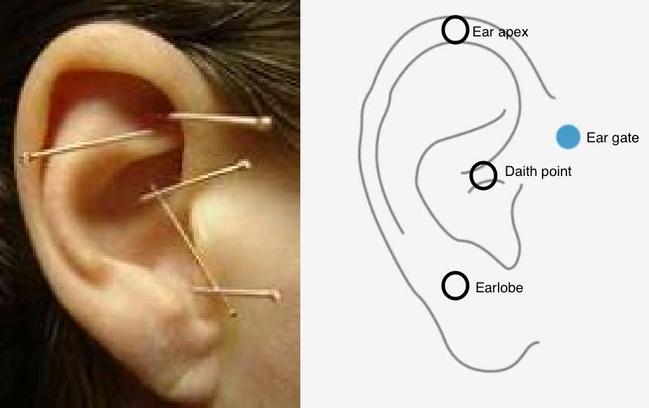
Source: balance4health
Beyond the ear, acupuncture extends to other areas of the body that may help with hearingrelated issues:
• Crown of the head (百会⽳) – Pressure on the top of the head has been linked to alleviating tinnitus
• Center of the forehead (印堂⽳) – Located just above the nose, this point may help relieve pain in the head, eyes, and ears
• Temples (太阳⽳) – Pressing on the temples is believed to ease head pain and support ear health
• Hairline points (发际点) – Found near the temples, these points may be effective in treating tinnitus, as suggested by some studies
These pressure points highlight the ear’s potential role in holistic health, offering a non-invasive approach to pain management While many individuals report positive effects, further scientific exploration is necessary to validate their effectiveness and understand the mechanisms in these traditional practices Acupuncture continues to provide a unique way to maintain and potentially improve hearing in our noisy modern world.
Ear drumming technique: A beat for better hearing
While acupuncture requires a skilled practitioner, the ancient Chinese ear drumming technique (鸣天⿎) is something you can try at home! This simple yet fascinating practice involves gently tapping the back of your head near your ears, to stimulate the auditory pathways. The rhythmic tapping helps boost blood circulation, unblock energy stagnation, and improve overall ear function.
In TCM, Qi is thought to flow through specific energy pathways By "drumming" the area around the ears, you’re helping to activate these pathways and support hearing health. It’s an easy and low-effort way to protect your hearing especially in a noisy world Try it for just a few minutes each day, and you might find that this ancient practice enhances your ear health.
Figure 2: Ear drumming technique to relieve tinnitus

Modern marvels: Cutting-edge innovations in hearing restoration
Gene therapy: A genetic leap forward
Gene therapy is making waves in the field of hearing restoration, offering hope to some deaf children in China, particularly for those with genetic causes of deafness Led by surgeon Yilai Shu at Fudan University, this innovative therapy specifically targets defects in the otoferlin gene, crucial for sound transmission
How do they do it?
This therapy specifically targets the otoferlin gene, essential for the function of hair cells in the inner ear, which are responsible for transmitting sound signals to the brain A defect in the otoferlin gene can prevent the production of otoferlin protein, which is necessary for effective sound communication leading to congenital deafness in some children
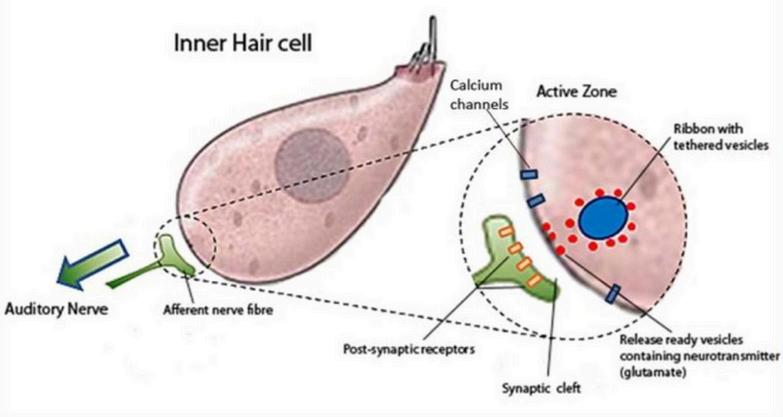
Source: Canadian Audiologist
Researchers use an adeno-associated virus (AAV) as a delivery system This virus acts as a tiny delivery truck modified to be harmless, carrying a replacement DNA for the otoferlin gene directly to the inner ear As the otoferlin gene is large (around 6,000 DNA letters long), it is divided into two parts, each packaged in separate viral vectors, injected into the cochlea--a fluid- filled chamber in the inner ear--ensuring that the genetic material reaches the targeted hair cells.
Once inside the cochlea, the two segments of the replacement DNA recombine to form a complete, functional otoferlin gene This new gene directs the production of the missing otoferlin protein, allowing the hair cells to function properly. This allows it to transmit the signals necessary for hearing to the auditory nerve, which sends these signals to the brain
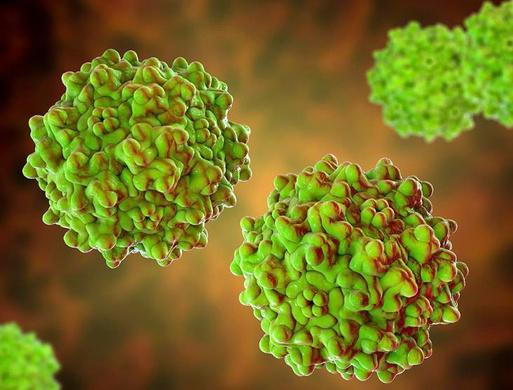
Triumph over silence: YiYi's inspiring journey
YiYi, a six-year-old girl born deaf, underwent gene therapy and can now hear her mother's voice Initial results show significant improvements in hearing ability YiYi moved from not hearing sounds above 95 decibels to hearing at 50-55 decibels (normal conversation level) This therapy allowed her to hear sounds for the first time, including the ringing of school bells
However, this treatment has limitations It specifically addresses otoferlin gene defects, which are rare causes of deafness Not all types of deafness can be treated with this method While cochlear implants remain an alternative, they often come with sound quality limitations Gene therapy, on the other hand, may offer a richer auditory experience.
Hair cell regeneration: Pioneering the future of hearing
Researchers at Harvard Medical School have developed a revolutionary approach to regenerate hair cells. They mark a significant breakthrough in hearing restoration.
The science behind hair cell regeneration
Hair cells cannot spontaneously regenerate in mammals, including humans Remaining hair cells in the inner ear cannot divide, and other inner ear cells cannot convert into new hair cells. However, Harvard researchers have developed a method using reprogramming, which involves turning the biological clock backward in the adult mouse cochlea to regenerate hair cells
Through single-cell RNA sequencing, the team identified over 20,000 genes and pathways, including Notch, Wnt, cAMP, and Myc, that enhance reprogramming efficiency. Importantly, they also discovered chemical compounds that activate these signals in the inner ear
A drug-like cocktail for regeneration
Researchers combined the identified chemical compounds into a “drug-like cocktail” and delivered it into the inner ear of an adult mouse with damaged hair cells. They then introduced theAtoh1 gene--a master gene for hair cell formation--into the cocktail-treated inner ear This combination remarkably reprogrammed the inner ear cells, leading to the regeneration of new hair cells
Figure 5: The regenerated hair cells (Green/Red double positive) were detected in the mouse cochleae after the cocktail/Ad Atoh1 reprogramming
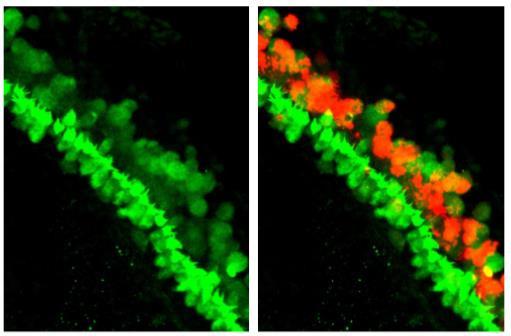
Source: genengnews com (Credit: Kateryna Kon/Science Photo Library/Getty Images)
A glimpse into the future
In successful animal studies, this technique has shown extraordinary results, regenerating hair cells and improving hearing function The next step? Human clinical trials, which researchers eagerly anticipate. This therapy aims to provide a long-term solution by addressing the root cause of hearing loss non-invasively, unlike traditional hearing aids or cochlear implants
How to safeguard your hearing every day?

Keeping our ears healthy is crucial for enjoying the sounds of life Here are some useful tips to prevent hearing loss in your daily routine:
• Limit exposure to loud noises: Avoid loud environments whenever possible Be mindful of both short bursts and long-term exposure to noise
•
•
Recognize warning signs: If you experience ringing in your ears, a feeling of fullness, or sounds seeming softer after noise exposure , it may indicate potential damage
Control volume levels: Keep music, TV, and radio volumes low enough to engage in conversation without straining. When using headphones, ensure the volume is not audible to others nearby
• Use hearing protection: Wear earplugs or earmuffs in noisy settings, such as workplaces or during activities like lawn mowing. Noise-canceling headphones can also block background noise
•
Take breaks: Step away from loud environments to give your ears a rest If attending events like concerts, take regular breaks and maintain distance from speakers
In conclusion, both traditional pressure points and modern gene therapy offer promising solutions for hearing loss By adopting simple lifestyle changes, we can also prevent hearing loss in our daily lives As we continue to explore and validate these methods, it is crucial to remain proactive about our hearing health.
https://www baystatehealth org/articles/hearing-loss-and-dementia
https://newsnetwork mayoclinic org/discussion/mayo-clinic-minute-how-hearing-affects-your-brainhealth
https://www alzheimers org uk/about-dementia/managing-the-risk-of-dementia/reduce-your-risk-ofdementia/hearing-loss
https://publichealth.jhu.edu/2021/hearing-loss-and-the-dementia-connection
https://www health harvard edu/blog/want-to-reduce-your-risk-of-dementia-get-your-hearingchecked-today-202302162891
https://www.healthyhearing.com/report/53003-Acupuncture-for-hearing-loss-or-tinnitus
https://gleneagles.hk/health-articles/chinese-medicines-and-acupuncture-help-treat-tinnitus-andhearing-loss
https://canadianaudiologist.ca/gene-therapy-for-children-with-deafness-we-are-almost-there-at-leastfor-single-gene-mutations/
https://www genengnews com/topics/translational-medicine/gene-therapy-restores-hearing-in-11year-old-after-just-one-month/
https://www technologyreview com/2023/10/27/1082551/gene-treatment-deaf-children-hearingchina/
https://brain harvard edu/hbi news/scientists-use-drug-like-cocktail-to-regenerate-inner-ear-cells-forhearing-recovery
https://hms.harvard.edu/news/scientists-regenerate-hair-cells-enable-hearing
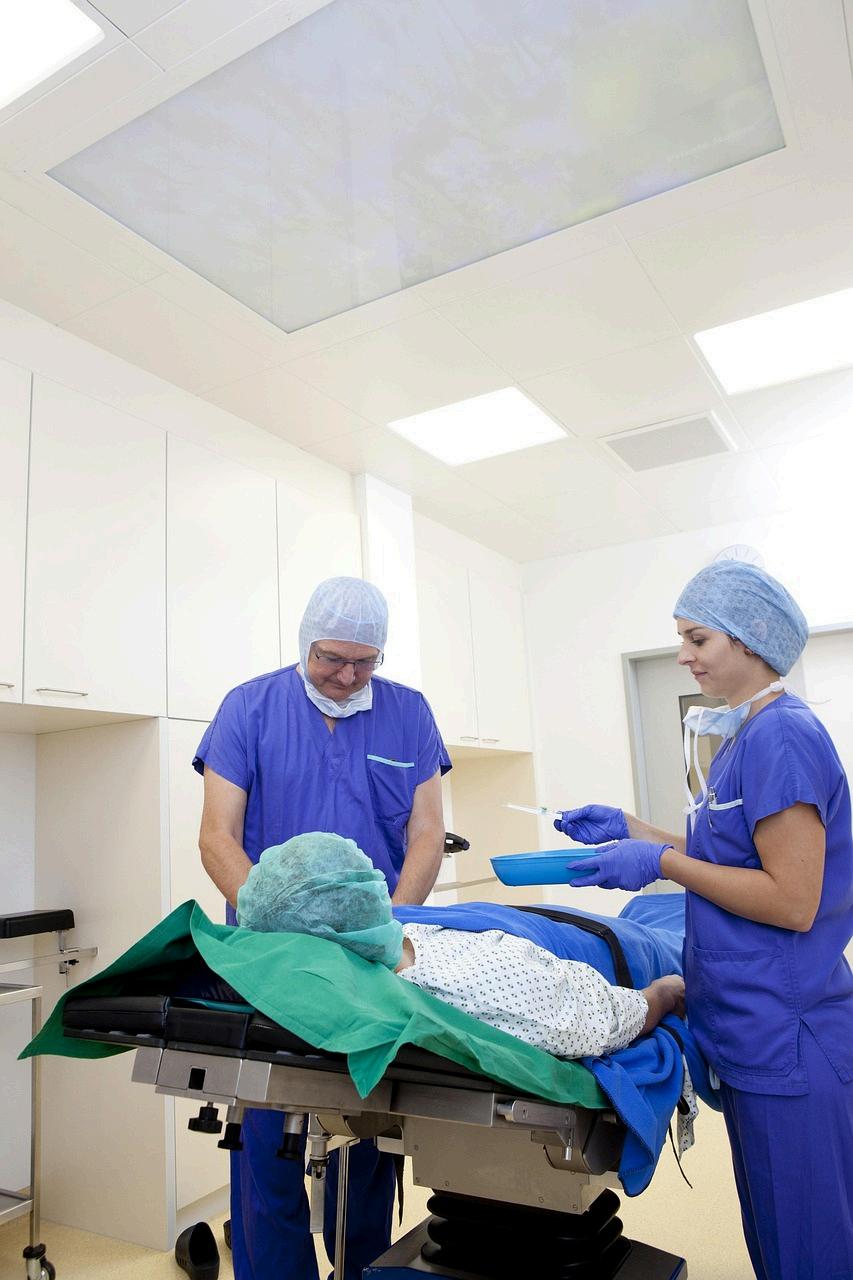
ComplicationsIn Pregnancy
by Ashley Mak
Complications that could happen during Pregnancy
1) Introduction
Pregnancy is a remarkable journey that brings a new life to the world, but it can also face many different challenges. Pregnancy complications are medical conditions that affect the mother or the fetus’ health during pregnancy. Complications can happen for many reasons; however, pre-existing medical conditions or brand-new ones can also cause some problems, therefore, in this article, we will discuss what can happen, how issues can be overcome and potential solutions.
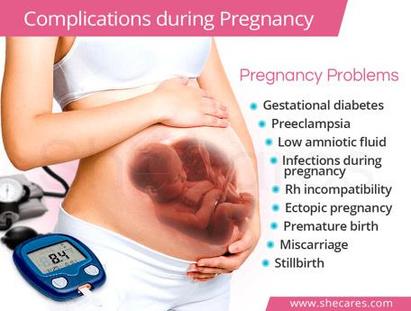
2) Why and what happens
Complications to pregnancy are not always because of the mother but could be of biological and unknown reasons. Most pregnancy complications often start during the first trimester. Some examples that occur to mothers during this time are amniotic fluid complications, bleeding, and miscarriages.
Amniotic fluid is the liquid in the sac around the fetus. It protects the baby and maintains the right temperature in the womb. Having too much fluid can be a sign of early breaking of the membrane and preterm labour, which also affects the mother by worsening shortness of breath for the mother. Common causes of this are diabetes, twins or triplets, infections, incompatible blood types and birth defects. Too little fluid can also be a sign of birth defects and problems with the placenta, slow fetal growth and early rupture of membranes or, unfortunately, fetal death.
Ectopic pregnancy is when an embryo is implanted somewhere besides the inside of the uterus. This is commonly in one of fallopian tubes that connects the ovaries to the uterus. An embryo implanting in the fallopian tubes is extremely dangerous and can’t be moved to the uterus According to John Hopkins, about 1% of all pregnancies are ectopic and about half of ectopic pregnancies occur with no known risk factors or explanation. This might be because of fertility treatments which can increase the risk of pelvic inflammatory disease or the result of previous tubal surgery. After one ectopic pregnancy, the risk for a second is 10%, and after a second one, the chance of a third increases to 25%.
Although these are some huge problems that some women face during pregnancy, there are also the risk of some minor complications. This includes high blood pressure, gestational diabetes and others.
High blood pressure is when arteries that carry blood from the heart to the body organs are extremely narrowed. Having high blood pressure during pregnancy is extremely dangerous as it makes it hard for blood to go to the placenta. The placenta is an organ that forms in the uterus during pregnancy. The umbilical cord is attached to the placenta and the baby for nutrients. Reduced blood flow can slow the growth of the baby and increases the risk of preterm labour.
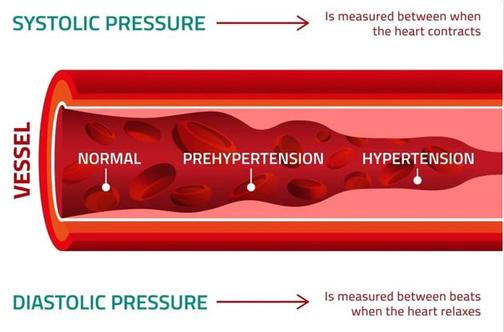
Figure 2: “High Blood Pressure.” , 19 July 2024, www.nhs.uk/conditions/high-blood-pressure/. Nhs.uk
Gestational diabetes happens when a woman who didn’t have diabetes before getting pregnant and starts having it during the pregnancy. When this happens, people’s hormones change and causes them to not make enough insulin or not use it normally.
Solutions to the problems
Some of these problems are avoidable and can be addressed, some, like ectopic pregnancy, are not. Women who have high blood pressure before they get pregnant will be asked to monitor it daily and take medications. Normally high blood pressure happens during the second half of pregnancy and often goes away after delivery. Addressing gestational diabetes requires care treatment from a health care provider. According to the NHS, the best way to manage gestational diabetes is to have a healthy diet and maintain exercise where possible. In extreme cases medication, including insulin can be given.
Conclusion
Although some people may believe that pregnancy is harmless and will not have that many problems, however, as you can see, there is quite a lot of risks and dangers for the mother and the fetus. This includes ectopic pregnancy, the amount of amniotic fluid, gestational diabetes and high blood pressure. Some untreatable complications will result in the loss of their baby and while those that are treatable will need close monitoring and will go away after birth.

Citations:
1) Espinosa, Camilo, et al. “Data-Driven Modeling of Pregnancy-Related Complications.”
Trends in Molecular Medicine, vol. 27, no. 8, Aug. 2021, pp. 762–776,
https://doi org/10 1016/j molmed 2021 01 007
2) NIH. “What Are Some Common Complications of Pregnancy?”
Http://Www.nichd.nih.gov/, 29 May 2024, www.nichd.nih.gov/health/topics/pregnancy/conditioninfo/complications.
3) NIH. “What Are Some Common Complications of Pregnancy?”
Http://Www.nichd.nih.gov/, 29 May 2024, www.nichd.nih.gov/health/topics/pregnancy/conditioninfo/complications.
4) “Complications during Pregnancy.” SheCares, www shecares com/pregnancy/complications
5) “The 5 Most Common Pregnancy Problems & Their Solutions.”
6) “Gestational Diabetes - Treatment.” Nhs.uk, 20 Oct. 2017, www.nhs.uk/conditions/gestational-diabetes/treatment/. , Pe lvi car e.uk https://pelvicare.uk/blog/the-5-most-common-pregnancy-problems-their-solutions
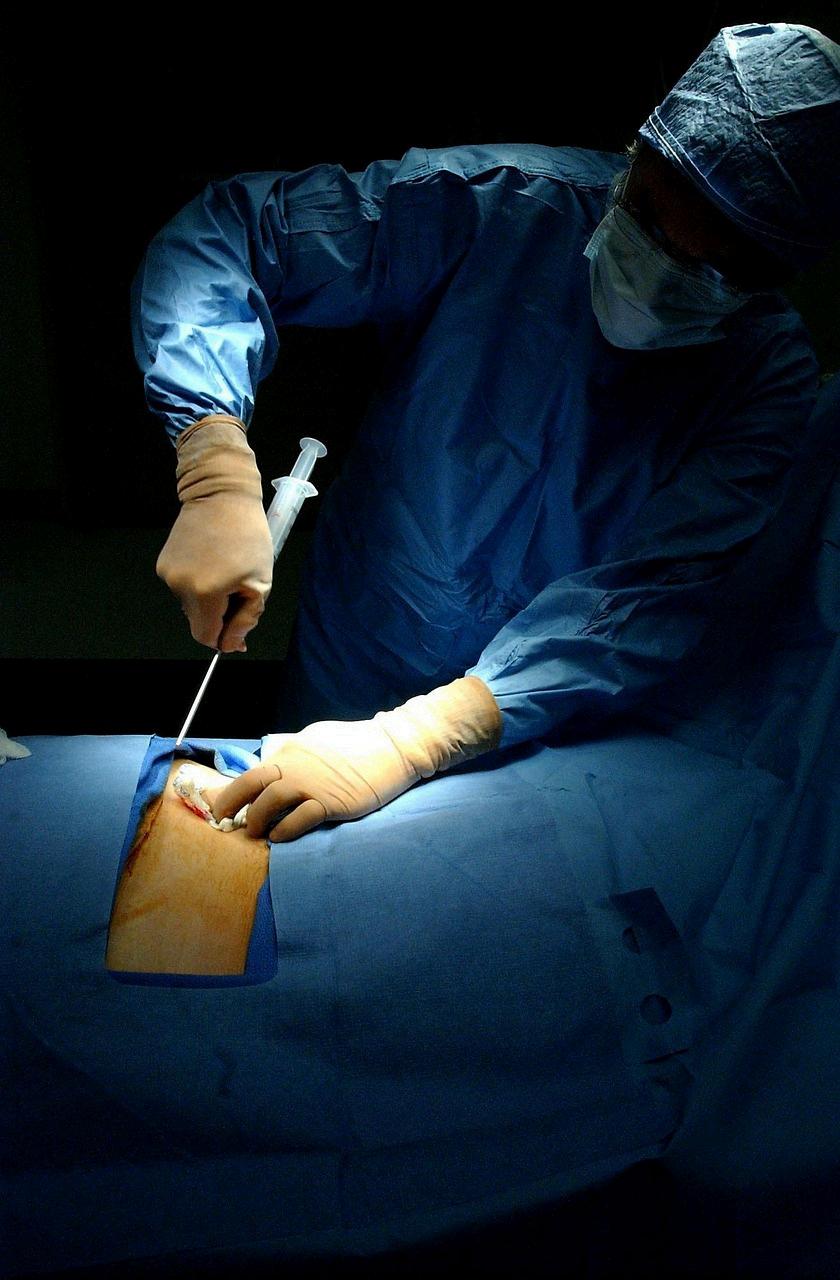
Justthemerementionof“cancer”neverceasestoevokegraveanxiety Whetheritisbeingsaidtofamily,friends,or yourself,itundeniablytriggersarelentlesswhirlpoolofdread.Itisnosurprisethatscientistsaredeveloping treatmentstocombatsuchaformidabledisease.Thisarticleexploressomeoftherecentbreakthroughsincancer treatmentsandthehopeforfurtherpersonalisedtherapiesinthefuture.
AccordingtotheOxfordLanguagesDictionary,cancerisdefinedasadiseasecausedbyanuncontrolleddivision ofabnormalcellsinapartofthebody. Today,manyongoingstudiesarefocusedontheadvancesinprecision medicine,specificallythemulti-omicsapproach.ItincorporatestheanalysisofDNAandRNAandenhancesthe possibilitiesofpersonalisedtreatmentstrategieswhileminimisingsideeffects(Gambardellaetal.,2020).This approachallowsamorecomprehensiveunderstandingoftumourbiology,intra-tumourheterogeneityaswellas thedevelopmentofimmunedefencemechanisms Thisfacilitatestheidentificationprocessofindividual-specific biomarkers,suchastheKRAS(Kirstenratsarcomavirus)andMSI(microsatelliteinstability),whicharemutantspecificmoleculesthatareprevalentinvarioustumourtypes.Thesurgingawarenessofthishaveopened pathwaysfortargetedtreatments,focusingononcogenicdriversoftumoursandwaystomodulatethetumour immuneenvironmentwhilstmaintainingorganfunctiontoaimforthehighestqualityoflifepossible(Hoebenetal., 2021).
Incertaincancerssuchascolorectalcancer,scientistshavealreadyunravelledthegeneticandepigeneticevents leadingtocarcinomaformation,allowingfortheimplementationoftumour-tailoredtreatments.However, limitationstothemulti-omicsapproachexistastherearecancersinwhichthetumorigenesisprocessisnotdefined yet,suchaspancreaticductalcarcinomaandglioblastomas.Thusfar,onlylimitedprogresshasbeenmadeby slowlyincreasingtheoriginal5-yearoverallsurvivalrateofpatientswiththesetumours(Regeletal.,2020).As mentionedabove,onesignificantadvantageofthisnewapproachistheelucidationofintra-tumourheterogeneity, whichiswhenadiversecellpopulationexistswithinonetumour.Agoodexampleofthiswouldbein glioblastomaswheremultiformextensivesingle-cellsequencingisused.Studieshaveshownthatthereisalarge intra-tumoralheterogeneity,meaningthatonesingletumourconsistsofmultipletumourclones,eachwith significantgeneticandepigeneticdifferences.Thiscomplicateseffortstoidentifyspecificoncogenestotarget sinceitcouldfacilitaterapidtumourreproductionthroughmechanismslikegenomicinstabilityandphenotypic diversity,hencetreatmentisnotyeteffective.WhileHoebenetal.,(2021)outlinetheaccompanyingsideeffectsof personalisedandprecisionmedicineincancer,italso
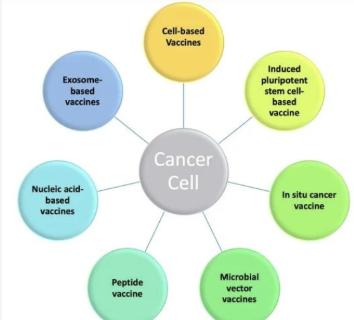
highlightsitsrecentadvancementsand continuousdevelopmentoftumour-tailored treatmentsthatwillhopefullyimprove prognosticmodelsandtheemergenceof patient-tailoredtreatmentplans
Next,recentinnovationsinimmunotherapy havealsobeenabeaconofhopeforcancer patients,particularlythroughtheexpansionof immunotherapyandmaturationofvaccines Althoughallcancervaccinesshareacommon primarymechanismofactivatingTcellstokill cancercells,theydifferlargelyintheirspecifics andsuccessrates.
Eachcancervaccineisaimedtopreventtumourgrowth,recurrenceormetastasiswhilstallowingtheimmune systemtoenhanceitscapacitytoidentifyandmitigatecancercells.IttargetsTAAs(tumour-associatedantigens), whicharespecificproteinsexpressedbycancercellsthatactivateTcells,Bcellsandotherimmunecellswhich depletescancercells.CancervaccineshaveevolvedsinceWilliamB.Coleydevelopedthefirstimmunotherapy drugutilisedfortreatingmalignanttumoursin1891.HeusedStreptococcalbacteriatostimulateimmune responsesinpatientswithboneandsofttissuesarcomas Suchsuccesssparkedthedevelopmentofcancer vaccines,whichinrecentyearshaveseenpositiveoutcomesinlivercancer,cervicalcancer,coloncancer,etc.
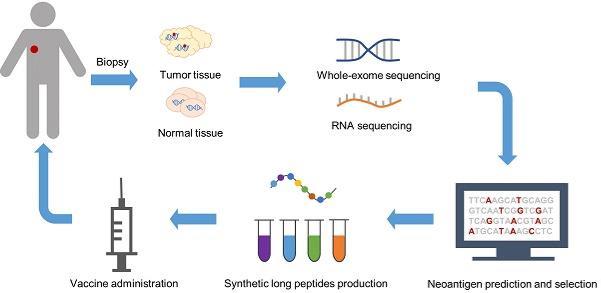
Personalisedneoantigenvaccineshaveemergedin2024,whichtargetsneoantigens–proteinsthatcancercells acquireasitmutates(naturevideo,2024).ThismethodrequirestheextractionofmRNAfromthetumour,whichis thensequencedinthelaboratorytoidentifythegenerequiredtoformitsneoantigens Themostpowerfulgenes arechosenandinjectedintothebody,wheredendriticcellsidentifyitandactivateTcells.Thisbespoketreatment hasshownprogressintreatingmelanomasandpancreaticcancer.Aflowdiagramisshownbelow: Themaindistinctionofthistechniqueliesinitsrequirementofgeneticmaterial,-Forexample,intheex-vivocell vaccine,neoantigensareintroducedtodendriticcellsinapetridishandinjectedintothebody,andforin-situ cancervaccines,patientsaregivendendriticcellactivatorssimultaneouslywithtreatmentsuchasradiotherapy. Requiringgeneticmaterialforsuchvaccinescarryitsadvantagesanddisadvantages.Enablingthecreationof personalisedvaccinesaccordingtoeachperson’sspecifictumourmutationscouldpotentiallyenhanceimmune responseaswellasbeingincreasinglypreciseandtarget-specific,asonlycancerouscellsarekilledratherthan normalsomaticcells However,somenotablechallengesincludethetime-consumingaspectofidentifying cancerousmutationsandthesignificantincreaseincost,leadingtoanimbalancedaccessibilitytopatients.
Finally,CAR(chimericantigenreceptor)Tcelltherapyhaveseenadvancementsinhaematologicmalignancies, morecommonlyknownasbloodcancer(Medicurio,2023).CARTcellsaregeneticallymodifiedTcellsthatare usedtokillcancercells.Tcellactivationisatwo-stepprocessoutlinedbelow:
1 InteractionofMHCmoleculeholdingantigenbeingrecognisedbyTcell receptor.
TheMHCmoleculeholdsanantigenfoundonapathogenandbindstoits respectiveTcell.ThisinteractionactivatestheTcellsignallingareaCD3zeta, whichtriggersstep2:
2.Aco-stimulatorysignal,aconfirmationthatthebodyisunderattack Tcellsarethenactivatedandmultiplied.WithCARTcells,thereceptoris engineeredtocontainthreedomains:binding,signallingandtransmembrane, eachwithitsspecificcharacteristicsanduses.
Asof2023,thereare6CARTcelldrugsapproved,withthefirstonebeing Kymriahin2017.
Due to this being a lengthy process, requiring a preparation period of around one month, this method is often used as a last resort. However, researchers are now attempting to position CAR T cell therapy as an initial treatment This approach encapsulates the potential of genetic bioengineering, as scientists continue to refine T cells to reduce side effects, cost and modification time amidst the risk of rejection.
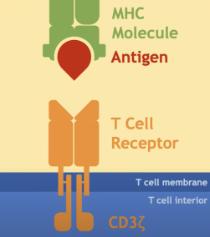

In conclusion, the complex landscape of cancer treatment is undergoing a transformative shift, driven by the multitude of recent breakthroughs in personalised treatments for cancer, such as immunotherapy and CAR T cell therapy. With the integration of precision medicine, scientists are paving the way for tailored treatments such as multi-omics strategies which could have a higher success rate. Treatment innovation serves as a bridge for instilling hope to those affected by cancer, and although cancer remains one of the deadliest diseases, with each breakthrough, we move one step closer to transforming this adversary into a manageable and curable condition.
References
Chen,X,Yang,J,Wang,L,&Liu,B (2020) Personalizedneoantigenvaccinationwithsyntheticlongpeptides: recentadvancesandfutureperspectives.Theranostics,10(13),6011–6023.https://doi.org/10.7150/thno.38742 Gambardella,V.,Tarazona,N.,Cejalvo,J.M.,Lombardi,P.,Huerta,M.,Roselló,S.,Fleitas,T.,Roda,D.,&Cervantes,A. (2020).PersonalizedMedicine:RecentProgressinCancerTherapy.Cancers,12(4). https://doi.org/10.3390/cancers12041009
Hoeben,A,Joosten,E A J,&vandenBeuken-vanEverdingen,M H J (2021) PersonalizedMedicine:Recent ProgressinCancerTherapy.Cancers,13(2),242.https://doi.org/10.3390/cancers13020242
Kaczmarek, M., Poznańska, J., Fechner, F., Michalska, N., Paszkowska, S., Napierała, A., & Mackiewicz, A. (2023). Cancer Vaccine Therapeutics: Limitations and Effectiveness—A Literature Review. Cells, 12(17), 2159. https://doi.org/10.3390/cells12172159
Medicurio (2023, September 5) CAR T Cells: Beating Cancer with the Immune System Www.youtube.com. https://www.youtube.com/watch?v=QTUO0P Frhs nature video. (2024, March 27). Cancer-busting vaccines are coming: here’s how they work. YouTube. https://www.youtube.com/watch?v=SpvhJSGddL0 Regel, I., Mayerle, J., & Ujjwal Mukund, M. (2020). Current Strategies and Future Perspectives for Precision Medicine in Pancreatic Cancer Cancers, 12(4), 1024 https://doi.org/10.3390/cancers12041024
Parkinson’sDiseaseand Treatment

by Audrey Yu
1.Introduction
Parkinson’sdiseaseisaneurodegenerativedisordertypicallycharacterisedbythebradykinesia-orslowingof movement,therigidityoftremor-basedmovement Whereasthemovementdisordersymptomsdevelopdueto thelossofdopaminergicneuronsofthe‘substantianigraparscompacta’.(Koulietal.,2018), Parkinson’sismore commonlyknownasthediseasethatcausesadopamineproductiondeficiencyinthecentralnervoussystem,or lackofdopamineactiononthesympatheticnervoussystem.
2.Parkinson’sDiseaseOverview
2.1Pathogenesisandtheonsetofthedisease
Parkinson’sdiseaseistypicallyassociatedwiththedepositionofaggregatedα-synuclein.Asmentioned,itismore wellknownforthedisruptionofdopaminergicandnon-dopaminergicneuralnetworks.Researchershave generallyhadlittlesuccessinproducinghypothesesorworkingmodelsontheearlyclinicaldevelopmentofthe idiopathicdisorder.(Adametal.,2023)
TheideathatParkinson’sisdevelopedduetodamagetothebraincanbetheorised,asLewybodieshavebeen foundinthebrainofsomepatients.Thisdemonstratesthemolecularneurodegenerationofthebrain,asLewy bodiesareabnormaldepositscausedbyα-synuclein,producedwhenneuronsdegenerate.(Outeiroetal.2019). Again,aspatientsdiagnosedwithdementiadisplayanobviouslackofdopaminewithintheirsystems,other studieshavealsodiscoveredlinksbetweenalossofdopaminergicneuronsinthestriatumofParkinson’spatients andtheincreasingonsetofthedisease.Thisshowsadirectlinkthatcelldeathdoesindeedcausedisturbancein dopamineproduction.(Ivanidzeetal.2020).
ThecauseofParkinson’sdiseasecouldbeduetoavaried,complexmixofageing,geneticsusceptibilityand environmentalchanges,meaningthatasingulardeterminedsourceforthepathogenesiscan’tbedetermined. However,thereisageneraltrendthatα-Synucleinprotofibrilsdisruptcellularhomeostasisandmediateneuronal deathviaintracellulartargets.Secretedα-synucleinmayexertdeleteriouseffectsonneighbouringcells.(Stefanis, 2011).Thisα-SynucleinproteincanbefoundwithinthepreviouslymentionedLewybodieswithinthebrainstem, limbicandneocorticalareas.Overall,theonsetandpathogenesisofParkinson’scanbeassumedtobeduetothe developmentofLewybodiescontainingtheα-Synucleinproteinwithinthenigrostriatalpathwaysofthebrainas theyareamarkerofneuronaldegeneration.
2.2Riskstowardsonset
FollowingtheestablishedideathatParkinson’sistypicallyidiopathic,withtherebeinganunknownrootonset cause,it’sdifficulttoignorethattherearemanyriskfactorsandnoticeablesymptomsthatmaycauseittodevelop Here,theriskfactorssuchasage,genetics,priorinjurytotheheadorcentralnervoussystem,andcertain medicationswillbeexplored.
Parkinson’sdiseasehasbeenassociatedwithagingfordecades.“ItisclearthatParkinson’sDiseasechanceof onsetincreaseswithincreasingage Ananalysisof47epidemiologicalstudiesofParkinson’sworldwidespanning theyears1985to2010confirmsthishypothesisofpositivecorrelation.AsParkinson’scanprogressivelybeseento beincreasingapproximately10-foldbetweentheagesof50and80.”(Collieretal.,2017).Ultimately,ageisthe mostobviousriskfactorforParkinson’sasawhole,asdopamineconcentrationsdecreaseandnigralcells degeneratewithage.
Additionally,drug-inducedParkinson’sisrecognisedasthesecondmostprevalentcauseoftheonsetofthe disease.Forexample,antipsychoticchlorpromazine(andtypicalantipsychoticdrugs)canresultinadverse extrapyramidalsymptoms(EPS)withinpatients,asseenthrough40%ofpatientssufferingfromsuch.It’sa
generaltrendthatpatientstakingantipsychoticshavearelativelyhigherchanceofdevelopingEPSandtodevelop Parkinson’sasdopaminereceptorsaredistributedthroughoutthebrainandmaybeaffectedbythe extrapyramidalactionsofthesedrugs.
Ontheotherhand,extremeenvironmentalexposurecanalsocauseParkinson’s.ThereareafewcasesofPD associatedwiththepotentneurotoxin1-methyl-4-phenyl-1,2,3,6-tetrahydropyridine(MPTP)(Vendaetal,2010) However,MPTPcasesonlydisplaysimilarissuessuchasthegrowinglackofdopaminecellswithinthesubstantia nigraandusuallyaren’tduetothesamebiologicalcausesastypicalParkinson’s.
2.3Symptomsandhowitactsuponthebody
Motor
Asfollowingtheonsetofthedisease,it’smostunderstoodthatmotorsymptomsarethemainfactorsthataffectthe quality-of-lifefollowingParkinson'sdisease.ThemainmotorsymptomsofidiopathicParkinson’sdiseaseareresting tremor,bradykinesia,rigidity,andposturalreflexdisturbance.(Gokcaletal.,2016)
InastudybyGokcaletal,2016,aseriesofquantitativesurveyswereconductedamongst100Parkinson’spatients toinvestigatetheimpactsoftheadverseeffectsontheirlifestyle.Tocontroltheresults,thegroupsweresplitfurther intogroupsbasedonhowlongthey’vesufferedfromthedisease(5years>and<5years),andtheirsocioeconomic statuseswerealsoconsideredtomakeresultsfairer.Furthermore,patientssufferingfromadditionaldisorderswere excludedfromthetest.Itwasdeterminedthatanaverageof89.1%ofpatientsfrombothgroupssufferedfroma commonsymptomoftremors,otherthanthis,themainmotorsymptomsalsoincludedbradykinesiaat827%, crampsat64.5%,slowinggaitat63%,andconstipationat56.2%.
ToinvestigatefurtherintotheparticularsofthesymptomsofParkinson’sdisease,thetremortypicallyfollowingthe onsetdiffersfromthetraditionalessentialtremor.Whilstessentialtremorsstartwithabimodalageofonset,and typicallyshowsfrommovementtorest,Parkinson’stremortypicallyincreaseswithage,whileoccurringfromthe pathwayofresttokineticmovement.Essentialtremorsalsocommonlyaffectthehands,legs,head,andvoice. WhilstinParkinson’sdisease,cardinalsymptomscanalsoincludearangeofotheradverseeffectsincluding bradykinesia,rigidity,tremor,andgait/balanceissues.Additionally,Parkinson’stremorusuallyonlyimpactsthe upperandlowerextremities,whilethechin,jaw,headandvoicearegenerallyunaffected.(BrynMawr Communications,nd)
Toclarify,tremorisnotanecessarysymptomforParkinson’stobediagnosed,whereasbradykinesiaandlow dopaminelevelsare.FurtherkeyfeaturesintheprocessofdiagnosingParkinson’sarealsogait-disturbanceand rigidity,withexamplessuchasmicrographiabeingpresentedassymptoms.(Zafar&Yaddanapudi,2023) Parkinson’salsoevidentlyaffectsautonomicfunction,andassuchsymptomssuchasorthostatichypotension, constipation,difficultyswallowing,urinaryretention,anderectiledysfunctionarecommon.However,unlikethe previouslymentionedsymptomssuchasrigidityandbradykinesia,thesesymptomscannotbeaidedbytreatment.
Non-motor
ThepathologyofParkinson’sdiseaseisnotsolelyconfinedtothenigrostriatalpathway,becauseLewybodiesare alsofoundinthecortex,amygdala,locuscoeruleusandperipheralautonomicsystem.(Koulietal.,2018). DysfunctionoftheseextranigralneuronsandthepresenceofLewybodiescanalsocorrelatewiththenon-motor manifestationsofParkinson’sdisease,excludingparasympatheticandsympatheticfunction-includingautonomic, sleepandolfactorydysfunctionscanalsobeperceivedasimpactsofadversesymptomsofonsetParkinson’s.
Asmentioned,theeffectsoftheα-Synucleinproteincausingneurodegenerationoutofthesubstantianigrais evidentthroughkeysymptomssuchasdrooling,mooddisorderanddepression,REMsleepdisorder,and anosmia.(Zafar&Yaddanapudi,2023)
2.4Severities
Parkinson’sisagenerallyanextremelycomplicateddisease,withcomplicationsbeingabletoconstantlydevelop andspiralastheonsetdevelops.Forexample,motorsymptomsmayworsenandseriousnon-motorcomplications likepsychosis,orthostatichypotensionorsleepattackscanbegintooccurregularly.Thedisordercancreatesuch complicationsduetomotordeteriorationorgradualneuropsychosis.Emergencycasescanrequireimmediate hands-ontreatment,medicalattentionandmultidisciplinarycare
ThementionedcasestudiesareexamplesfromastudybySimonetetal.,2019.
OneofthemainmotorconsequencesofextremeParkinson’ssymptomswouldbeParkinson’s-induced hyperpyrexia.Forexample,a73-year-oldman’sParkinson’shadworsenedquicklydespiteaconstantthree-month intakeoflevodopa(1200mg),withbradykinesiaandrigidityconstantlyworsening Furthermore,hisresponseto dopaminergictherapyremainedverylow,whichlateralsocausedhimtodevelopashortnessofbreathand tachycardia.Toaidthisissue,levodopahadtobeimmediatelyadministeredthroughanasogastrictubealongside aggressivephysiotherapy.Despiteallefforts,itwasshownthathisdailylifestylewassignificantlyimpaired,proving thatParkinson's-especiallytheextremecases,iseffectivelyincurable.InanotherstudybySimonetetal.,2019, extremenon-motorsymptomsarealsoexplored Thecasestudymainlyfollowstheextremeacutepsychosisofan 80-year-oldwoman.Shedisplayedmajorsymptomsofmarkedagitationandparanoidideation,whichspiralled intofrequentdelusionswiththelossofinsightandlatervisualhallucinations.Changesinhertakendrugdosages hadtobemadetoslightlyimprovehercognitivefunctionthreemonthslater.
3.Treatments
3.1Physicallyfocusedtreatments
AsParkinson’sisadiseasethatmajorlyaffectsthemotorfunctionofpatients,itgoeswithoutsayingthatphysically focusedtreatmentscanhelpimprovethegenerallifeandmotorabilityofpatients.Examplesofsuchtreatments canincludephysicalexercise,activityandphysiotherapy FocusingbackonthemotorsymptomsofParkinson’s, thesearemainlydonetoimproverigidity,slowinggait,bradykinesia,etc.
WhilstParkinson'sdiseasetreatmentnowisstillprimarilyfocusingonsymptomaticcontrolthroughdopaminergic medication,thismaynotbeeffectivefortheentirespectrumofParkinson’ssymptoms.Asphysicalactivityand exerciseisgenerallycategorisedbytheskeletalmovementofthebody,basicfoundationsofsportsscienceand physiotherapycanallowpatientstolearntoregainsomecontrolovertheirlostmotorability.Physiotherapyisa therapeuticinterventionthatusesaholisticapproach,withoutinterferingwithanybiochemical,pharmaceutical drugs.Itgenerallyaimstorestoreandimprovethequalityofmovement.(Bouça‐Machadoetal.,2019).Thiscan generallybepreferredandusefulasitcanbeachievedthroughhometherapyaswell,makingitmoreeasily accessible
InastudyledbyRadderetal.,2020,aninvestigationoftheeffectivenessofphysiotherapyonpatientsufferingwas conducted.“Atotalof191trialswith7998participantswereincluded.Conventionalphysiotherapysignificantly improvedmotorsymptoms,gait,andqualityoflife.”(Radderetal.,2020)Activitiessuchasresistancetraining, dance,Nordicwalking,andmartialarts,allhelpedwithnotonlygait,butalsobalance,bradykinesia,andregaining controlovermotormovements.Therefore,itcangenerallybesaidthatphysicaltreatmentscannotonlyimprove thedrawbacksofParkinson’sbutcanalsohelpwiththedailylivesofpatients.
3.2Surgery-DBS
FormoreextremecasesofParkinson’s,whereessentialtremorsareuncontrolled,DeepBrainStimulation(DBS) canbeconsideredasaviabletreatmentpathway.DBSisaneurosurgicalprocedurethatimplantsbrainelectrodes andaneurostimulatorandcanalmostbeconsideredliketheneurologicalversionofacardiovascularpacemaker. Insteadofcontrollingtheheartthroughelectricalimpulses,itinsteadcontrolsthebrainanditsdynamicfunction. ThismethodwasinitiallyintroducedtocontroltheeffectsoftheessentialtremorfollowingtheonsetofParkinson’s disease.
However,therisksthatareassociatedwithsuchtreatmentcanbeconsideredasfluctuatingorhardtoconsiderat times,astheadverseeffectsmayimpactpatientsdifferently.Mainconcernsofthetreatmentincludebeingunable toaskthecorrectquestionstoalludetotheconcernsorsideeffectscomingfromthetreatment Also,anothermain concernbroughtupistheissuethatsymptomsarehardtodifferentiatefrompre-existingissuesorsideeffects followingthetreatment.(FaribaandGupta,2023)
4.DrugUsage
4.1LevodopaandCarbidopa;usages,sideeffects,mechanisms
ThemostcommondrugsutilisedinthetreatmentandcontrolofParkinson’sdiseasearelevodopaandcarbidopa. Tounderstandthis,theirmechanismsandextentofusefulnesswillbediscussedbelow.
Levodopa
LevodopaiswidelyknownasthemostsuccessfuldopaminereplacementagentinthetreatmentofParkinson’s disease.Levodopaiscommonlyprescribedtoapatientwhensymptomssuchasbradykinesiaseemtobedifficult tocontrolwithotheranti-parkinsonismdrugs.Thedrugcanalsobeusedforpostencephaliticparkinsonism (Parkinson’sinducedbytheswellingofthebrain)andsymptomaticparkinsonismduetocarbonmonoxide intoxication.(GandhiandSaadabadi,2023).
SomeotherbenefitsoflevodopaotherthanbeingabletocontrolmotorsymptomsofParkinson’sisitsabilityto carryonitspositiveimpactonthepatientevenafterdrugadministration.Inmostrecentstudies,atrendof LevodopabeingabletoslowdownthedevelopmentofidiopathicParkinson’shasalsobeenshown.
Levodopaistypicallyadministeredthroughfourdifferentmethods,immediatereleasetablets,disintegrating tablets,controlledreleasetablets,andextended-releasecapsules Itsmechanismofactioncanbefollowedbythe knowledgethatthisdrugisaderivativeofphenylalanineandisthemetabolicprecursorofdopamine.Levodopa crossesthebloodbrainbarrierandisconvertedtodopamineinthepresynapticterminalsofdopaminergic neurons.((NationalInstituteofDiabetesandDigestiveandKidneyDiseases,2021).Afteritsrelease,itisthen transportedbacktodopaminergicterminalsorismetabolised.Generally,it’saveryversatiledopamine replacementagent
Carbidopa
Carbidopaworkshandinhandwithlevodopa, asitblockstheconversionoflevodopatodopamineoutsideofthe centralnervoussystem.Therefore,itinhibitsunwantedsideeffectsoflevodopaonorganslocatedoutsideofCNS. (Zhuetal,2017)
Ascarbidopaisinthedecarboxylaseinhibitorclassofdrugs,it’sadministeredalongsidelevodopa.Thiscanbe seenthroughimmediatereleasetablets(withaperipheralinhibitorinaction),intestinalgelinfusions,orextendedreleasetabletsthatreleasethedrug4-5hoursafterconsumption.Eachmethodoradministrativerouteaimsto maximisethedrug’sabilitytobefastacting,longlasting,andeffective (LeydenandTadi,2023)
5.CitationsandReferences
(Koulietal.,2018)“Parkinson’sDisease:PathogenesisandClinicalAspects”
https://www.ncbi.nlm.nih.gov/books/NBK536722/
(Adametal,2023)“AnupdateonpathogenesisandclinicalscenarioforParkinson’sdisease:diagnosisand treatment”
https://pmc.ncbi.nlm.nih.gov/articles/PMC10134733/
(Outeiroetal.2019)DementiawithLewybodies:anupdateandoutlook
https://linkspringercom/article/101186/S13024-019-0306-8
(Ivanidzeetal.2020)“MolecularImagingofStriatalDopaminergicNeuronalLossandtheNeurovascularUnitin ParkinsonDisease”
https://www.frontiersin.org/journals/neuroscience/articles/10.3389/fnins.2020.528809/full
(Stefanis,2011)“α-SynucleininParkinson'sDisease”
https://pmc.ncbi.nlm.nih.gov/articles/PMC3281589/
(Wakabayashietal.,2007)“TheLewybodyinParkinson'sdisease:moleculesimplicatedintheformationand degradationofalpha-synucleinaggregates”
https://pubmed.ncbi.nlm.nih.gov/18018486/
(Collieretal.,2017)“AgingandParkinson’sDisease:DifferentSidesoftheSameCoin?”
https://pmc.ncbi.nlm.nih.gov/articles/PMC5844262/#:~:text=An%20association%20between%20aging%20and,b een%20recognized%20for%20several%20decades.&text=Aging%20is%20the%20number%20one,some%20mo dels%20of%20its%20etiology.
(Shin&Chung,2012)“DrugInducedParkinsonism”
https://pmc.ncbi.nlm.nih.gov/articles/PMC3325428/
(Vendaetal.,2010)“α-SynucleinanddopamineatthecrossroadsofParkinson’sdisease” https://pmcncbinlmnihgov/articles/PMC3631137/#:~:text= (a)%20When%20%CE%B1%2Dsynuclein,an%20increase%20in%20dopamine%20release.
(Gokcaletal.,2016)“MotorandNon-MotorSymptomsinParkinson’sDisease:EffectsonQualityofLife” https://pmc.ncbi.nlm.nih.gov/articles/PMC5491664/
(BrynMawrCommunications,n.d.)“DistinguishingEssentialTremorFromParkinson'sDisease” https://practicalneurology.com/articles/2012-nov-dec/distinguishing-essential-tremor-from-parkinsons-disease
(Zafar&Yaddanapudi,2023)“Parkinson’sDisease” https://wwwncbinlmnihgov/books/NBK470193/
(Simonetetal.,2019)“EmergenciesandcriticalissuesinParkinson’sdisease” https://pmc.ncbi.nlm.nih.gov/articles/PMC7029239/
(Bouça‐Machadoetal.,2019)“PhysicalActivity,Exercise,andPhysiotherapyinParkinson'sDisease:Definingthe Concepts”
https://pmc.ncbi.nlm.nih.gov/articles/PMC6962680/
(Radderetal.,2020)“PhysiotherapyinParkinson’sDisease:AMeta-AnalysisofPresentTreatmentModalities”
https://pmc.ncbi.nlm.nih.gov/articles/PMC7564288/
(FaribaandGupta,2023)“DeepBrainStimulation”
https://www.ncbi.nlm.nih.gov/books/NBK557847/
(GandhiandSaadabadi,2023)“Levodopa(L-Dopa)” https://www.ncbi.nlm.nih.gov/books/NBK482140/
(NationalInstituteofDiabetesandDigestiveandKidneyDiseases(2021))“Levodopa” https://www.ncbi.nlm.nih.gov/books/NBK548734/
(Zhu,H.etal.(2017))“Carbidopa,adruginuseformanagementofParkinsondiseaseinhibitsTcellactivationand autoimmunity,'PLoSONE,12(9),p.e0183484”https://doi.org/10.1371/journal.pone.0183484
(Leyden,E.andTadi,P.2023)“Carbidopa” https://wwwncbinlmnihgov/books/NBK554552/

AnIntroductiontoDeepSeaGigantism
by Sunny Hung
The‘DeepSea’isdividedintothreemainzones:mesopelagic,bathypelagicandabyssopelagiczones.
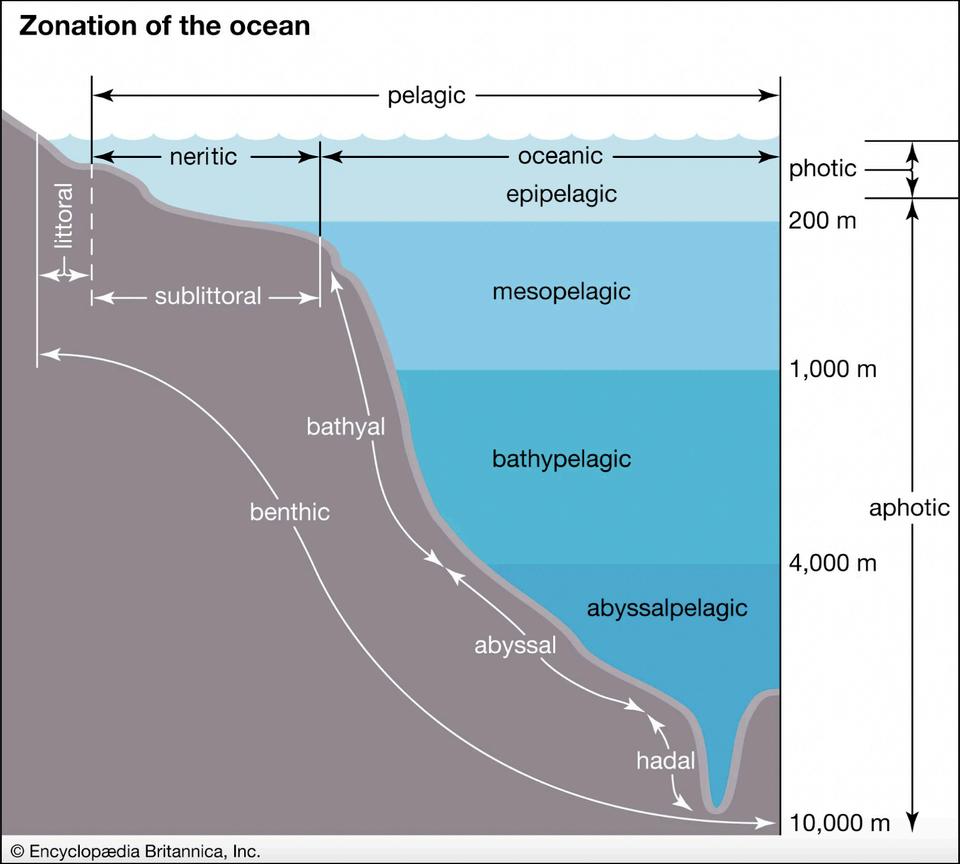
Inthedeepdarkcornersoftheearth,conditionsareharsh,andsurvivalishard.Organismsthatliveheresurvivethe pressureofatleast1500psi1inthemesopelagiczone,temperaturesrangingbetween2-3°C,andextremefood scarcity Thosethathopetothriveandlivelongenoughtoreproduceherepossessuniqueadaptationssuchas bioluminescenceinanglerfish,thatgivethemanedgeoverallotherorganismstheycompetewith.
Deep-seagigantismisonesuchphenomenoninwhichdeep-seaanimalstendtobelargerthantheirshallowwatercounterparts,providingcertainsurvivaladvantages.Fromsquidsthatcangrowupto214metresandweigh over500kg,whobattlewithspermwhalesforsurvival,totheamazinglygnarlygiantisopodsthatroamthesea floor,deepseagigantismisevidentineverycorneroftheabyssalzone.
Buthowdotheygetsobig?Whyisthisphenomenonsoprevalentatsuchdepths?
Thisarticleaimstoexploreandexplainallthefactorsthatcontributetothedevelopmentofthesefascinating unknowntitans.
Kleiber’slawandBergmann’srule
Inthedeep,coldwatersbeyondthemesopelagiczone,foodisscarce,anditcomesintheformofmarinesnow a typeofdetrituscomposedofdeadphytoplankton.Whenfoodisaslimitedasitisinthedeep,organismsevolveto beincreasinglyefficient.Allnutrientsconsumedwillservesomepurposeineithercontributingtobiomassor beingusedasenergyformovementandmetabolicreactions;littletononeofitgetswasted.ThisiswhenKleiber’s lawandBergmann’srulecomeintoplay,providingsomeexplanationastowhygigantismtakesplace.Kleiber’s lawstatesthatmetabolicratescaleswithanimalmassatarateof10.75.Inshort,astheanimalislarger,their metabolismslows.Thisissupportedbytheideathatmetabolicreactionsproduceheat,andthatasorganisms increaseinsize,bodyvolumetendstoincreaseatagreaterratethansurfacearea Thismeanslargeranimalshave amuchlowersurfaceareatovolumeratio,allowingforbetterheatconservation.Forthisreason,it’sraretofind endotherms(organismsthatgeneratetheirownbodyheat)thatlivebeyondthemesopelagiczoneastheirbasal metabolicrateswouldbetoohightobesustainableinthenutrientscarceenvironment.
Inaddition,largeranimalstendtohaveamorecomplexphysiologythatallowsforefficientenergyuse Whenthis ispairedwithBergmann’srule,whichstatesthatlargeranimalstendtobefoundincolderplaces,itbecomeseven moreapparenthowthecoldtemperaturesintheabyssalzonecouldencouragegigantism.However,Bergmann’s rulewasoriginallyformulatedstrictlyforendotherms,whichmanydeep-seaanimalsarenot,soitisstillanongoing debateastothesignificanceofthisruleinpromotinggigantism.Regardlessofspeculation,itisundeniablethat ectothermsareindeedlargeratcoldertemperatures,evidencedbyhowwormsandseaspongesatthepolar regionsbecomeunnaturallylarge.
Casestudy:ColossalSquids
Colossalsquidsareafamousexampleofdeep-seagigantism,firstdiscoveredwhentheirremainswerefoundin thestomachofanadultspermwhalespecimenin1925 ItisbelievedthatthemythicalKrakenmayhave originatedfromthefirstsightingsofthisspeciesofsquid.ColossalsquidsareendothermsfoundintheAntarctic watersjustbelowthemesopelagiczone,servingasaperfectexampleofhowKleiber’slawandBergmann’srule worktogethertoexplaingigantism.Theirextremelylowmetabolismmeanstheyonlyrequireanestimated645.1 kcalday,which,toprovideperspective,isabout34timeslowerthanthehumandailycalorierequirement,whichis about1550kcal Asanectotherm,colossalsquidserveasviableproofthatBergmann’srulemaynotonlyholdtrue forendotherms.Ontopoftheirslowmetabolism,scientiststhinkthatcolossalsquidsareabletofurtherconserve energybybeingambushpredators.Theywillsitunmovinginthedark,waitingforpreytoswimby,thenjettingout itstwo-meter-longtentaclestocatchdinner.Whilethisarticlehasonlysofardiscussedthesizeadvantagein improvingenergystorageandefficiency,theirgargantuansizealsoservestodiscouragepotentialpredators. Beingphysicallylargeleaveslittletonopredators,whichprovidesasurvivaladvantageinthecompetitive environment.Whilethecolossalsquidisahallmarkexampleofdeepseagigantism,itdoesnotfullyencapsulate allfactorsthatmayencouragethephenomenon.
Casestudy:Hirondelleagigasandenzymes
Exploringpastthemesoandbathypelagiczones,wedelvefurtherintotheunknownbylookingattheHadal trenches,anareabeyondtheabyssalzonethatissodeepitisnamedaftertheGreekGodoftheUnderworld, Hades.Atthisdepth,90%ofthemarinesnowthatgivesthezonesabovetheirlivesbarelytricklesdown.Sowhen foodispracticallynonexistent,lifeshouldbeimpossible,right?Takealookataspeciesofhadalamphipod,the Hirondelleagigas,thatpossessesauniqueadaptationallowingthemtoderivenutrientsfromunlikelysources.In 2009,thefirstH gigasspecimenswerecollectedfromtheMarianaTrenchusingrecycledplasticbottlebaittraps Thecollectedspecimensweresenttoalabforresearch,anditwastherethattheyfoundaspecialcellulaseintheir digestivetract anenzymethatdigestscellulose.Celluloseisa
polysaccharidefoundinplants,sowhy,atdepthswhereplantsdon’tevengrow,dotheseamphipodshave cellulase?
Theteamofresearchersconductedaseriesof testswiththeamphipodstobetterunderstand thenatureoftheenzyme.Theresearchers crushedupsomespecimenstocollectand refinetheircellulasewhichtheyaptlynamed HGcel.Whentested,HGcelturnedsawdust directlyintoglucose,illustratedbyFigureI With furthertestingitwasfoundthattheenzymatic activityofthisspecialcellulaseincreasedunder highhydrostaticpressure,illustratedbyFigure H.Furthersupportingthetheorywascellobiase, abyproductofwooddigestion,thathadbeen foundinsideamphipodtissue.Byevolvingto produceitsowncellulase,theamphipodisable toderivenutrientsfromsourcesthathaveless competition,increasingfoodavailability.Allthe evidencehadsuggestedthattheH gigas evolvedtosynthesisetheirownspecialtypeof cellulosetodigestdriftwoodthatwould occasionallypenetratepastthehigherzones, providingtheH.gigaswithanalternativefood sourcethatgivethespeciesacompetitive advantageoverotherhadalspecies,allowing themtoreachthesizesthattheydo.
Casestudy:Giantisopodsandbehaviour
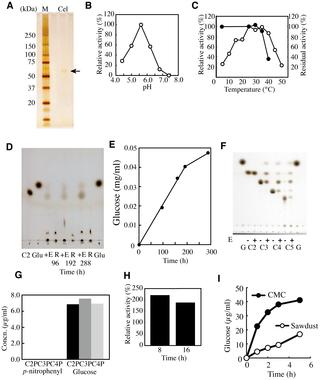
FigureA-I,FigI.showsproductionofglucoseovertimethe productionofglucoseinareactioncontainingHGcel(380mU) andeithersawdustorCMCat35°C,FigH showingeffectof hydrostaticpressureonenzymaticactivity
Possessingwonderfullyfreakyfeatures,thegiantisopod,alongwiththecolossalsquid,isoneofthemostfamous deep-seacreatures Thegiantisopodsarescavengersanddetrivoresmuchliketheircousins,therollypolliesorpill bugs.Despitetheirdietarysimilarities,theycangrow16timeslongerthantheirterrestrialcounterparts.Sowhy, whiletheyaresosimilar,doesonegrowsignificantlylargerthantheother?Besidestheirdifferentphysiologies, giantisopodsexhibitabehaviourcalledgorging.Whentheisopodsfindasignificantfoodsource,theywillgorge themselvestothepointofcompromisingtheirlocomotiveability.Bydoingthis,theyincreasesurvivalchancesby storingasmuchfoodandenergyastheycan,sincetheydon’tknowwhentheirnextmealwillbe Theirgigantism mightalsoprovideanadvantageagainsttheviscouswaterforcesofthedeep.Havingabiggerbodygivesthe isopodsarespiratoryadvantagethataidsinprovidingmoreATPtoincreaselocomotiveability,overcomingthe greaterviscousforcesofthewater.
Conclusion
Whilethephenomenonisstillamystery,thisarticlebrieflyexplainscurrentscientifictheoriesbehindwhyit happens.Whenitcomestodeepseagigantism,itisimpossibletogeneraliseandsingleoutonefactorthatdrives thephenomenon.However,itisclearthatineachcaseofgigantism,itiseitheradirectoutcomeoftheirevolved behaviour,physiology,orinmostcases,both.Deepseagigantismisanevolutionaryadvantagethatmost organismsbeyondthebathypelagiczonedeveloptohelpwithavoidingpredation,survivingforextendedperiods offamine,andmovingbetter.Regardlessofhowithappens,deep-seagigantismisafantasticexampleofhow organismsadapttotheirenvironmenttomaximisesurvival.
Bibliography
[1]UniversityofSouthFlorida,LessonII:AnimalAdaptationsandDistributionsI,Availableat: https://www.marine.usf.edu/pjocean/packets/f98/f98u3le2.pdf(Accessed:22October2024)
[2]Oceana,ColossalSquid,Availableat:https://oceana.org/marine-life/colossalsquid/#:~:text=Reaching%20combined%20body%20and%20tentacle,the%20largest%20individuals%20are%20f emale.(Accessed:22October2024)
[3]PMCPubMedCentral(2015),Kleiber'sLaw:HowtheFireofLifeigniteddebate,fueledtheory,andneglected plantsasmodelorganisms,Availableat:
https://pmc.ncbi.nlm.nih.gov/articles/PMC4622013/#:~:text=According%20to%20Kleiber%27s%20Law%2C%20 metabolism,investigated%20(adapted%20from%20Kleiber).(Accessed:22October2024)
[4]PMCPubMedCentral(2007),Bigmammalshavebig(orslow)cells,Availableat: https://pmcncbinlmnihgov/articles/PMC2064095/#:~:text=As%20body%20volume%20increases%2C%20surfa ce,numbers%20but%20not%20the%20principle.(Accessed:23October2024)
[5]Tepapa,Howthecolossalsquidfeeds,Availableat:https://www.tepapa.govt.nz/discover-collections/readwatch-play/colossal-squid/life-and-habits-colossal-squid/how-colossal(Accessed:24October2024)
[6]DigitalCommonsUniversityofSouthFlorida(2010),SlowPaceofLifeoftheColossalSquid,Availableat: https://digitalcommonsusfedu/msc facpub/2367/#:~:text=The%20estimated%20massspecific%20routine,the%20nearly%20isothermal%20Antarctic%20waters.(Accessed:24October2024)
[7]OxfordAcademic(2004),Temperature,GrowthRate,andBodySizeinEctotherms:FittingPiecesofaLifeHistoryPuzzle,Availableat:https://academic.oup.com/icb/article/44/6/498/610205(Accessed:24October2024)
[8]NationalGeographic(2012),Deep-Sea,Shrimp-likeCreaturesSurvivebyEatingWood,Availableat: https://wwwnationalgeographiccom/travel/article/120828-amphipods-oceans-mariana-trench-wood-scienceanimals(Accessed:24October2024)
[Figure1]Britannica,T.EditorsofEncyclopaedia(2014,February9).abyssalzone,Availableat: https://www.britannica.com/science/abyssal-zone(Accessed:26October2024)
[FigureA-I]Hideki,K.(2012,August15),TheHadalAmphipodHirondelleagigasPossessingaUniqueCellulasefor DigestingWoodenDebrisBuriedintheDeepestSeafloor,Availableat:https://journalsplosorg/plosone/article? id=10.1371/journal.pone.0042727(Accessed:26October2024)
[9]MontereyBayAquarium,Giantisopod,Availableat:https://www.montereybayaquarium.org/animals/animals-ato-z/giant-isopod(Accessed:28November2024)
[10]THOMSON,MURRAY.“MOUTHPARTSOFTHEDEEP-SEAISOPODBATHYNOMUSPELOR(ISOPODA, CIROLANIDAE)”Crustaceana,vol 83,no 12,2010,pp 1483–506 JSTOR,http://wwwjstororg/stable/29779480 Accessed28Nov.2024.
[11]QueenslandMuseum(2021,August3).MysteryObject:Alife-sizegiantoftheocean?,Availableat: https://blog.qm.qld.gov.au/2021/08/03/mystery-object-a-life-size-giant-of-the-ocean/(Accessed:28November 2024)
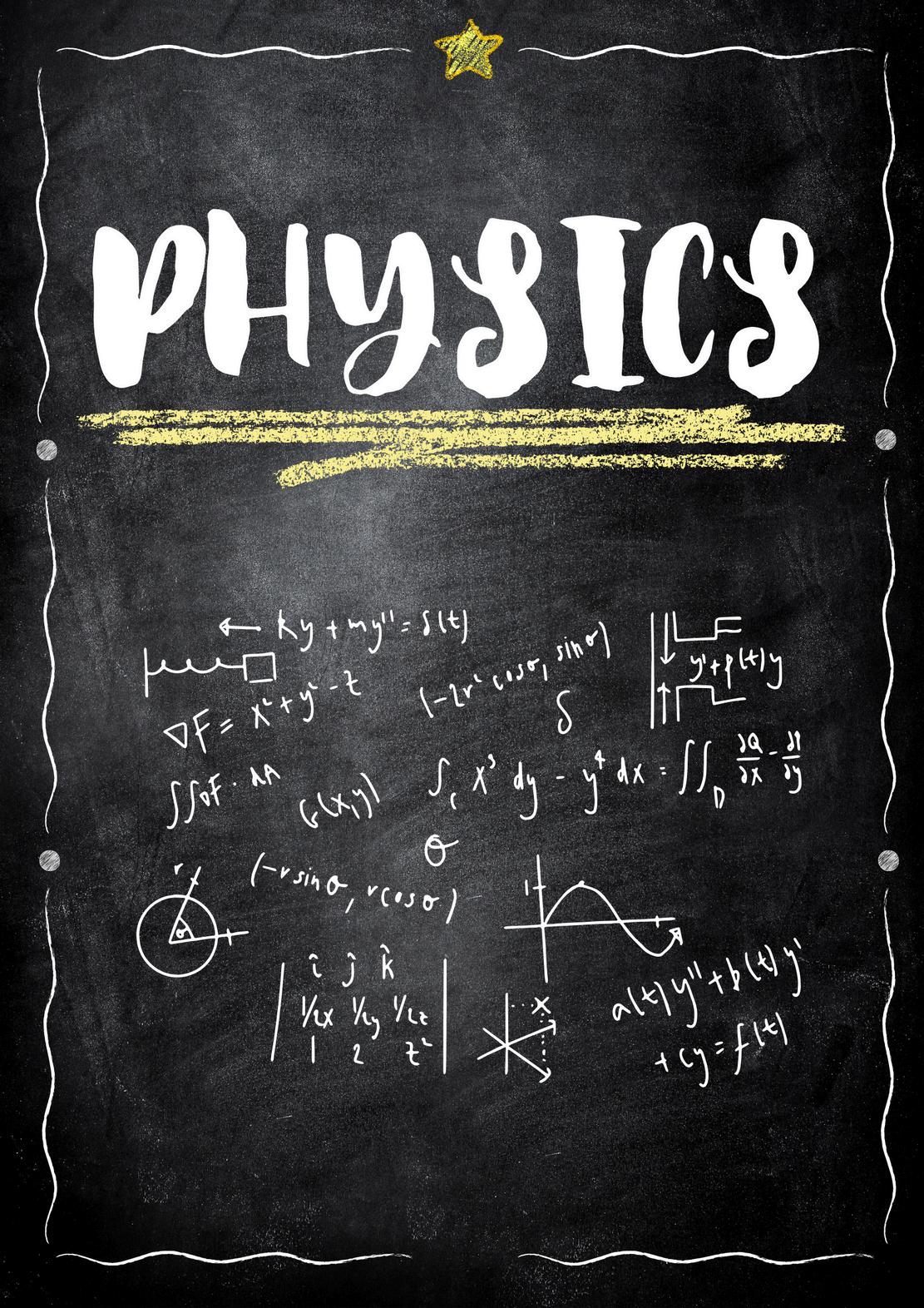

ExploringtheApplicationof AerodynamicsonFormula One
by Jeffrey Ling
1.0Introduction
Inthehigh-octaneworldofFormulaOneracing,wheremillisecondscandeterminevictoryordefeat,theroleof aerodynamicsemergesasacriticalfactorthattranscendsmerespeed.Ascarsziparoundtracksatbreakneck speeds,theelaborateinteractionsbetweenairandvehiclesurfacesnotonlyinfluencesperformancebutalso embodiesthepinnacleofengineeringinnovation.Understandinghowaerodynamicprinciplesareappliedin FormulaOnerevealsnotjustthesciencebehindthesport,butalsotherelentlesspursuitofperfectionthat drivesteamstopushtheboundariesoftechnologyanddesign.
2.0FundamentalsofAerodynamicsinFormula1
InFormulaOne,aerodynamicsrepresentstheartofbalancingtwoforces-downforceanddrag Countless amountsoftimeandmoneyarespenttryingtomaximisedownforce,whichpushesdownonthecarto increasetractionforimprovedcornering,andminimisedrag,whichslowsthecardownonstraights.At maximumspeeds,thedownforcecanactwithupto4-5timestheweightofthecarwhichhelpstoavoid spinoutandmaintaincontrolandstabilityofthecarduringcornering.However,havingtoomuchdownforce canalsonegativelyimpacttheperformanceofthecar.Firstly,frictionanddragincreaseswithdownforce,which canmakethecarlesssuitableforstraightcourses.Furthermore,toomuchdownforceonthefrontwheelscan causetheracecartooversteer;toomuchforceonthebackwheelscancauseittoundersteer[B].Therefore, findingthebalancebetweendownforceanddrag(knownasaerodynamicefficiency,measuredbylift-drag ratioofCl/Cdwith~2.5to3beingthetypicalvaluerange)iskeytoproducingthefastestcar.
Theutilityofaerodynamicsisnotonlylimitedtothedesignprocess-duringtherace,driversmaytake advantageofairflowbycloselyfollowingacarinfront,calledatow(diagram[C]) Thismanoeuvremakesuseof alow-resistanceairpocketthataracecarleavesbehindasitpunchesthroughtheair,similartoaslipstreamin cycling.Typically,thistechniqueisonlyusedonastraightpathbecausethetrailingracecarcannotgenerateas muchdownforceduetothescattered‘dirtyair’leftbehind,meaningcorneringislessefficientandmore dangerous.Thisiswhyteamsliketoputtheirrearwingsashighupaspossibletoavoid‘dirtyair’generated fromthefrontandgeneratemoredownforce.
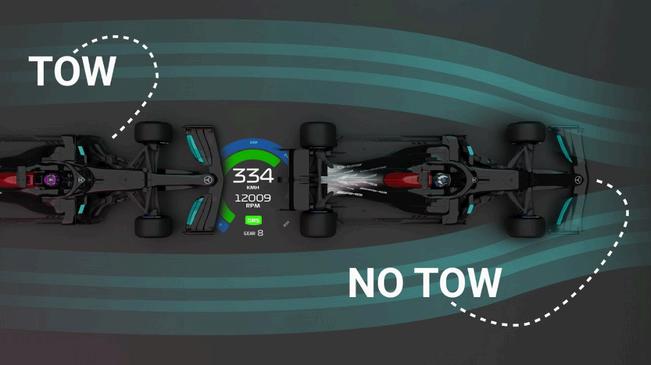
3.0 Aerodynamic Design in F1
To understand how F1 wings generate downforce, we can draw parallels with how a plane generates lift because it’s the same mechanism but in the opposite direction. In diagram [1], streamline A initially hitting the wing and grazing through the top surface. If there is no external force on this streamline, it would keep going at the initial tangent of the front wing edge instead of following the shape of the wing. This creates an imperfect vacuum between the streamline and the wing. Consequently, the streamline is pushed down due to the difference in pressure and is accelerated along the way, causing the speed of air at the top to be much greater than air below the wing. This is the Coanda Effect. By applying Bernoulli’s principle, which states that an increase in speed of a fluid occurs simultaneously with a decrease in pressure of that fluid, we know that the pressure on top of the wing is lower than the pressure below the wing, causing a lift force. Additionally, the act of turning the fluid downwards creates an action pair under Newton’s third law, which pushes the wing upwards (wind is referred to as downwash). To apply this to an F1 wing, we just need to imagine the wing flipped on its horizontal axis [1][2][3]. The amount of lift generated can be controlled by changing the angle of attack of the wing (angle the wing makes with oncoming flow). The downforce generated would be greater with an increased angle of attack until the stall point where the airflow will separate too early on, resulting in turbulent flow (refer to diagram [10]).
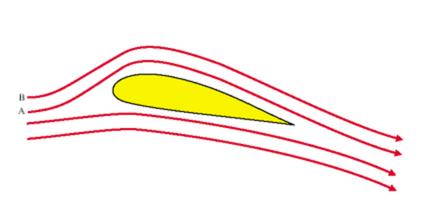
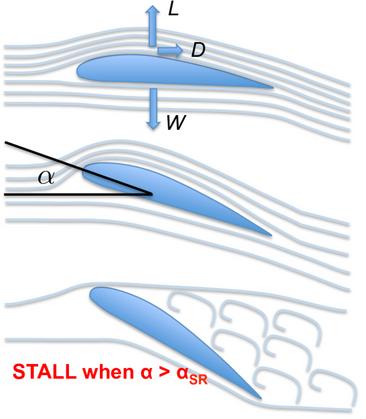
Typically, F1 cars have a front wing and a rear wing. The front wing makes up approximately 20-25% of downforce on the entire vehicle, and it also helps direct airflow to the rest of the car and reduce drag [4][5].
One common problem from using wings is the generation of wind vortices at the edges. Since there is an area of high pressure above the wing and an area of low pressure below the wing, high pressure air will want to flow around the wing tips to the low-pressure area below, creating circular or swirling patterns behind it (refer to diagram [7]). These vortices increase drag and reduce downforce, so the end of wings are usually capped with a perpendicular piece of metal called a wing tip end point to hamper this effect (diagram below). Contrastingly, teams utilise this effect on the inside edges of the front wing, as a vortex is created around the body to seal in clean (laminar) air which passes through beneath the body [6].


3.1 Rear Wings and DRS
One feature exclusive to high-level motor sports are multi-element wings, found in both front and rear wing designs. Multi-element wings are able to generate greater downforce for less drag - this owes to the fact that the angle of attack can be increased as high pressure flow from atop of the wing bleeds to the lower edge to increase velocity and prevent separation (refer to diagram [12]).
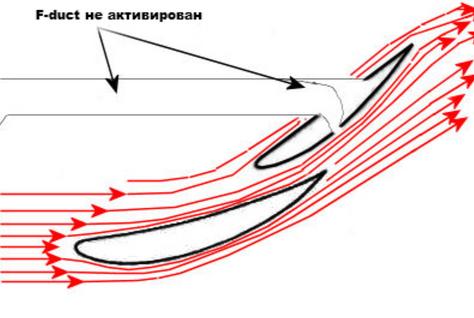
[12]
Unique to the rear wing, a hydraulic cylinder can push the frontend of the rear wing upwards so that the air can flow straight through without hitting the wing. This is called the Drag Reduction System (DRS) and can be activated when 2 conditions are fulfilled. First, the racecar must be within a designated DRS zone. Second, there must be a racecar, at most, a second ahead of your car. DRS zones are usually assigned as long straights on an F1 track where F1 cars don’t need to generate their maximum downforce for cornering and can sacrifice downforce for reduced air resistance, making the car momentarily faster. Formula One uses this feature to make the race feel more exciting by increasing the chances of overtaking around the track
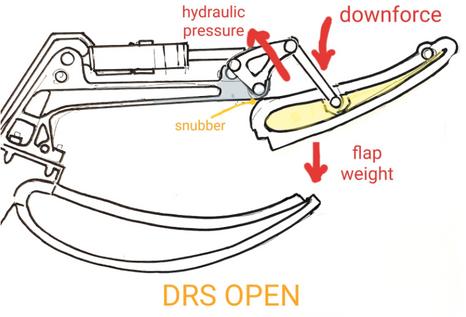
3.2 Intricacies in the Design of Rear/Front Wings
There are more intricate designs which further contribute to improving the lift-drag ratio of the car, such as cutouts on both wings and Gurney flaps on the rear wings.
High pressure air atop the wing will spill over, causing an anti-clockwise vortex with the low pressure air next to the endpoint. By instating cutouts, a region of lower pressure air can be created outside the endpoints which form a clockwise vortex using the low pressure air underneath the wing (refer to diagram [13]). These vortexes counteract each other to reduce the effect of the overall vortex
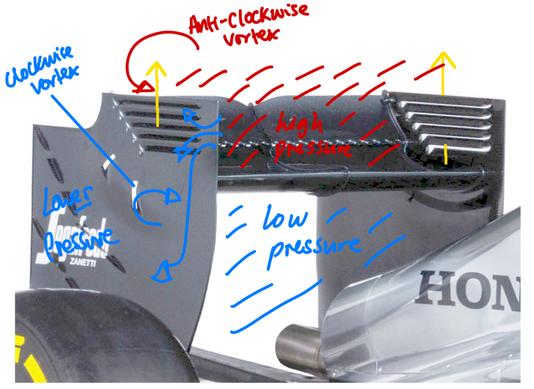
[13] Analysis of pressure around the rear wing
Gurney flaps are right-angled attachments to the end of the wing which extend the point in which the airflow reconnects higher because of points of recirculation which form that give airflow a smooth surface to flow over and reconnect at a later point. Consequently, the turn on fluid is larger and an increased downforce is generated.
4.0 Optimisation of Aerodynamics
Formula One teams also utilize Computational Fluid Dynamics (CFD) and Wind Tunnel testing as essential tools to optimize their car designs and enhance aerodynamic performance. CFD simulations allow engineers to create detailed models of airflow around the car, enabling them to visualize and analyze how different shapes and configurations impact drag and downforce without needing physical parts. Once the team is happy with the shape of a part obtained from CFD, they will manufacture it and put it through a Wind Tunnel for further testing. The Wind Tunnel visualises the flow structures over parts of the car by using a technique called Particle Image Velocimetry (PIV) where small tracer particles are put into the Wind Tunnel to follow the aerodynamics of a car; lasers and cameras illuminate these particles and take snapshots, making up a picture of the aerodynamic structures on the car.
Finally, if the team is happy with the flow structures, they will send the design off to manufacture to test on the track. On the track, teams can use a variety of methods to gain extra data and make adjustments. Putting on aero rakes is a common technique, where broad scaffold-like structures covered in sensors measure the airflow off of the car's body to give extra data to corroborate tests from CFD and Wind Tunnel tests. Flow-vi (flow visualization) is another technique to support data from CFD and Wind Tunnel tests. Oil and fluorescent powder are mixed together and sprayed over critical areas of the car right before testing. Different patterns are seen after the light oil evaporates and can be analysed to give insight into aerodynamic flow patterns. Visual representations of CFD, aero rakes, and flow-vi are shown below. [15]
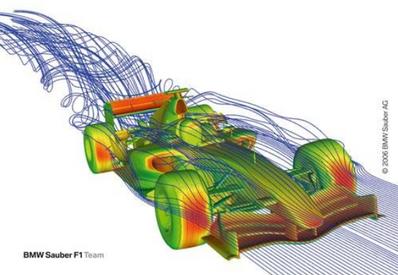
CFD data
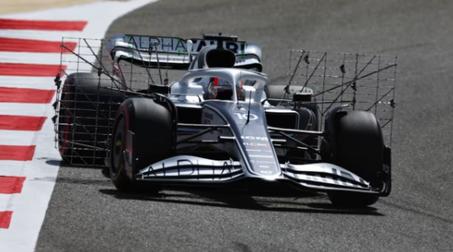
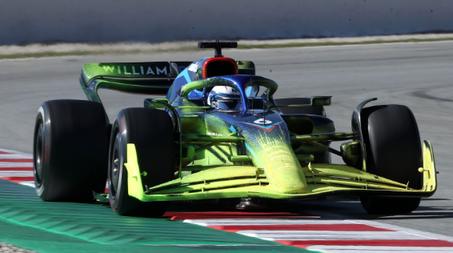
5.0 Conclusion
To conclude, the exploration of aerodynamics in Formula One is not merely a technical pursuit but a fundamental element that defines the sport itself. From the development of sophisticated Wind Tunnel testing to the implementation of advanced computational fluid dynamics, teams have and will, continuously innovate to gain a competitive edge.
[A] ‘Feature: Downforce in Formula One, Explained’. Mercedes-AMG PETRONAS F1 Team, https://www.mercedesamgf1.com/news/feature-downforce-in-formula-one-explained.
[B] Aerodynamics in F1 – Part 1 13 June 2020, https://racingfeed wordpress com/2020/06/13/aerodynamics-inf1-part-1/
[C] How Powerful Is The Tow? TOW vs NO TOW Comparison | F1 2021 Azerbaijan GP Directed by P1 UNFILTERED, 2021 YouTube, https://www youtube com/watch?v=-Q342pJ60Es
[1] Rominger, Alan ‘Answer to “Why Does the Air Flow Faster over the Top of an Airfoil?”’ Physics Stack Exchange, 1 Aug 2011, https://physics stackexchange com/a/13032
[2] Coanda Effect - an Overview | ScienceDirect Topics https://www sciencedirect com/topics/engineering/coanda-effect
[3] Lift from Flow Turning https://www grc nasa gov/www/k-12/VirtualAero/BottleRocket/airplane/right2 html
[4]https://www f1-forecast com/pdf/F1-Files/Honda/F1-SP2 21e pdf
[5] The Art Of Designing The Perfect Front Wing In Formula 1 https://motorsportengineernet/the-art-ofdesigning-the-perfect-front-wing-in-formula-1/
[6] How a Formula 1 Race Car Works. Directed by Animagraffs, 2021. YouTube, https://www.youtube.com/watch? v=V7707zEX9X4.
[7] https://youtu.be/7Aa7aQsuuzc
[8] How Floor Work Boosts Performance In Formula 1. https://motorsportengineer.net/how-floor-work-boostsperformance-in-formula-1/.
[9] Formula 1 Aerodynamics: What Are Venturi Tunnels and How Does Porpoising Affect F1 Cars? https://www raceteq com/articles/2024/08/venturi-tunnels-explainer
[10] Notional Airflow over a Wing vs Angle-of-Attack (α) | Download Scientific Diagram https://www researchgate net/figure/Notional-airflow-over-a-wing-vs-angle-of-attack-a fig28 322404455
[11] Formula 1 Aero Insights Pt 2: Single vs Multi-Element Rear Wings | NablaFlow https://nablaflow io/aerocloud/blog/formula-1-aero-insights-pt2-single-vs-multi-element-rear-wings/
[12] The Most Noise-Inducing Technical Solutions of 2010: F-Duct - Formula 1 News: Aerodynamics, Engines, Performance and Car Design https://miheichf1 blogspot com/2011/03/2010-f-duct html
[13] Rear Wing Aero Design Theory - F1technical Net https://f1tcdn net/forum/viewtopic php?t=22654 Edited using GoodNotes
[14] What Is Porpoising? F1’s Aerodynamic Phenomenon Explained | Top Gear https://www topgearcom/carnews/formula-one/what-porpoising-f1s-aerodynamic-phenomenon-explained
[15] ‘From Aero Rakes to Flow-Vis: 5 Key Terms You Need to Know for F1 Pre-Season Testing | Formula 1®’ Formula 1® - The Official F1® Website, https://www formula1 com/en/latest/article/from-aero-rakes-to-flow-vis5-key-terms-you-need-to-know-for-f1-pre-season.10Cdt2TOEZ1rR7pgQhnMux.
Whatisthesignificanceofthe searchforthetheoryof everything?

by Arin Lee
The Theory of Everything (ToE) is a hypothetical framework that combines our understanding of the four fundamental forces. This theory attempts to provide a model that explains how these forces interact, with electromagnetism, strong and weak nuclear force being part of the Standard Model (CERN, 2012) and gravity existing as a separate entity (Department of Energy, n.d.). The quest to search for a ToE has spanned over decades, yet we remain far from uncovering it
Our current understanding of the forces is split into two main concepts: general relativity and quantum mechanics (NASA, 2023). There has been little need to unify them primarily because we have been unable to test theories due to the vastly different scales at which quantum mechanics and gravity operate. An experiment investigating quantum effects would not be sensitive enough to detect gravitational effects and vice versa. In other words, due to our technological limitations, we cannot make significant progress in our search.
Despite a ToE seeming elusive, scientists persevere because finding one could open the scientific world to an unimaginable realm of possibilities. On a practical scale, a ToE could solve challenges such as energy consumption and sustainable transport; on a larger scale, we could make predictions about the timeline of our universe. While we can’t guarantee that we will have completely accurate predictions, it’s highly likely that we will be able to make predictions much more accurately than we do now. For example, we could hypothetically calculate when this universe would end and explore theories like the multiverse, where wormholes could be a way to escape to another world (Scientific American, 2024). It’s remarkable that we could unlock these mysteries through just one theory
Some scientists argue that the search is futile but historically, it has been proven that theoretical physics has a major impact on technological innovation. Back in 1905, many critics viewed Einstein’s theory of relativity as impractical. Today, his theory plays a vital role in ensuring the accuracy of our navigation systems and extends its influence beyond Earth into space. Factors affecting special relativity, such as length contraction and time dilation, form a major part of spacecraft trajectory calculations (Space.com, 2023). This example is only the tip of the iceberg that demonstrates how theoretical physics can revolutionise mankind and show that theories once deemed useless can lead to breakthroughs.
The most famous contender for ToE is String Theory; according to this radical theory, reality is made up of vibrating strings, and as they twist and fold, they yield different particles of nature (Institute of Physics, n.d.). By taking these strings as the basic blocks of reality, string theory links all natural forces into one coherent concept. However, a fundamental issue with String Theory is the lack of experimental evidence surrounding it, making it impossible to draw conclusions and validate it (IPPOG, 2012).
While a ToE is certainly appealing in its unification of forces and promising options like String Theory have been proposed, we must question the need for a ToE. At this moment, our technology is not able to test any of our ambitious theories; meaning that even if we had a ToE, it would have low practicality. Thus, what’s the significance of the search? It’s for scientists' peace of mind.
Bibliography
1. CERN. (2012). The Standard Model. Retrieved from https://home cern/science/physics/standard-model
2. Department of Energy. (n.d.). DOE explains... the Standard Model of particle physics. Retrieved from https://www energy gov/science/doe-explainsthe-standard-modelparticle-phy sics
3. Scientific American. (2024). Will scientists ever find a Theory of Everything? Retrieved from https://www.scientificamerican.com/article/will-scientists-ever-find-a-theoryo f-everything/
4. Space com. (2023). The Theory of Everything: Searching for the universal rules of physics. Retrieved from https://www.space.com/theory-of-everything-definition.html
5. Institute of Physics. (n.d.). The Standard Model. Retrieved from https://www.iop.org/explore-physics/big-ideas-physics/standard-model
6. IPPOG. (2012). Introduction to the Standard Model. Retrieved from https://ippog.org/news/introduction-standard-model7
NASA. (2023). Chandra Data Tests 'Theory of Everything'. Retrieved from https://www.nasa.gov/image-article/chandra-data-tests-theory-of-everything/

ExploringtheUnknown PhysicsBehindMotion
by Jenson Ho
1.0) Introduction
Have you ever looked around yourself and thought about how many things in your life are dependent on physics? The truth is, whether we realise it or not, physics is present in absolutely everything in our daily lives. From it being: walking, to driving, to balancing, physics, despite it sometimes being unnoticed, plays a fundamental role in allowing us to do everything that we do today
2.0) The Physics Behind Motion
Motion is an extremely important action that is common in our day to day lives. Usually, physics surrounding motion is about moving objects efficiently and quickly. However, there is also some deeper, lesser known physics affecting motion. Throughout this article, we will be considering the effects of resistance and fictitious forces on motion and how they play a key part in our lives.
2.1) The Physics of Resistance
Friction is known to be the force that resists motion; acting in the opposite direction to it. It is described by the equation “frictional force(f) = friction coefficient(μ) x normal force(N)”.[6]
Normal force is the component of a contact force that acts perpendicular to the surface that an object contacts and the coefficient of friction is a measure of the amount of friction existing between two surfaces. Friction is caused by the interactions of particles on 2 surfaces. When 2 surfaces which aren’t completely smooth come into contact with each other, friction acts in the opposite direction to movement and slows the moving object down over time. Many people assume friction is a force that only slows objects down; however, the importance of friction is usually neglected in our everyday life
2.11) Effects of Grip on walking
Walking is something we do every day. It is an essential function of our body which allows us to be able to move around to perform tasks necessary for our survival and entertainment. It is something that we learn how to do from a young age; however, most people disregard the physics that is going on with every step. One of the important effects caused by friction is called grip. It is caused when friction prevents sliding on a surface due to it exerting a force in a different direction. Grip is usually associated with keeping motorsport cars on the track, which is extremely important, however it is not only exclusive to the racetrack. Grip is one of the most important everyday life phenomena.
Walking forwards, the soles of our shoes cause friction against the ground. Friction causes our feet to grip onto the ground, allowing us to prevent ourselves from sliding backwards. This is because humans’ method of movement is to pull ourselves forwards by swinging one leg forwards whilst the other is planted on the ground. (Figure 1) The planted leg ideally stays as still as possible whilst the other leg is swinging. [1] The swinging leg has a force exerted on it by our muscles, then relaxes, allowing gravity to pull it onto the ground in a
position towards the direction we want to move.[1] Then, we can repeat this process with another foot. This mechanic of human walking includes one leg being in contact with the ground, and for a stable swing of the other leg, the one which is in contact should provide enough support for the body not to topple. If friction were non-existent, it would be much harder to stabilize the human body without sliding away
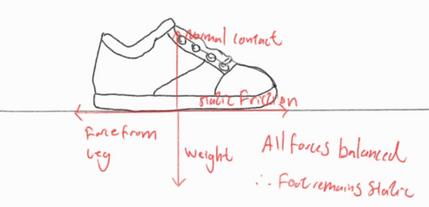
Figure 1: Free body diagram showing forces acting on the stationary foot
For example, ice has an extremely low μ of around 005 for static friction and 004–002 for dynamic friction. Meanwhile, a typical road “asphalt” has a μ of about 0.7 to 0.8. According to f =μN, a lower friction coefficient is directly proportional to a lower force of friction, and a lower force of friction means lower grip. Anyone who has walked on an ice surface can tell you that, without skates, it is much harder to move forwards on it than dry land because your feet will easily slip since the friction is low therefore having low grip on ice. Meanwhile, we find it easy to walk on a typical road since the μ is high which is proportional to high grip. The higher friction means a higher grip. Thus, it is easier to walk on high grip surfaces because walking, which requires us to pull ourselves forwards, is easier and more controllable.
This idea can be proven by another example of swimming in outer space. Since space is a vacuum, which is a place with no matter, no grip exists between objects and their surroundings. No matter how hard we try, without a thruster, harness or any other means, it is impossible to move with no friction (μ = 0).
Through these examples, we can determine that friction is necessary for movement since it allows us to grip the surface we are walking on and thus move forwards easily. Without friction we will uncontrollably slide. This also applies for other objects such as cars or anything that moves by pulling itself forwards against a surface with μ>0.
2.12) Air resistances effects on Formula 1 and Motorsport
From the perspective of an object propelled by a force not acting towards the ground, air resistance is a hindrance to its top speed. Whilst this is useful in bullet trains, it is not practical for normal cars (as roads are made of bitumen not electromagnets due to cost restrictions and how it would be impractical to magnetise entire roads and send multiple individual cars speeding at uncontrollable speeds). Despite air resistance being a hindrance to an object’s speed if it is levitating, it can help with the cornering and rotations of an object with contact to the ground.
The reason for this is an effect known as downforce. Downforce is a force acting downwards and it pushes the car down. The main way this is created is by having a high-pressure area above the car and a low-pressure area below it.(Shown in Figure 2) The way that downforce improves turning [2] is that it increases the force pushing the wheels down to the road. This means that grip is increased which prevents the wheels from slipping[8](allowing the brakes to be more effective), allowing the cars to stay on their intended racing line and hit the apex of the turn easily.[3]
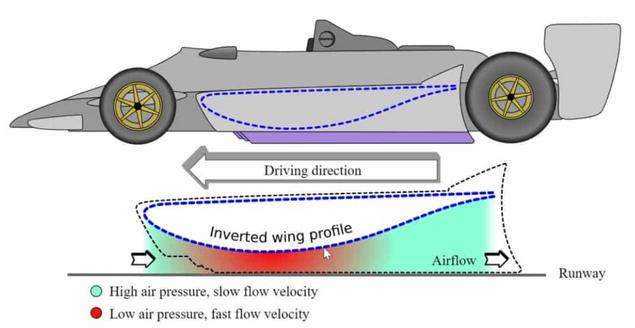
2.13) Frictions Effect on Stopping
Another essential property of friction is its ability to slow down and stop objects. According to Newton's First Law: “a body at rest remains at rest or, if in motion, remains in motion at a constant velocity unless it is acted upon by external forces” Normally for movement along a surface, friction is the “external force” which is used to stop moving objects.
According to the law of conservation of energy: energy cannot be created nor destroyed, it can only be transferred from 1 store to another. If an object is in motion, it has a kinetic energy store (KE=½mv²). For an object to stop, the kinetic energy store must be converted into another energy store: heat energy. Since friction opposes the force of motion, it mechanically transfers the kinetic energy store of the moving object into a thermal energy store which is dissipated into the surroundings through heating. This allows the object to stop.[8]
Friction is normally harnessed for stopping objects which are sliding along a surface. This is different to how it helps walking, as walking is pulling the body forwards. For example, in a car there are two main examples of how friction can stop it: the brake stopping the wheel and the tire sliding to a halt on the ground. A brake stops the wheel by causing friction between a brake pad and a rotor on each wheel (these are at high temperatures since they mechanically convert the kinetic energy of the wheel to thermal energy). The car then stops moving as a whole because of friction between the tires and road (which generates high temperatures between the wheels and the road for the same reason). Therefore friction acts as the “external force” mentioned in Newton's First Law. This is important as, without friction, we would have no way to stop objects set in motion.
Theoretically if a ball were to be launched into outer space (assuming there is no external force, such as gravitational field strength, acting upon it), it has no way of stopping and would move in a constant speed in a straight line forever (Newton’s First Law).
2.2) The Physics of Balance
The way most people learn to balance on a bicycle is when their trusted parent promises to hold onto them, and by the time they’ve been hit by the realisation they’ve been betrayed, they are already cruising away, having mastered balancing on a bicycle. Despite this method teaching children about how they shouldn’t trust people blindly, it works. Most people believe that the child believing the parent is still holding onto them is purely a psychological effect that boosts the child's confidence to allow them to learn the skill, physics should also be credited for this newfound skill.
2.21) Fictitious Force - Centrifugal Force
Firstly, to understand the importance of physics in balancing, we must understand the basic principles of the fictitious force centrifugal force.
The main fictitious force involved with balance is called centrifugal force. Centrifugal force is “a force, arising from the body's inertia, which appears to act on a body moving in a circular path and is directed away from the centre around which the body is moving.” Described by the formula F=mω²r (with F = centrifugal force, m = mass, ω = angular velocity, r = distance from the origin). Centrifugal force is a fictitious force as it does not result from physical interactions between objects [4], but it results from the acceleration of the frame of reference. A frame of reference is an abstract coordinate system, whose origin, orientation, and scale have been specified in physical space. A fictitious force is defined as an apparent force that acts on all masses whose motion is described using a non-inertial frame of reference. Centrifugal force is observed when there is an object moving along a circular path. [4] One effect of this which may be observed more commonly is when a car, in which you are riding, turns, you will feel a force pulling you away from the center. Centrifugal force is harnessed for balance. Additionally, it is also used in a centrifuge to separate substances in liquid or solid media according to particle size and density.
2.22) Application on a Bicycle
Since we now understand centrifugal force, we can now apply it to the case of a bicycle’s balance. For simplicity, in this article we will only consider the forces acting on a riderless bicycle; however, it is likely that a bicycle with a rider will act similarly
To understand the impact of this fictitious force, let us consider a stationary bicycle tilting to one side. Due to the reaction force (acting along the bicycle) being misaligned with the gravitational force, (acting downwards) the bicycle will topple.
However, if centrifugal force is present, it is responsible for the bicycle’s self stability. This is because when the bicycle leans to one side, the bicycle can be assumed to be moving along a curved path of motion as the front wheels will rotate. However, if the bicycle is moving forwards, there is now the presence of an angular velocity. This results in the presence of a centrifugal force which balances the reaction force and the gravitational force[5]. This causes the bicycle to be in equilibrium and not topple.(Figure 3)
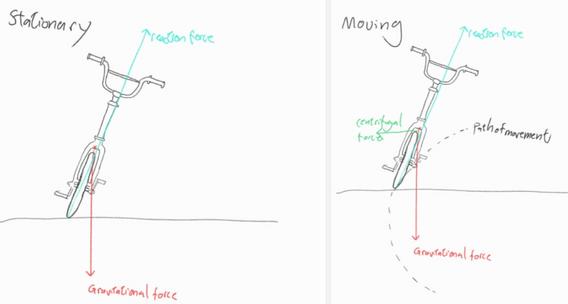
Figure 3: Comparing the forces acting on a moving and stationary bicycle.
3.0) Conclusion
To conclude, physics, such as friction and centripetal force, play a fundamental role in keeping our lives possible. Whilst usually things such as biological and physiological such as evolution usually get the credit for humanity's success as a species, physics is the underlying factor which has enabled all of these to happen.
4.0) Bibliography
[1] How does friction help us to move/walk : https://physics.stackexchange.com/questions/628307/how-does-friction-helps-us-to-movewalk
[2] Figure 2: Ferrari F1-75 Aerodynamics: https://www.f1technical.net/forum/viewtopic.php?t=30214&start=2235
[3] What is downforce and why is it important: https://www.gpfans.com/en/f1-news/104261/f1-downforceexplained/#:~:text=The%20'downforce'%20is%20a%20downward,losing%20control%20of%2 0the%20vehicle.
[4] Pseudo Force - Definition and Examples: https://byjus com/physics/pseudo-force/
[5] Why does a leaning bike not fall over: https://physics.stackexchange com/questions/388009/why-does-a-leaning-bike-not-fallover#:~:text=These%20forces%20will%20act%20through,torques%20about%20the%20tire% 20contact
[6] Mechanics- Statics- Friction: https://www.a-levelphysicstutorcom/m-statics-friction.php
[7] Britannica: Centrifugal Force https://www.britannica.com/science/centrifugal-force
[8] Understanding Friction: The Unsung Hero of Automotive Safety https://www.niradynamics.com/latest/understanding-friction-the-unsung-hero-ofautomotive-
safety#:~:text=High%20friction%20levels%20ensure%20shorter,safe%20stop%20and%20a% 20collision.
Attophysics–Ascienceof ultrafast matter dynamics

by Wesley Tang
1.0 Introduction
The second is likely something very familiar to you; a unit of time that is 1/60 of a minute or 1/3600 of an hour, but it is also an SI (Système International) unit, where prefixes can be added to it to denote a magnitude of 10. Now, let’s start by dividing this time by 1000. First, there is the scale of milliseconds (ms), the timespans of the quickest reaction times in the animal kingdom. Then comes microseconds (µs), the magnitude which protein folding occurs at, nanoseconds (ns), picoseconds (ps) and penultimately femtoseconds (fs), where the fastest chemical reactions happen. We divide by a thousand just once more, finally entering the realm of attoseconds (as). This is 1 x 10-18 s or one quintillionth of a second. For reference, there are more attoseconds in one second than seconds in double the current estimate for the age of the universe [1]. Attosecond physics or generally attosecond science is the field which concerns the usage of photo pulses to probe the dynamics of matter in this time resolution.
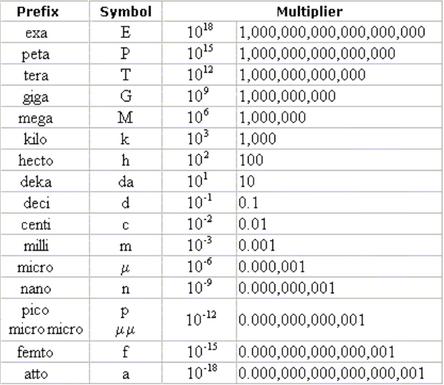
Figure 1 – Table containing the metric prefixes for SI units, from 1018 to 10-18 (Credit: OC Science, Expii)
2.0 Background
A common trend you can see is that smaller objects move in shorter and shorter timescales This applies to the smallest particles: atoms and their constituents. One of the main interests of attosecond science is to use tools to investigate the dynamics of atoms and electrons, which move and change energies at this temporal scale. At this level, the interactions between particles occur almost instantaneously, making traditional measurement techniques insufficient. This led to the development of attosecond pulse technology, allowing scientists to create bursts of light lasting just a few attoseconds. These pulses act like ‘snapshots’ that can freeze the motion of electrons, enabling researchers to observe their behaviour in real time. The world record for fastest human light pulse is 43as, as of 2017 [5].
3.0 Challenges
We use particles bouncing off other objects to observe them. This is evident in the fact that we use photons (light) to see most things by capturing them bouncing off objects and going into our eyes [2]. To observe something smaller means to use smaller particles to bounce off it to get a good picture; this is the basis of electron microscopy, the technique of using electrons instead of large visible photons to observe microscopic things. In this way, to observe dynamics in short time spans means to have swift time resolutions in temporally well-defined images spaced out equally. Consider a camera, if the exposure time of one is too long, fast moving objects will result in an unclear blur. These frames need to be separated by a short, equal timespans. Otherwise, you will not get a cohesive series of images [2][3][8]. To do this in terms of attoseconds, you will need light with a wave period in the attoseconds as light cannot be shortened into anything more than a single up-down cycle of its wave, which happens to be light in the X-ray range. Another problem is that the typical laser only releases a photon every few femtoseconds, which is thousands of times longer than one attosecond.
4.0 High Harmonic Generation
In the 1980s, Anne L’Huillier’s team experimented with argon gas and infrared lasers, observing an unusual range of high-frequency EM waves unknown to current processes.

Figure 2 – Tunnel Ionisation of an electron from atom, with recombination and photoemission when energy exceeds ionisation potential (Ip), the minimum energy required to ionise the atom. (Credit: ResearchGate)
This was the result of infrared light, which, when passing through a gas atom, excites an electron enough to cause ionisation below the ionisation energy through quantum tunnelling, releasing it from the potential barrier keeping it around the nucleus. The electron then may return to the ion and recombine via the same electromagnetism, releasing the energy it gained as a singular photon, with much higher frequency than the original infrared laser that is primarily in odd integer multiples (due to sinusoidal symmetry, according to the Fourier series) of the original laser frequencies, also known as harmonics of the laser frequencies. This process is called High Harmonic Generation (HHG). The collective effect of HHG on numerous gas atoms results in many photons in the ultraviolet to X-ray frequency range ‘Overtones’ to the infrared laser fundamental frequency are created through HHG [4].
4.1 Wave Interference and ‘Beats’
Waves have interactions with each other when put together. When waves meet in phase, where their crests and troughs align, a high amplitude wave ‘pulse’ resulting from the sum of the parent wave amplitudes is made. This process is called constructive interference. On the other hand, destructive interference is when the waves align out of phase, combining to create either a smaller amplitude or completely cancel out. This is important because when two waves of close frequencies overlap, a pulse train of regular high to low amplitude, a wave ‘pulse’, is formed. You can hear this from two similar frequency tones, and it is called an acoustic ‘beat’. With multiple waves overlapping, you can get a controlled, narrower and sharp pulse of high amplitude when their phases align with comparatively small amplitudes elsewhere. To achieve this, many waves with similar frequencies are needed. This is where HHG comes into play, with the creation of X-rays of similar frequencies being ideal. The time taken for this pulse’s period proved to be in the range of hundreds of attoseconds
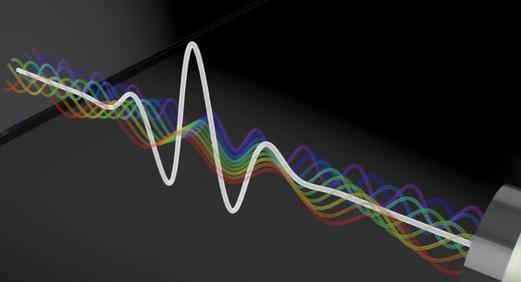
Figure 3 – Representation of similar frequency and amplitude light waves overlapping each other, creating a high amplitude ’pulse’ when they meet in phase by constructive interference. Note that colour is only used to differentiate different frequency waves
(Credit: Max Planck Institute of Quantum Optics)
4.2 RABBITT Calibration
Light pulses created from this constructive interference of High Harmonic Generation waves are inherently attosecond-scale events. This is a problem due to the subjects of measurement being attosecond-scale events themselves, and without a calibration the attosecond pulses are not suitable for application. French Physicist Pierre Agostini and his team solved this problem in 2001 and made attosecond pulse relative amplitude and phase obtainable through the invention of the reconstruction of attosecond beating by interference of two-photon transitions (RABBIT or RABBITT).
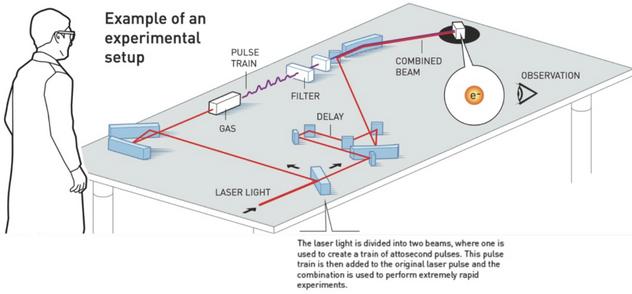
Figure 4 - Diagram showing example of Agostini’s RABBITT method of creating consecutive attosecond light pulses. (Credit: Johan Jarnestad/The Swedish Royal Academy of Sciences)
The original infrared beam is split into two parts, with one part preserved and put through a delay while the rest undergoes high-harmonic generation (HHG) to form the attosecond pulse train. When the train interacts with atoms, it also ionizes them. With RABBITT, the delayed infrared beam, having travelled a separate path, moves to interact with these excited free electrons. This combined interaction makes additional new 'sideband' peaks in the electron energy spectrum; subtle quantum interactions that reveal themselves between the original harmonic frequencies. These ‘sidebands’ oscillate in intensity, their regular pulsing allowing physicists to gain precise timing information. With prior knowledge of the fundamental infrared beam's exact frequency, we can decode these ‘beats’ to reveal the phase relationships between harmonics. By analysing these interference patterns, physicists then reconstruct the attosecond pulse train's temporal structure, with Agostini’s team able to confirm ‘beats’ as short as ~250 attoseconds by the end of their experiments. This phaselocked pulse train, with its near-perfectly spaced attosecond beating, is the ideal attosecond laser tool for the measuring of ultrafast dynamics. With this, there is one last hurdle to overcome before attosecond physics as a field is established; The ‘isolated attosecond pulse’.
4.3 Isolated Attosecond Light Pulses
Ferenc Krausz is the third notable scientist concerned. His role in the development of this field is the achievement of another attosecond pulse method (independent from Agostini, 2001) called streaking that creates single, isolated attosecond pulses, which for some applications of attosecond science is much more useful than the repeated pulse train from Agostini’s RABBITT. Krausz was able to achieve this mainly due to the advent of relatively new technologies: titanium-doped sapphire-based (Ti:Sa) lasers for light and various light pulse shaping techniques which helped develop this, like spectral phase manipulation, in which researchers employ techniques to control the spectral phases and the temporal length of the emitted harmonics. Chirped Pulse Amplification (CPA), where the wave is stretched and then compressed, helps in the isolation of the attosecond pulse as researchers can manipulate its frequency components effectively. Through Krausz’s pulse streaking, isolated pulses of 650as ± 150as were produced. In general, the attosecond isolated pulse and consecutive pulse train marked the birth of the new field of attophysics.
5.0 Uses and Applications
Attosecond physics has numerous applications, making its exploration highly valuable. Light travels approximately 3 angstroms (Å), or 0.3 nanometres (nm), in one attosecond. This is because (3 × 108 m/s) × (1 × 10−18 s) = 3×10−10 m. This distance is comparable to the typical diameter of an atom, highlighting the relevance of attosecond tools to fields like atomic and molecular physics Electron clouds change on this timescale of handfuls of attoseconds [1], and by hitting atoms or molecules with attosecond light pulses, we can more easily study the dynamics of atoms and the movement of electrons – one of the most fundamental particles of chemistry and physics The advancement of this area could mean the improvement of modern computing, where processing is currently fundamentally limited by the speed a semi-conductor transistor is able to switch between its 0-1 states, as the leakage of electricity from transistors causing heat generation limits typical transistors to GHz switching rates
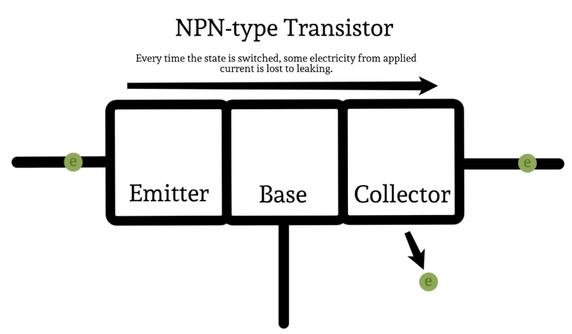
Figure 5 - Diagram of typical NPN-type Transistor, with leakage of electricity and applied current flow represented.
However, with the usage of attosecond pulses, it has the potential to increase the power of computers by up to a factor of 100,000, according to Krausz [1]. This could mean the preservation of Moore’s law, for at least another few years [2]. Though the number may seem unlikely, even a fraction of this amount would be groundbreaking. Attosecond lasers are also applicable to medicine, where the lasers are potentially capable of sorting through molecules and arranging them, such that we can fingerprint molecules with increased ease Cancer and other diseases could be further understood, and one day attosecond science may even lead to the development of cures for these diseases
6.0 Conclusion
In 2023, L’Huillier, Krausz and Agostini were jointly awarded the Nobel Prize in Physics ‘for experimental methods that generate attosecond pulses of light for the study of electron dynamics in matter’ [6]. The former 2 were additionally awarded the 2022 Wolf Prize along with scientist Paul Corkum, who developed the theory of attosecond physics [7]. Conclusively, the science of attosecond time resolution holds great promise of new understanding of the world around us, exploring the mysteries of our universe – one attosecond at a time
7.0 Bibliography
[1] Ferenc Krausz - Attosecond Physics (VIDEO PORTRAIT). Directed by Max Planck Institute of Quantum Optics, 2022. YouTube, https://www.youtube.com/watch?v=6ZIUJb85BAQ.
[2] Why Did Attosecond Physics Win the NOBEL PRIZE? Directed by PBS Space Time, 2023 YouTube, https://www.youtube.com/watch?v=5e83QRGoRCo.
[3] Observation of a Train of Attosecond Pulses from High Harmonic Generation https://www.science org/doi/10.1126/science.1059413
[4] Anne L’Huillier: The 2024 SPIE Maiman Laser Award. https://spie org/news/anne-lhuillierthe-2024-spie-maiman-laser-award.
[5] Gaumnitz, Thomas, et al. ‘Streaking of 43-Attosecond Soft-X-Ray Pulses Generated by a Passively CEP-Stable Mid-Infrared Driver’ Optics Express, vol 25, Oct 2017, p 27506 NASA ADS, https://doi.org/10.1364/OE.25.027506.
[6] ‘Nobel Prize in Physics 2023’. NobelPrize.Org, https://www.nobelprize org/prizes/physics/2023/summary/.
[7] Biography: Dr. Paul Corkum - National Research Council Canada. https://nrc.canada.ca/en/corporate/corporate-overview/biography-dr-paul-corkum.
[8] Attosecond Lasers (2023 Nobel Prize in Physics) - Sixty Symbols Directed by Sixty Symbols, 2023. YouTube, https://www.youtube.com/watch?v=NfmSjGbnEWk.
[9] A Brief Journey into Attosecond Physics. Directed by Tom Douglas-Walker, 2022. YouTube, https://www youtube com/watch?v=Xvb6vysV5Pg.

Originand Consequencesofthe TheoryofSpecial Relativity byMartinZhang
1.0 Introduction
Einstein’s theory of special relativity, published in 1905, describes how space and time changes for individual objects depending on their relative motion. It ended the debate over the speed of light, which was at much confusion at the time due to debates over the ether, an imaginary substance created to explain the specific speed of light predicted by Maxwell’s equations, and the troubling results of the Michelson-Morley experiment. In which the speed of light was observed to have a specific value The underlying cause of this confusion was Galilean relativity, the accepted model of relativity, which stated that all speeds are relative, and therefore, none are special. Einstein, however, identified that the speed of light is an exception to this rule, for it is always constant in a vacuum for all observers This led him to propose special relativity, whose basic formulae (known as the Lorentz transformations) defined the relationship between relative motion, space, and time more accurately than the previous Galilean relativity.
2.0 Galilean Relativity
Importantly, both Galilean relativity and special relativity model in inertial reference frames. An inertial reference frame is defined as a reference frame in which Newton’s first law holds true (a coordinate system whose origin, orientation, and scale are specified by a set of reference points, where objects travel at constant velocity when the force acting on it vanishes).
Other than the basis of inertial frames, there are three core components to Galilean relativity: the Galilean group, the principle of relativity, and absolute time.
Firstly, the Galilean group is a set of transformations that describes how different inertial frames can be linked together. If we have an inertial frame S, in which a particle has coordinates x(t), we can always map a second inertial frame Sʹ in which that particle has coordinates xʹ(t) by using any combination of these transformations:
Translation (x′ = x + a), where the position of the particle in S is a away from its position in Sʹ .
Rotation (x′ = Rx), where the position of the particle in S is rotated by matrix R compared to its position in Sʹ
Boost (x′ = x + vt), where the particle in S is moving at a constant velocity of v relative to Sʹ .
Secondly, the principle of relativity states that all laws of physics are the same in all inertial frames. This is important because, combined with the idea that one inertial frame can be mapped to another, each of the three transformations in the Galilean group predicts a certain property of the universe:
The process of translation suggests that there is no ‘special’ point in the universe (‘special’ meaning unique or always having the same value regardless of reference frames), since a point in the universe can be anywhere depending on which reference frame is taken to describe its position. For example, a point can only be at coordinates (3,5) relative to the origin of axis; if a new origin of axis is drawn, representing a new reference frame, the point will take up a different coordinate.
The process of rotation suggests that there is no ‘special’ direction in the universe, as an object can be facing in any direction depending on which reference frame is taken. For example, in a classroom, a student can only be ‘facing away’ if relative to another student behind them; they would be ‘facing towards if relative to the teacher who is on the stage, and they would be ‘facing left’ or ‘facing right’ if relative to students on either side of them. Consequently, the direction of any particle or object is not ‘special’ since direction depends completely on the position of the origin, or in other words, the frame of reference
The process of boost suggests that there is no ‘special’ velocity in the universe, as an object can be travelling at any velocity depending on which reference frame is taken. For example, the average speed of a car is 80 kmh-1, and the average speed of a train is 100 kmh-1 The car can only be travelling at 80 kmh-1 if relative to a pedestrian standing still, whereas it would be travelling at -20 kmh-1 relative to the train that is going the same direction next to it.
Lastly, absolute time states that the time coordinate t in all inertial frames are uniform – 1 second in frame S is the same as 1 second in frame Sʹ The only way to make a difference in time between inertial frames is by varying when to start the clock. Therefore, time in S and Sʹ only differ by:
tʹ = t + t0
(t0 is the amount of time taken to start the clock for Sʹ after doing so for S.)
3.0 Theory of Special Relativity
Galilean relativity seems like an intuitive model of space and time, where all speeds, positions, and directions are relative with the flow of time remaining constant. Even in the world around us, every example we find appears to obey Galilean relativity. However, starting from 1865, this instinctive model became questionable.
In 1865, Maxwell published his theories of electromagnetism. In his equations, it is assumed that the speed of light, c, has a specific value Although it is well known at the time that the speed of light is finite, no-one previously thought that the speed of light could have a specific value, as Newtonian physics and Galilean relativity stated that all speeds must be relative (note that this is not the same as us measuring the speed of sound in air where we take actual measurements in which the reference frame is taken from the person stationary to the sound wave – this speed of light is predicted directly from a equation involving no specific reference frames at all).
Unsurprisingly, it was first believed that Maxwell’s equations must be targeting some sort of ‘preferred’ reference frame that had not been thought of. Also, it was thought that all waves needed a medium to travel in, just like how sound waves need particles to travel, so it was believed that light also needed such a medium (we now know that light can travel in a vacuum without a medium). Thus, the idea of the ether was proposed, and it was believed that Maxwell’s prediction of the speed of light would only be valid in the frame at rest relative to this ether.
However, in 1881, the Michelson-Morley experiment proved that there seemed to be no difference in the speed of light regardless of the Earth’s relative motion to the ether Specifically, Michelson and Morley compared the speeds of two light rays, one perpendicular and one parallel to the Earth’s direction of motion. All had expected the speed of the light ray parallel to the Earth’s motion to be affected by the Earth’s relative motion to the ether, whereas the one perpendicular would not be affected. Nonetheless, the two light rays had the same speed.
In order to explain this, many theories about the ether were published. Notably, one popular theory is from Hendrik Lorentz, who said that distances between matter could somehow be shortened in the direction parallel to the ether.
In 1905, however, Einstein published his paper ‘On the Electrodynamics of Moving Bodies’. He recognised, in the theory of special relativity in this paper, that there are no mechanical explanations for Lorentz’s theory because the idea of the ether is inherently false He correctly realised that the property of the speed of light being constant is a nature of the universe With Einstein’s insight, problems with Maxwell’s equations were solved, as the speed of light is indeed a specific value through a vacuum by nature – there were no ‘preferred’ frames.
4.0 Lorentz Transformations
Einstein arrived at the formulae for special relativity by considering two postulates (experimental facts that are observed to be true):
The principle of relativity: the laws of physics are the same in all inertial frames
The speed of light in vacuum is the same in all inertial frames
We can recreate this process rather easily by imagining two inertial frames, S and Sʹ , which move relative to each other with velocity v in the x direction:
x′ = x – vt , t′ = t (1)
For simplicity we are assuming that the clocks of both frames started at the same time, so tʹ = t
Now we can consider two important restrictions to apply to this function. The first restriction is that both S and Sʹ are inertial frames, meaning that the law of inertia holds true: if left alone, a particle will travel at constant velocity. Therefore, if we draw the trajectory of this particle in the (x, t) plane, it will trace out a straight line, and the same goes for the (xʹ , tʹ) plane. Therefore, if we map (x, t) into (xʹ , tʹ), we would be mapping straight lines into straight lines. This means that the function must be linear. The second restriction is that Sʹ is traveling at speed v relative of S This means that an observer sitting at the origin of Sʹ would move along the trajectory of x = vt in S, which would then mean that the points on x = vt must always map to xʹ = 0, since the observer, sitting at xʹ = 0 the whole time, is moving along x = vt
These two restrictions bring the transformation function for space, denoted by x, to the form
x′ = γ(x − vt) (2)
for some coefficient γ, where γ is a function of v.
It is necessary to know that this also comes with the assumption that the origin x′ = 0 coincides with x = 0 when t = 0, which basically means that when we start the clock for both frames, an observer sitting at the origin of S would be at the same spot as an observer sitting at the origin of Sʹ .
Then, if we look in the perspective of Sʹ , S would be moving backwards with –v, which, using the same restrictions before, tells us that
Using the postulate that the speed of light c is the same in both S and Sʹ , in frame S, a ray of light has a trajectory of x = ct, and in Sʹ, the same ray of light has a trajectory of xʹ = ctʹ .
If we substitute these trajectories into equations (2) and (3), we get :
respectively. Solving these equations for γ, we get
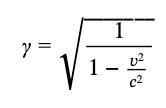
(4)
This is the Lorentz factor
Importantly, for the equation of γ above, if v << c, γ ≈ 1, which means that if Sʹ is moving at a speed much less than the speed of light relative to S, Galilean relativity still holds and tʹ ≈ t. Also, if v > c, the equation fails as we cannot root a negative number without getting an imaginary number, which does not make any sense in this case (we also technically cannot get v = c since we would then be dividing by 0). This hints the fact that nothing ‘real’ can travel faster than the speed of light
Now, using equations (2), (3) and the Lorentz factor in (4), we can get the function for time, denoted by t: (5)

The functions (2) and (5), along with the Lorentz factor of (4), make up the Lorentz transformations, where (2) is the function for spatial transformations and (5) is the function for temporal transformations.
It is not hard to see that in (5) that, if v << c, tʹ ≈ t, as well. Leading us to the conclusion that, because the speed of light c is observed to be the same in all frames, for relative speeds that are not at all close to the speed of light, Galilean relativity is acceptable, but for relative speeds that are close to the speed of light, it is the Lorentz transformations that accurately describes the spatial and temporal transformations of relative inertial frames. This explains why Galilean relativity seems intuitive, since in the world around us, no common object is traveling near the speed of light.
5.0 Consequences of Special Relativity
In this section, we will look at the consequences of shifting our perspectives from the usual Galilean relativity to special relativity. These consequences will be defined accurately by using the Lorentz transformations and space-time diagrams (a type of diagram used in special relativity with ct on the vertical axis and x on the horizontal axis, where ct is used instead of t for easier scaling).
5.1 Simultaneity and Causality
For an observer in the origin of frame S, their perception of the order of events is based on t, whereas the perception of a different observer in Sʹ is dependent on tʹ . Even if the first observer is convinced that P1 and P2 occur at the same time, it doesn’t affect the other’s judgment as the two of them are relying on separate t coordinates in their own respective frames and, as we know, t does not exactly equal tʹ under constant velocity v.
Figure 1 illustrates the situation. In S, P1 and P2 have equal t, as shown by dotted lines that are perpendicular to the ct axis and parallel to the x axis in the left diagram. Using the Lorentz transformations, ctʹ is given by

, so the lines reflecting equal tʹ are the lines with equation x = constant, as presented by dotted lines in the second diagram that are parallel to the xʹ axis. These dotted lines are called lines of simultaneity. They clearly show that while P1 and P2 are simultaneous in frame S, P2 occur before P1 in frame Sʹ due to v

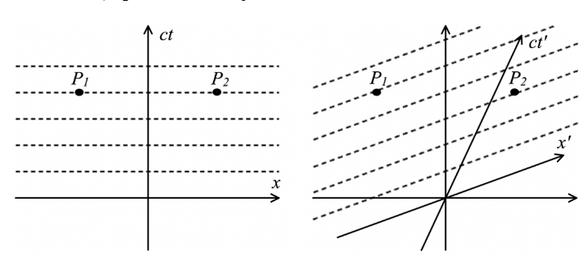
(Figure 1)
This is a general rule – two events that are simultaneous in one inertial frame are not simultaneous in any other inertial frames with relative constant velocity. This is because if v is non-zero, the lines of simultaneity will always be shifted by some amount in other frames.
This rule of simultaneity may be troubling – since different observers can never agree on whether something occurred before another, wouldn’t the order of causality (a thing causing another) break down? Luckily, causality is secured by a property of the Lorentz transformations.
Recalling to the Lorentz factor of (4), nothing can travel faster than the speed of light c. This reflects that the lines of simultaneity, given by,

can never be steeper than 45° as the coefficient of x (i.e the gradient of the lines) cannot be greater than 1.
Now, if we plot light trajectories from the point of an event such as P, a light cone is formed, as shown in Figure 3 (dotted lines).
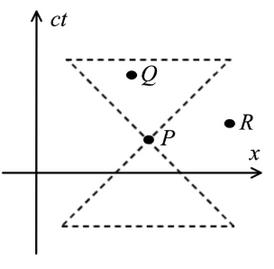
(Figure 2)
Light cones can be put into two parts: the top section of the light cone is the future cone, and the bottom section is the past cone. Since nothing can travel faster than the speed of light, any events that could have influenced P in any way must be in P’s past cone; any events that can be influenced by P in any way must be inside P’s future cone.
For events that are within each other’s light cones, such as Q and P (if Q is in P’s future cone, P must also be in Q’s past cone), there is no debate whatsoever as to the order of events, since no lines of simultaneity can bypass the steepness of the light cone. But for events that are outside each other’s light cones, such as P and R, different observers still hold different opinions depending on their frames
So, for any event that caused a second event, all observers will agree that it occurred before the second, which means that causality is secured, which leaves the problem of simultaneity as some minor debate over the ordering events that are completely unrelated .
This is perhaps the most famous consequence of special relativity, as it indicates the shocking idea of aging slower when travelling in a fast-moving spaceship while everyone else on Earth is getting older much more rapidly.
Using the Lorentz transformation of (5), if there is a clock sitting at the origin of frame Sʹ ticking at intervals of Tʹ, the intervals T between the ticks in S is given by and since the clock is sitting at the origin of Sʹ where xʹ = 0, it is simply given by


This reveals that the intervals are longer in the stationary frame by a factor of γ (i.e. time runs slower in the stationary frame by a factor of γ), which supports the hypothesis that if you travel in a spaceship at high constant speed, everyone on Earth will appear to age slower than you.
However, going back to the idea of relative speeds, if Sʹ is travelling away from S with constant velocity v, the same could be said in S’s perspective – S can also be travelling away from Sʹ with constant velocity –v.
If we put another clock at the origin of S ticking at intervals of T2, in the Sʹ frame, the intervals, T2ʹ, would be

Clearly, everything is just reversed, as time is also running slower in S relative to Sʹ by a factor of γ
Therefore, for relative constant velocity v between S and Sʹ, time in S goes slower by a factor of γ from the perspective of Sʹ; time in Sʹ also goes slower by a factor of γ from the perspective of S.
Now, let’s go back to the idea of the spaceship and Earth. If you are on a spaceship moving at constant velocity v away from Earth, time on Earth appears to you to be running slower by some factor of γ, and the people seem to be aging slower than you. The same could be said for people on Earth: they see that you are aging slower than them by the exact same factor.
So, if the dilation of time is symmetrical, are all the stories of astronauts going on a space expedition and coming back and finding themselves to be younger than everyone fake? Well, those stories are actually not wrong.
To understand this, we need to go back to the very first thing we talked about – inertial frames. To be in an inertial frame an object needs to maintain constant velocity. Everything mentioned above is based on inertial frames S and Sʹ , where Sʹ is moving at constant velocity v away from S.
When you are on your spaceship, moving at constant velocity v away from Earth, you are moving further and further away. While the people on Earth remained in an inertial frame the whole time, for you to come back to Earth and meet everyone else and compare ages, you must turn around at some point, and during this, you will accelerate, causing you to leave your inertial frame This is what breaks the symmetry of time dilation between you and Earth. When you turn around, the acceleration makes everyone on Earth appear to rapidly age, which ultimately results in you to turn out to be much younger than everyone else.
6.0 Conclusion
Special relativity provided an insight into the nature of relative motion. It not only describes how space and time are affected but also describes how mass and energy are related to relative motion, although this paper did not focus on the last two. It is amazing that all these relationships can be derived from two postulates alone. The two can even be considered one since the constant nature of the speed of light in a vacuum is indeed a law of physics despite not being accepted before. Although the basic formulae of the Lorentz transformations may be limiting when it comes to acceleration as shown in the time dilation section, they provide the simplest explanations of how time and space changes when an inertial frame is moving relative to another, which can be used to derive further equations. In general, the principles of time dilation and simultaneity demonstrated by the Lorentz transformation are helpful when trying to understand wider topics such as general relativity
References
[1] Chalmers, A., 1993 Galilean Relativity and Galileo’s Relativity, in: French, S., Kamminga, H. (Eds.), Correspondence, Invariance and Heuristics: Essays in Honour of Heinz Post. Springer Netherlands, Dordrecht, pp. 189–205. https://doi.org/10.1007/978-94-017-1185-2_10
[2] Resnick, R., 1991. Introduction to Special Relativity. John Wiley & Sons.
[3] David Tong: Dynamics and Relativity – Special Relativity, n.d. URL https://www.damtp.cam.ac.uk/user/tong/relativity.html (accessed 10.15.24)
[4] Einstein, A., 2007. Ether and the Theory of Relativity, in: Janssen, M., Norton, J.D., Renn, J., Sauer, T., Stachel, J (Eds.), The Genesis of General Relativity Springer Netherlands, Dordrecht, pp. 1537–1542. https://doi.org/10.1007/978-1-4020-4000-9_34
[5] Miller, D C., 1933 The Ether-Drift Experiment and the Determination of the Absolute Motion of the Earth. Rev. Mod. Phys. 5, 203–242. https://doi.org/10.1103/RevModPhys.5.203
[6] Mundy, B., 1983. Derivation of the Lorentz Transformations from the Constancy of the Speed of Light. Philosophical Studies: An International Journal for Philosophy in the Analytic Tradition 44, 291–303
[7] Unnikrishnan, C.S., 2005. On Einstein’s resolution of the twin clock paradox. Current Science 89, 2009–2015.

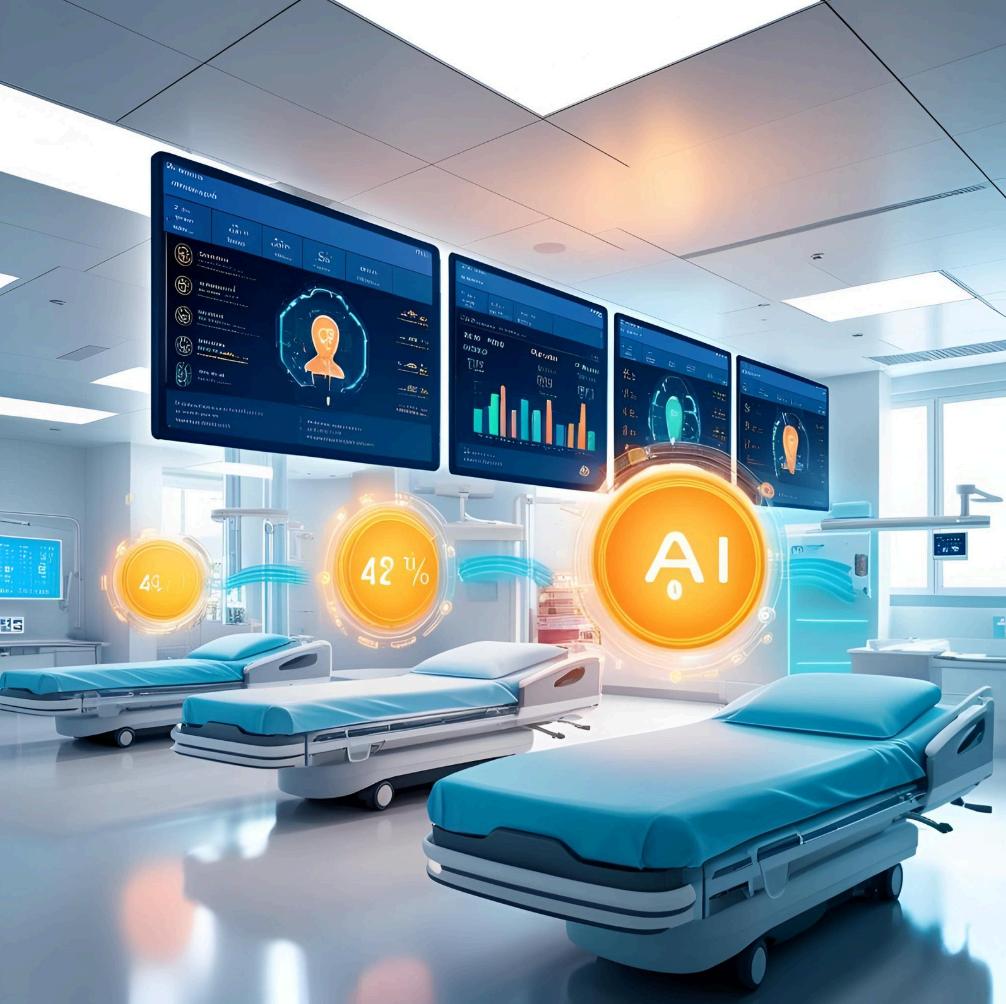
byBerniceHo
1.0Introduction
Ahealthcaresystemreferstoallinstitutions,organizations,andresourcesdedicatedtopromoting, sustaining,orrestoringhealththroughtheprovisionofservicesusinghuman,monetary,andphysical resources[1].Artificialintelligence(AI)istheabilityofadigitalcomputerorcomputer-controlledrobot toperformtaskscommonlyassociatedwithintelligentbeings[2].Inourmodernsociety,AI’sinfluence inhealthcareisgraduallyincreasing AIdemonstratessignificantpotentialinhealthcare,from improvingdiagnosticaccuracytostreamliningadministrativeprocesses[3].However,its implementationraisescriticalethicalandsocialconcernsregardingthefutureroleofhealthcare professionalsandthebalancebetweentechnologicaladvancementandhumanmedicalexpertise.
2.0EvolutionofAIinhealthcare
ThestartofAIdatesbacktothe1950swhenAlanTurningbroughtuphiseponymoustestbasedon theindistinguishabilityofverbalbehaviourasareplacementforthequestion“Canmachinesthink?” [4].Alanwasthefirsttoposesuchaquestion.In1956,theintroductionof“artificialintelligence”by JohnMcCarthy,markedthebirthofAI[5]
WiththeearlydevelopmentofAIhappeningbetweenthe1950sandthe1970s,thefirsteverindustrial mobilerobotcalled“Shakey”wascreatedattheStanfordResearchInstitute[6].Soon,throughearly effortsfocusedonthedevelopmentofdevices,anexperimentalcomputerprogramcalledInternist-I wascreated[7] Itcanmakemultiplecompleteinternalmedicinediagnosesthroughadiverse database.Then,in1986,TheUniversityofMassachusettsreleasedDXplainwiththesupportofthe AmericanMedicalAssociation DXplainisanevolvingcomputer-baseddiagnosticdecision-support systemdesignedforusebyphysicianswithnocomputerexpertise[8].Itcoversover2000diseases and5000clinicalmanifestations.DXplainsuggestspossiblediagnosesandprovidesbriefdescriptions ofeverydiseaseinthedatabase[9]
AsAItechnologycontinuedtoevolvethroughthedecades,asignificantmilestonewasreachedinthe 2000swhenIBMResearchundertookanambitiouschallengetobuildacomputersystemthatcan challengethebestplayersintheworldinthegameofJeopardy.In2011,Watson,anopen-domain question-answering(QA)system,beatthetwohighest-rankedplayersinanationallytelevisedtwogameJeopardymatch[10].AIWatsonwasthenusedtoidentifyRNA-bindingproteins(RBPs)that werealteredinALS(Amyotrophiclateralsclerosis) ItsievedthroughallRBPsinthegenomeand identifiednewRBPslinkedtoALS(ALS-RBPs).IBMWatsonextractedfeaturesfrompublished literaturetocreatesemanticsimilaritiesandidentifynewconnectionsbetweenentitiesofinterest. Sincethen,IBMWatsonanalyzedallpublishedabstractsofpreviouslyknownALS-RBPsandrankedall RMPsinthegenomebysemanticsimilaritytotheknownsetbyusingtext-basedknowledge successfullyidentifyingadditionalRBPsalteredinALS[11]
In2020,Google’sDeepmindcreatedanAIcalledAlphaFold.Itisanovelmachinewiththeabilityto predictthethree-dimensionalstructureofaproteinbasedsolelyonitsaminoacidsequence[12] With thestructurepredictioncomponentofthe“proteinfoldingproblem”beingakeyopenquestionfor halfadecadeandexistingmethodsfallingfarshortofatomicaccuracy,AlphaFoldwasatrue breakthroughforlarge-scalestructuralbioinformatics.Itnotonlyregularlypredictsproteinstructures withatomicaccuracy,butalsomaintainsitsaccuracyevenwhenthestructureisunknown.Thiswas proventhroughits14thCriticalAssessmentofProteinStructurePrediction
ItisalsoimportanttonotetheincreasingnumberofapprovedAImedicaldevicesbytheFDA[13]. Mostnotablyin2017,theFDAapprovedtheuseofclinicalcloud-baseddeeplearninginhealthcare [14].In2019,theFDAapprovedtheuseofpaige.ai,anartificialintelligencesystemforcancerdiagnosis [15].
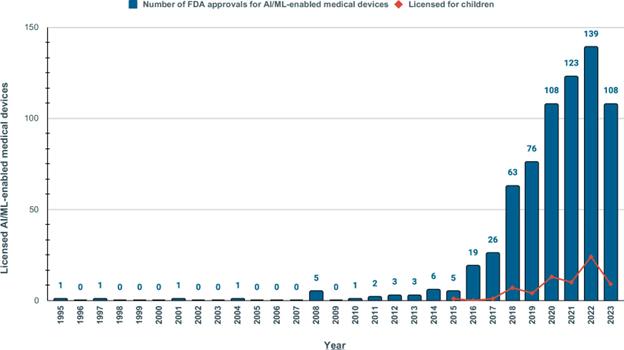
Figure1-ThebluebarshowsthenumberofAI-enabledmedicaldevicesapprovedbytheFDAfrom 1995to2023andtheredlineshowsthenumberofAI-enabledmedicaldevicesthatcanbeusedfor children.[Images,1]
3.0ApplicationsofAIinhealthcare
Buildinguponthishistoricalfoundation,theintegrationofAIhasfundamentallytransformedmultiple aspectsofmodernhealthcaredelivery,particularlyinkeyareassuchasdiagnosticsandpatientcare.
3.1AI-assistedendoscopy
Endoscopyisagoldstandardprocedureformanyholloworgans Itisusedmainlyfordisease surveillance,inflammationmonitoring,earlycancerdetection,tumorcharacterizationandresection procedures,minimallyinvasivetreatmentinterventionsandtherapeuticresponsemonitoring[16] However,endoscopicproceduresfrequentlyencounterchallengesduetoorganoverlapandvisual obstruction.Forinstance,bowelcleaningisneededbeforeimagingthecolon.Similarly,AI(i.e.deep learning)alsofaceschallengeswhendealingwithsceneclutterbecausenetworksmaybeconfusedas theyaretrainedwithcleanimages.Therefore,bystudyingtheaimsofdifferentendoscope acquisitionsabetterunderstandingofdeeplearningapplicationscanbereached
Aspecifictypeofendoscopecalledoesophago-gastro-duodenoscopy(OGD)involveslookingatthe upperpartofthegutwhichincludestheoesophagus(foodpipe),stomachandthefirstpartofyour smallbowel(duodenum)withanarrowflexibletubecalledagastroscope[17].Incontrast,colonoscopy screenlowerGIorgans,includingthecolonandrectum Recentdevelopmentsindeeplearningledto exponentialgrowthinbuildingcomputer-aideddetectionanddiagnosissystems,forinstance, applicationofAIinupperGIendoscopyforcanceridentificationaswellasHelicobacterpylori identification
ApplicationofAIinupperGIendoscopyhasbeeninvestigatedinthedetectionofoesophagealand gastriccanceraswellasHelicobacterpylori,abacterium[18].AIhasalsoplayedaroleinthedetection ofbarrettneoplasia(BEneoplasia),aconditioninwhichthecellsliningthelowerpartofthe esophagushavechangedorbeenreplacedwithabnormalcellsthatcouldleadtoesophagealcancer [19] SeveralstudieshaveevaluatedthediagnosticperformanceofCNNalgorithms,atypeofdeep learningalgorithmthatanalyzesandlearnsfeaturesfromlargeamountsofdataforBEneoplasia.For example,Hashimotoetal.developedanalgorithmbasedonCNNtechnologytoaidinthedetectionof Barrettneoplasiabydrawingoutareassuspectedofneoplasiaontheimage[20].Thealgorithmwas trainedwith916imagesof65BEpatientswithhistology-provenearlyesophagealneoplasia containinghigh-gradedysplasiaorT1cancer TheCNNthenanalyzed225imagesofdysplasticBEand 233ofnondysplasticBarrett’sesophagus(NDBE)imageswith95%accuracyandspecificityof94%. Thisclearlydemonstratesthealgorithmsaccuracyandprecision[21]
Moreover,AIhashelpedwiththedetectionofgastriccancer(GC).Helicobacterpylori(HP)infection cancausechronicatrophicgastritis(CAG)andgastricintestinalmetaplasia(GIM),bothofwhichare precancerousconditionsassociatedwithanincreasedriskofGCdevelopment.Byusingendoscopic surveillanceonpatientswithCAGandGIM,itallowsfortheearlydetectionofearlystagesofGC However,earlydiagnosisoftencomprisesofsubtlesignsthatcanbeeasilymissed;therefore,AIcan increaseaccuracy[22].InastudyconductedbyHoriuchietal.,theperformanceofmagnifying endoscopywithnarrow-bandimaging(ME-NBI)usingacomputer-aideddiagnosis(CAD)systemwas testedindiagnosingearlygastriccancer(EGC)[23].Atotalof1492cancerousand1078noncancerous imagesobtainedusingME-NBIwasusedtopretraintheCADsystem TheCADsystemachievedan accuracyof95%andaspecificityof82.8%whichisdeemedtobeequivalentorevenbetterthan expertsinthefieldofdiagnosingEGC,establishingitasausefultoolinclinicalpractice.Anotherstudy conductedbyZhengetal ,developedaCADsystemthatincorporatedtheCNNmodeltoevaluateHP infection.Atotalof15484endoscopicimagesof1959patientswereused,wherethemodel demonstratedahighaccuracyof92% [24]
Colonoscopiesaimtoidentifyandcharacteriseknowncancerprecursors,‘polyps’.Theapplicationof AIincolonoscopyhasbeenwidelysuccessful Forexample,Jinetal createdaCNNforevaluating diminutivecolorectalpolyps[25].TheCNNwastrainedwithimagesfrom1100adenomatouspolyps and1050hyperplasticpolypsfrom1379patients Whentestedwith300images,thesystemhadan accuracyof86.7%whilstexpertshadanaccuracyof82.5%.Thus,theCNNsystemisnotonlymore accuratebutalsomoreefficientthanendoscopists.AnothermethodofidentificationisYOLO-which wasdeemedtohaveanaccuracyof964%outofthesetof8641colonoscopyimages[26]
3.2SmartNursingManagement
Inanageingsocietywheremedicalcareisrapidlyincreasing,technologieshaveshowntohavethe abilitytotransformtheoperationsystemofnursingmanagement.Nursingmanagementisdefinedas anindividualresponsiblefortranslatinganorganization’sstrategy,managingresources,coordinating nursingcare,leadingnursingteams,planning,implementinginnovativepractices,andcontributingto theevaluationoftheservicesprovided[27].AIcanreduceadministrativeworkandimprovecontinuity andevolutionofcare[28]
WiththeaverageUSnursespending25%oftheirtimeonadministrativework,implementingAIwill significantlyreducetheirworkload[29].ThroughtheuseofRPA(RoboticProcessAutomation), administrativetaskscanbeautomated,maximizingefficiency[30] RPAalsohastheabilitytotakeover timeconsumingtasks,likeschedulingappointmentsandupdatingpatientrecords,allowingnursesto concentratemoreontasksthatrequirehumanexpertise.AwellimplementedRPAcanreducelabour andoperatearoundtheclock AleadingRPAplatformcalledUiPathwasusedinacasestudyinvolving theNHS(atrustthatmanagesover8000people),where8automationsand12robotswere successfullydeployedacrossthetrust[30] TheyhaveseenapositivechangewiththeuseofRPAand wishtocontinuetoworkwithUiPath.
AIandchatbotsopenupnewfoundopportunitiesfornursesastheybecomeintegratedintonurses’ dailypractices. OnesuchexampleisChatGPT,whichwaslaunchedonNovember30,2022.ChatGPT offersprofoundbenefits,forinstance,inclinicalpractice,ChatGPTcangeneratepatienteducation materials,notesfromstructureddataandtranslatelanguages.Italsohelpsnursesconductresearch [31].ChatGPTcanalsobeusedtosummarizelargeamountsoftextdata,answerspecificquestions andassistwithwritingbygeneratingcoherenttexts Arandomizedcontrolledtrialwasconductedwith theaimtocomparenurseswithchatbotsregardingtheeffectivenessofself-carebehaviorsinagroup ofwomenwithbreastcancer[32] Inthestudy,150womenwithbreastcancerwererandomlyselected andplacedinrandomgroupswith50ofthemintheChemoFreeBotgroup.TheChemoFreeBotisa toolaimstoimproveandincreaseself-carebehaviourthrougheducatingpatientswhichallowsthem toself-managetheirsymptoms TheyconcludedthatwomenintheChemoFreeBotgrouphadhigher effectiveself-carebehaviour.Therefore,ChemFreeBotcanbecomeaneffectivetooltoassistnursesas itallowspatientstotakeanactiveroleinmanagingtheirsymptoms
AIcanalsoimprovedecisionmakingwithinnursingmanagement.InastudyconductedbyChangetal., bibliometricanalysiswasusedtosearchforarticlesfrom1984and2022regardingAIanditsimpacts onnursingmanagement[33].AIisfoundtobenefitdecision-makingandhasthepotentialtohelpwith high-qualityresearch Specifically,inthecontextofemergencynursingmanagement,anintelligentzed nursingsystemisconstructedandintelligentauxiliarydiagnosis&treatmentinformationisprovided byLietalintheirstudy[34].Theterm“zed”iscommonlyusedtorefertozeroerrordelivery–a conceptthatiscrucialforhealthcaresystemduetotheprecisionthatisneededinthatfield By storingdatainformationthroughbarcodeintelligentinformation,itbecomesmoreconvenientfor nursestoaccess Thisallowsnursingmanagementtobemoreaccurateandefficient
Overall,aninterviewstudyconductedbyLaukkaetal.onnurseleaders'anddigitalservicedevelopers' perceptionsofthefutureroleofartificialintelligence(AI)inhealthcareshowedpositiveresponsesto AI[35].TheybelievethatAIwillworkbesidehumanity,reduceworkloadandstrengthenproactivedata management Thefulllistofbenefitsislisteddownbelowinatableform(separatedbymaincategory, categoryandsub-category):
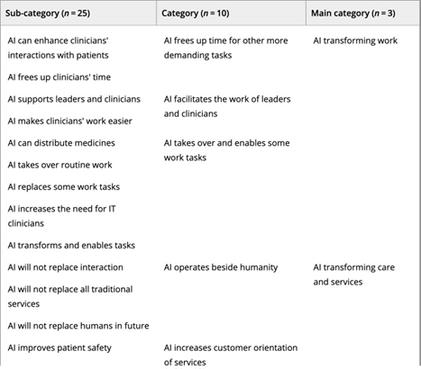
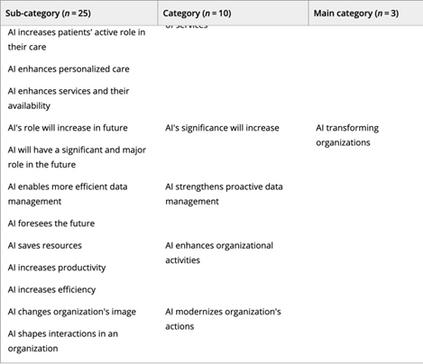
4.0ChallengesandLimitations
ItisevidentthatAIbringsalotofbenefits,includingincreasedaccuracyandprecisionofdiagnosisas wellasimprovingthenursingmanagementsysteminmanydifferentways However,therearestillmany limitationsanduncertaintiesthatcomewithusingAI.
Nowadays,manystudieshighlightthebenefitsandapplicationsofAIinendoscopy,forexample,Groof etal.’sstudy,butfailstocomparetheirarchitecturewithothers[37].Moreover,manypublishedstudies failtousecomprehensivemulti-centredata Thismeansthatonecanarguethedatasetsmaybe curatedandthereforedifferentfromreal-worldscenarios[38].Furthermore,mostAImodelsinupperGI endoscopyaredevelopedundertheconditionsofahigh-qualityimage,whichisoftennotthecasein clinicalpractice EventhoughpublishedstudiesoftenhighlightthedifferenceinperformanceofAIin comparisonofendoscopist,theexpertiseleveloftheendoscopistshavenotbeenmentioned.An examplewouldbethestudyconductedbyHoriuchietal ,wheretheysaidtheCADsystem’s performancewascomparedto11endoscopistexperts.Yet,thestudyneverspecifiedtheterm “experts”andquantifiedtheexperiencetheyhave.Therefore,moreresearchisneededforaclearer imageofthevaluethatAIaddstoendoscopy[39]
Lookingatthegrandschemeofthings,theuseofAIposeschallenges,includinglossofjobsandlogistic challenges.ADeloittecollaborationwiththeOxfordMartinInstitutesuggestedthat35%ofjobsinthe UKmaynotexistanymoreastheimpactofAIincreasesoverthenextonetotwodecades.Althoughat thispointoftime,jobsinhealthcare,e g nursing,havenotbeeneliminatedyet,otherjobsthatinvolve dealingwithdigitalinformation,likeradiologists,maynotexistinthefuture[40].However,ifit’sonly pertinenttonursing,researchshowsAIismorelikelygoingtoimproveapatient’sexperienceinsteadof replacingtraditionalservices[41].TheremayalsobechallengesinintegratingAIapplicationswith existingnursingmanagementinfrastructures,asdemonstratedthroughastudyconductedbyChanget al [41]
AliteraturereviewconductedbyChusteckiperfectlysummarisesthelimitationsofAI.Thereview concludesthatAIpresentsseveralconcerns,including(asquoted)“biasesingrainedinAIalgorithms,a lackoftransparencyindecision-making,potentialcompromisesofpatientdataprivacy,andsafety risks”[42].
Intermsofethicalimplications,therearequiteafewconcernstoaddress.Themostprominentoneis transparency Asitisnearlyimpossibletounderstandthedeeplearningalgorithms,doctorswouldbe unabletoexplaintoapatientabouthis/herdiagnosis.Thismeansthepatientmayfeelconfused, makingitevenmoredifficulttoaccepthis/herdiagnosis.
5.0Conclusion
TheintegrationofAIintohealthcarerepresentsatransformativeshiftinmedicalpractice,offering unprecedentedopportunitiesforimproveddiagnosis,treatment,andhealthcaremanagement However,successfulimplementationrequirescarefulconsiderationofethicalimplications,data privacyconcerns,andthemaintenanceofhuman-centeredcaretoensurethattechnological advancementservestoenhanceratherthancompromisethequalityofhealthcaredelivery
6.0Bibliography
[1]“HealthcareSystem-anOverview|ScienceDirectTopics.”Www.sciencedirect.com, www.sciencedirect.com/topics/nursing-and-health-professions/healthcare-system.
[2]Copeland,B.J.“ArtificialIntelligence.”EncyclopediaBritannica,8Jan.2025,www.britannica.com/ technology/artificial-intelligence
[3]Topol,EricJ.“High-PerformanceMedicine:TheConvergenceofHumanandArtificialIntelligence.” NatureMedicine,vol.25,no.1,Jan.2019,pp.44–56,www.nature.com/articles/s41591-018-0300-7.
[4]Shieber,StuartM.“TheTuringTestasInteractiveProof.”Nous,vol.41,no.4,Dec.2007,pp.686–713, https://doi.org/10.1111/j.1468-0068.2007.00636.x.
[5]Cordeschi,Roberto “AITurnsFifty:RevisitingItsOrigins”AppliedArtificialIntelligence,vol 21,no 4-5,25Apr.2007,pp.259–279,www.tandfonline.com/doi/full/10.1080/08839510701252304,https:// doi.org/10.1080/08839510701252304.
[6]Chawla,Suhani.“ADVANCEMENTofROBOTICSinHEALTHCARE.”InternationalJournalofSocial ScienceandEconomicResearch,vol.07,no.12,2022,pp.3936–3952,https://doi.org/10.46609/ ijsser2022v07i12006
[7]Miller,R.A.,etal.“Internist-1,anExperimentalComputer-BasedDiagnosticConsultantforGeneral InternalMedicine”TheNewEnglandJournalofMedicine,vol 307,no 8,19Aug 1982,pp 468–476, pubmed.ncbi.nlm.nih.gov/7048091/,https://doi.org/10.1056/NEJM198208193070803.
[8]Barnett,G.O.“DXplain.AnEvolvingDiagnosticDecision-SupportSystem.”JAMA:TheJournalofthe AmericanMedicalAssociation,vol 258,no 1,3July1987,pp 67–74,https://doiorg/101001/ jama.258.1.67.
[9]London,Sue “DXplainTM:AWeb-BasedDiagnosticDecisionSupportSystemforMedicalStudents” MedicalReferenceServicesQuarterly,vol.17,no.2,7May1998,pp.17–28,https://doi.org/10.1300/ j115v17n02 02.
[10]Ferrucci,D A “Introductionto“ThisIsWatson””IBMJournalofResearchandDevelopment,vol 56,no.3.4,May2012,pp.1:1–1:15,https://doi.org/10.1147/jrd.2012.2184356.
[11]Bakkar,Nadine,etal “ArtificialIntelligenceinNeurodegenerativeDiseaseResearch:UseofIBM WatsontoIdentifyAdditionalRNA-BindingProteinsAlteredinAmyotrophicLateralSclerosis.”Acta Neuropathologica,vol.135,no.2,13Nov.2017,pp.227–247,https://doi.org/10.1007/s00401-017-1785-8.
[12]Jumper,John,etal “HighlyAccurateProteinStructurePredictionwithAlphafold”Nature,vol 596, no.7873,15July2021,pp.583–589,https://doi.org/10.1038/s41586-021-03819-2.
[13]Muralidharan,Vijaytha,etal “AScopingReviewofReportingGapsinFDA-ApprovedAIMedical Devices.”NpjDigitalMedicine,vol.7,no.1,3Oct.2024,www.nature.com/articles/s41746-024-01270-x, https://doi.org/10.1038/s41746-024-01270-x.
[14]Marr,Bernard “FirstFDAApprovalforClinicalCloud-BasedDeepLearninginHealthcare”Forbes, www.forbes.com/sites/bernardmarr/2017/01/20/first-fda-approval-for-clinical-cloud-based-deeplearning-in-healthcare/
[15]Kelly,Susan.“AIToolforCancerDiagnosisWinsFDABreakthroughStatus.”MedTechDive,8Mar. 2019,www.medtechdive.com/news/ai-tool-for-cancer-diagnosis-wins-fda-breakthroughstatus/550058/ Accessed3Feb 2025
[16]Ali,Sharib.“WhereDoWeStandinAIforEndoscopicImageAnalysis?DecipheringGapsandFuture Directions”NpjDigitalMedicine,vol 5,no 1,20Dec 2022,https://doiorg/101038/ s41746-022-00733-3.
[17]“OesophagogastroDuodenoscopy(OGD)/Gastroscopy.”UnitedLincolnshireHospitals, wwwulh nhsuk/services/endoscopy/endoscopy-patient-information/oesophagogastroduodenoscopy-ogd-gastroscopy/.
[18]MeltemTokat,etal ArtificialIntelligenceinUpperGastrointestinalEndoscopy Vol 40,no 4,21 July2021,pp.395–408,https://doi.org/10.1159/000518232.Accessed5June2023.
[19]“NCIDictionaryofCancerTerms.”Cancer.gov,2025,www.cancer.gov/publications/dictionaries/ cancer-terms/def/barrett-esophagus.Accessed3Feb.2025.
[20]“ConvolutionalNeuralNetworks(CNN)andDeepLearning.”Intel,2020,www.intel.com/content/ www/us/en/internet-of-things/computer-vision/convolutional-neural-networkshtml
[21]Hashimoto,Rintaro,etal.“ArtificialIntelligenceUsingConvolutionalNeuralNetworksforReal-Time DetectionofEarlyEsophagealNeoplasiainBarrett’sEsophagus(withVideo).”Gastrointestinal Endoscopy,vol.91,no.6,1June2020,pp.1264-1271.e1,pubmed.ncbi.nlm.nih.gov/31930967/,https:// doi.org/10.1016/j.gie.2019.12.049.Accessed28Dec.2022.
[22]CORREA,Pelayo,andMBlancaPIAZUELO “TheGastricPrecancerousCascade”Journalof DigestiveDiseases,vol.13,no.1,21Dec.2011,pp.2–9,https://doi.org/10.1111/ j.1751-2980.2011.00550.x.
[23]Horiuchi,Yusuke,etal.“PerformanceofaComputer-AidedDiagnosisSysteminDiagnosingEarly GastricCancerUsingMagnifyingEndoscopyVideoswithNarrow-BandImaging(withVideos).” GastrointestinalEndoscopy,vol 92,no 4,1Oct 2020,pp 856-865e1, pubmed.ncbi.nlm.nih.gov/32422155/,https://doi.org/10.1016/j.gie.2020.04.079.Accessed29June 2023.
[24]Zheng,Wenfang,etal.“HighAccuracyofConvolutionalNeuralNetworkforEvaluationof HelicobacterPyloriInfectionBasedonEndoscopicImages:PreliminaryExperience.”Clinicaland TranslationalGastroenterology,vol 10,no 12,11Dec 2019,p e00109,wwwncbi nlm nih gov/pmc/ articles/PMC6970551/,https://doi.org/10.14309/ctg.0000000000000109.Accessed7Dec.2021. [25]Jin,EunHyo,etal “ImprovedAccuracyinOpticalDiagnosisofColorectalPolypsUsing ConvolutionalNeuralNetworkswithVisualExplanations.”Gastroenterology,vol.158,no.8,June2020, pp.2169-2179.e8,https://doi.org/10.1053/j.gastro.2020.02.036.Accessed6Oct.2021. Urban,Gregor,etal “DeepLearningLocalizesandIdentifiesPolypsinRealTimewith96%Accuracyin ScreeningColonoscopy.”Gastroenterology,vol.155,no.4,Oct.2018,pp.1069-1078.e8,https:// doiorg/101053/j gastro 201806037 Accessed20Nov 2020
[26]González‐García,Alberto,etal.“NurseManagersCompetencies:AScopingReview.”Journalof NursingManagement,vol 29,no 6,21May2021,pp 1410–1419,https://doiorg/101111/jonm 13380
[27]Hwang,Gwo-Jen,etal.“ResearchTrendsinArtificialIntelligence-AssociatedNursingActivities BasedonaReviewofAcademicStudiesPublishedfrom2001to2020.”CIN:Computers,Informatics, Nursing,vol 40,no 12,16Mar 2022,pp 814–824,https://doiorg/101097/cin0000000000000897 Accessed5Feb.2024.
[28]“GoogleScholar”Googlecom,2025,scholargooglecom/scholar lookup? title=Nurses%20say%20distractions%20cut%20bedside%20time%20by%2025&publication year=20 10&author=J.%20Commins.Accessed3Feb.2025.
[29]Durgampudi,Kali “DrivingEfficiencyinHealthcare:ThePowerofRoboticProcessAutomation” Forbes,10Apr.2024,www.forbes.com/councils/forbestechcouncil/2024/04/10/driving-efficiency-inhealthcare-the-power-of-robotic-process-automation/
[30]UiPathInc.“CliniciansinNorthWestLondonBenefitfromAutomation|UiPath.”Uipath.com,2025, www.uipath.com/resources/automation-case-studies/automation-saves-time-for-clinicians-in-northwest-london Accessed3Feb 2025
[31]Moons,Philip,andLiesbetVanBulck.“ChatGPT:CanArtificialIntelligenceLanguageModelsBeof ValueforCardiovascularNursesandAlliedHealthProfessionals”EuropeanJournalofCardiovascular Nursing,8Feb.2023,https://doi.org/10.1093/eurjcn/zvad022.
[32]Tawfik,Elham,etal.“ANurseversusaChatbot‒theEffectofanEmpowermentProgramon Chemotherapy-RelatedSideEffectsandtheSelf-CareBehaviorsofWomenLivingwithBreastCancer: ARandomizedControlledTrial.”BMCNursing,vol.22,no.1,6Apr.2023,https://doi.org/10.1186/ s12912-023-01243-7
[33]Chang,Ching‐Yi,etal.“TrendsinArtificialIntelligenceinNursing:ImpactsonNursing Management.”JournalofNursingManagement,vol.30,no.8,25Aug.2022,https://doi.org/10.1111/ jonm 13770
[34]Li,Qing,andYujieChen.“ApplicationofIntelligentNursingInformationSysteminEmergency NursingManagement”JournalofHealthcareEngineering,vol 2021,4Aug 2021,pp 1–13,https:// doi.org/10.1155/2021/3998830.
[35]Laukka,Elina,etal.“NurseLeaders’andDigitalServiceDevelopers’PerceptionsoftheFutureRole ofArtificialIntelligenceinSpecializedMedicalCare:AnInterviewStudy”JournalofNursing Management,vol.30,no.8,21Aug.2022,https://doi.org/10.1111/jonm.13769.
[36]Gong,Julia,etal “UsingDeepLearningtoIdentifytheRecurrentLaryngealNerveduring Thyroidectomy.”ScientificReports,vol.11,no.1,12July2021,p.14306,www.nature.com/articles/ s41598-021-93202-y,https://doi.org/10.1038/s41598-021-93202-y.Accessed5Oct.2023.
[37]Ali,Sharib “WhereDoWeStandinAIforEndoscopicImageAnalysis?DecipheringGapsand FutureDirections.”NpjDigitalMedicine,vol.5,no.1,20Dec.2022,https://doi.org/10.1038/ s41746-022-00733-3 Accessed16Mar 2023
[38]Horiuchi,Yusuke,etal.“PerformanceofaComputer-AidedDiagnosisSysteminDiagnosingEarly GastricCancerUsingMagnifyingEndoscopyVideoswithNarrow-BandImaging(withVideos).” GastrointestinalEndoscopy,vol 92,no 4,1Oct 2020,pp 856-865e1, pubmed.ncbi.nlm.nih.gov/32422155/,https://doi.org/10.1016/j.gie.2020.04.079.
[39]McKinsey AFUTURETHATWORKS:AUTOMATION,EMPLOYMENT,andPRODUCTIVITY Jan 2017
[40]Chen,Mei,andMichelDecary.“ArtificialIntelligenceinHealthcare:AnEssentialGuideforHealth Leaders.”HealthcareManagementForum,vol.33,no.1,24Sept.2020,pp.10–18, journalssagepubcom/doi/pdf/101177/0840470419873123,https:// doi.org/10.1177/0840470419873123.
[41]Chang,Ching‐Yi,etal.“TrendsinArtificialIntelligenceinNursing:ImpactsonNursing Management.”JournalofNursingManagement,vol.30,no.8,25Aug.2022,https://doi.org/10.1111/ jonm 13770
[42]Chustecki,Margaret.“BenefitsandRisksofAIinHealthCare:NarrativeReview.”InteractiveJournal ofMedicalResearch,vol 13,18Nov 2024,pp e53616–e53616,i-jmrorg/2024/1/e53616,https:// doi.org/10.2196/53616.
Image:
[1]Muralidharan,Vijaytha,etal.“AScopingReviewofReportingGapsinFDA-ApprovedAIMedical Devices”NpjDigitalMedicine,vol 7,no 1,3Oct 2024,wwwnaturecom/articles/s41746-024-01270-x, https://doi.org/10.1038/s41746-024-01270-x.
[2]Laukka,Elina,etal.“NurseLeaders’andDigitalServiceDevelopers’PerceptionsoftheFutureRole ofArtificialIntelligenceinSpecializedMedicalCare:AnInterviewStudy.”JournalofNursing Management,vol.30,no.8,21Aug.2022,https://doi.org/10.1111/jonm.13769.
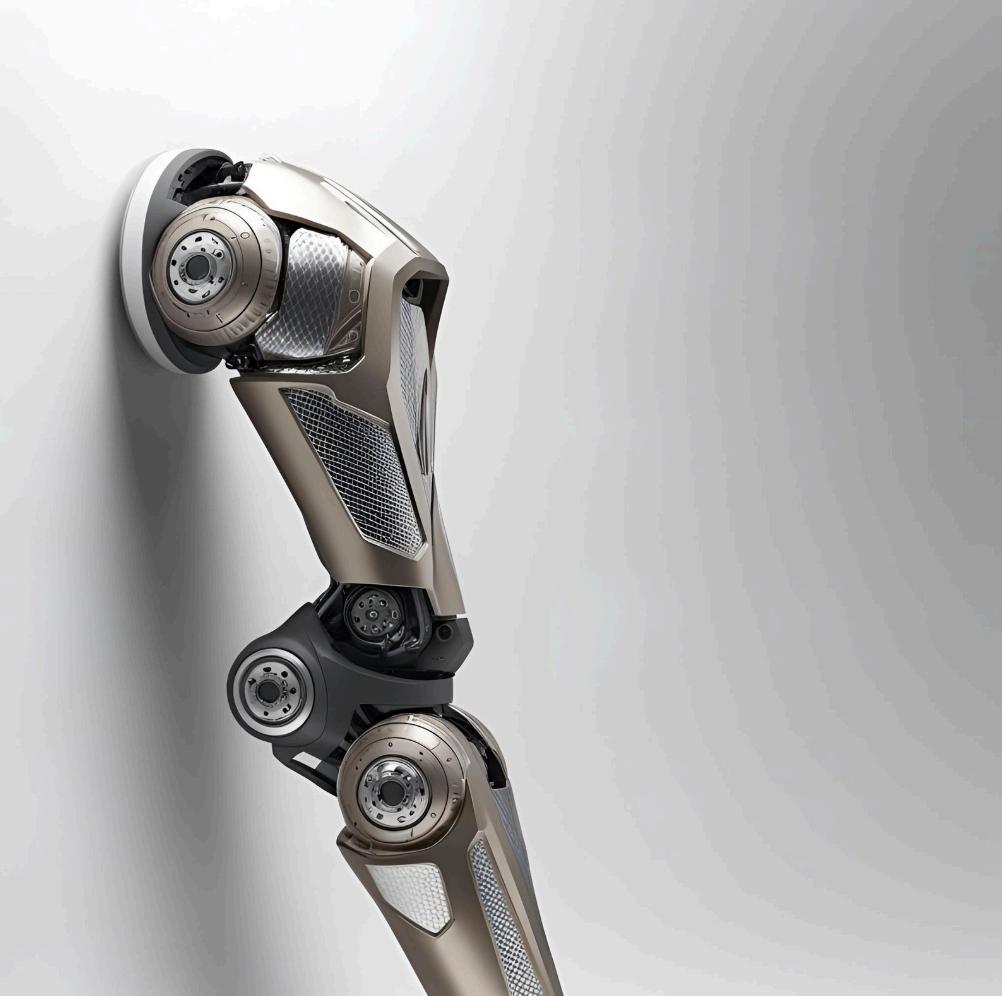
Howcanbiomimicry influencerobotics?
by Sean Wu
1.0Howcanbiomimicryinfluencerobotics?
Biomimicryreferstotheimitationofaspectsofthenaturalworldinartificialdesigns[1].Thiscovers disciplinesfromarchitecture,urbanengineeringandmedicalstudiestorobotics,whichwillbethe focusofthisarticle.Roboticsisoneofthebestareastoapplybiomimicrybecauserobotsusually requireahighdegreeofmobility,flexibilityandefficiency,whichnaturalsystemsexcelat
2.0Locusts
Jumpingrobotscanbeusedinsearchandrescuetotraversedistancesthatawheeledorlegged machinecannot.Oneexampleisalocust-inspiredjumpingrobotdevelopedinTelAvivUniversity [Figure1].Itworksbystoringenergyinatorsionalspringandreleasingitallatonce,mimickingthe processinalocust’sbacklegs[2] Thisallowsittojump335metresinheight,whileonlyweighing23 grams.Inalocust,jumpingtakesplaceinthreestages[3].Inthefirststage,thelocustlocksitsbacklegs inplace Inthesecondstage,thelocustslowlycontractsitslegmuscles,stretchingthespecially designedstructuresinitslegs.Inthethirdstage,thelegsunlock,releasingallthestoredelasticenergy inthelegstructures.Thisquicklypropelsthelocustatahighspeedwithoutrequiringlargemuscles, whichallowsittobeverylightweightandefficient
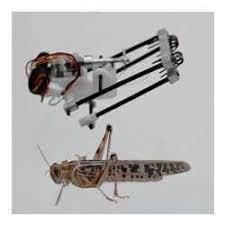
Figure1-Ajumpingsearchandrescuerobotinspiredbyalocust (Photo:Prof AmirAyali)
3.0StarfishandGeckos
ThisisanamphibiouscrawlerrobotfromCarnegieMellonUniversitythatusesstarfishlocomotionand adhesivesurfacesinspiredbygeckofeet[Figure2].Thisallowsittosticktowetanddrysurfacesofup to51°andcrawlonsurfacesupto25°[4] Itusessoftpneumaticactuatorstoextendandretractthe legswhileaseparatepneumaticsysteminflatesanddeflatestheexpandablegeckopatchonitslimbs. GeckofeetsticktowallsusingsmallattractiveforcesbetweenmoleculescalledVanderWaalsforces [8].Geckofeettakeadvantageofthisforcetoadheretosurfacesbygreatlyincreasingthesurfacearea usingmillionsofmicroscopichairscalledsetae.Therobotsimilarlyincreasesthesurfaceareausingan unevenpatchcoveredinmicrostructuressimilarinfunctiontothesetaethatexpandsandcontracts usingairpressure.Thisallowstherobottopullitselfinthedirectionitneedstogo.
Thisissimilartothemotionofastarfish,whichalsousesanadhesivesurfaceinitstubefeetoneach ‘arm’topullitselfaround[5].Thisrobotcanbeusedfordatacollectiononshorelinesthataretoo dangerousforpeople.
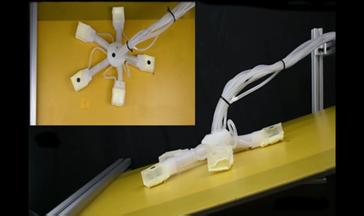
4.0GiantClams
Giantclamshaveoneofthemosteffectivemethodsofphotosynthesis.Ittakesinupto67%ofthe energyprovidedbysunlightusingverticalalgaecolumnsonitssurface[6].Thisisespeciallyhighwhen comparedtosolarpanels,whichonlytakeinupto23%inthemostefficienttypes Cellscalled iridocytesscatterlighthorizontallyandthecolumnschangeshapesotheyareuniformlyilluminated sothateachcellcanabsorbthemaximumamountoflight Thiscanbeusedinnewsolarpanelsto minimisetheimpactofunevenheatingcausinghotspots,whichcandegradesolarpanels,causing themtoreduceinefficiency[9].
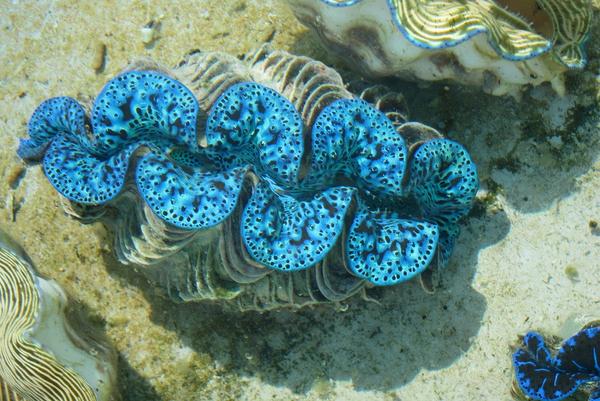
Figure3–Giantclam,wherelight-scatteringpropertiesoftheiridocytesareclearlyvisible (Photo:DanMorse)
5.0Ostriches
BirdBotisarobotwalkerinspiredbythelegsofanostrich[Figure4][7].Itusesstringsattachedto springsandmotorsthatmimicanostrich’stendons Thisallowsthemotorstobeplacedonthebody ratherthanontheleg,meaningthelegdoesnotneedtomovewiththeweightofthemotor.This makesthelegscanbelighterandmovefaster Anotherfeatureoftherobotisthatthestringsstretch fromthebodyoftherobottothefoot,allowingtherobottohavemorecompactlegsandstand withouttheuseofthemotors.Thelightweightstructureofthelegandtheabilitytostandwithout motorsmakestherobotmoreefficientthanotherwalkers
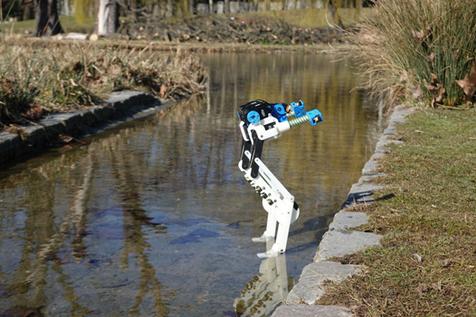
Figure4-BirdBotcanstandstillwithoutusingasmuchenergybecauseofthesprings Itcanalso standinwaterbecausethemotorsareoutoftheway.(Photo:DynamicLocomotionGroupat MPI-IS)
6.0Conclusion
Currently,thefieldofbiomimeticroboticsisunderdeveloped.Applicationstodayaremostlyusedto demonstrateprototypesforfutureimprovement,whiletherobotsthemselvesremainimpractical. Themainchallengefacingbiomimicryistheneedformultiplefieldsofstudy,whichincludeanatomy, mechanicalandelectricalengineering,cellularbiologyandmaterialsscience.Asresearchcontinues, biomimicrymaybecomeitsownfieldofstudyandcouldbeasourceofinspirationformoreeffective designs.
7.0Bibliography
[1]Aziz,M S ,&Elsherif,A Y (2016) Biomimicryasanapproachforbio-inspiredstructurewiththeaid ofcomputation.AlexandriaEngineeringJournal,55(1),707–714.https://doi.org/10.1016/ j aej 201510015
[2]Zaitsev,V.,Gvirsman,O.,BenHanan,U.,Weiss,A.,Ayali,A.,&Kosa,G.(2015).Alocust-inspired miniaturejumpingrobot.Bioinspiration&Biomimetics,10(6),066012.https:// doiorg/101088/1748-3190/10/6/066012
[3]Goode,C.K.,&Sutton,G.P.(2023).Controlofhigh-speedjumps:therotationandenergeticsofthe locust(Schistocercagregaria) JournalofComparativePhysiologyB-BiochemicalSystemicand EnvironmentalPhysiology.https://doi.org/10.1007/s00360-022-01471-4
[4]Acharya,S.,Roberts,P.,Rane,T.,Singhal,R.,Hong,P.,Ranade,V.,Majidi,C.,Webster-Wood,V.,&B. Reeja-Jayan (2023) Geckoadhesionbasedseastarcrawlerrobot FrontiersinRoboticsandAI,10 https://doi.org/10.3389/frobt.2023.1209202
[5]Heydari,S.,Johnson,A.,Ellers,O.,McHenry,M.J.,&Kanso,E.(2020).Seastarinspiredcrawlingand bouncing JournaloftheRoyalSocietyInterface,17(162),20190700 https://doiorg/101098/ rsif.2019.0700
[6]Holt,A.L.,Rehm,L.F.,&Sweeney,A.M.(2024).SimpleMechanismforOptimalLight-UseEfficiency ofPhotosynthesisInspiredbyGiantClams PRXEnergy,3(2) https://doiorg/101103/ prxenergy.3.023014
[7]Birdbotdemonstratesgreaterefficiencies-ASME (2022) Asmeorg https://wwwasmeorg/topicsresources/content/bipedal-robot-mimics-birds-gait https://doi.org/10.1007/s00360-022-01471-4
[8]Stepan,L (2020) BeingaGeckoisStickyBusiness!-AmericanChemicalSociety American ChemicalSociety.https://www.acs.org/education/celebrating-chemistry-editions/2020-ncw/ geckohtml
[9]Deng,S.,Zhang,Z.,Ju,C.,Dong,J.,Xia,Z.,Yan,X.,Xu,T.,&Xing,G.(2017).Researchonhotspotrisk forhigh-efficiencysolarmodule.EnergyProcedia,130,77–86.https://doi.org/10.1016/ jegypro 201709399

